Introduction
In the realm of data analysis, DAX Studio emerges as a game-changer for professionals seeking to streamline their Power BI workflows and elevate their analytical capabilities. This powerful tool not only simplifies the process of writing and executing DAX queries but also empowers users to tackle common challenges such as time-consuming report generation and data inconsistencies.
By leveraging DAX Studio, organizations can unlock valuable insights, optimize their data models, and enhance operational efficiency. Whether it’s connecting to Power BI, executing queries, or troubleshooting issues, DAX Studio provides practical solutions that pave the way for informed decision-making and strategic growth.
As the demand for data-driven insights continues to rise, understanding and utilizing DAX Studio becomes essential for those looking to thrive in a data-rich environment.
Introduction to DAX Studio: What You Need to Know
The Power BI DAX Studio serves as a vital instrument for anyone looking to enhance their analysis and modeling, which is essential for revealing insights that promote business growth. Its intuitive interface simplifies the process of writing and executing DAX commands in PowerBI DAX Studio, allowing users to conduct thorough analyses and effectively optimize their Power BI models. For example, a sample request in DAX view displays the top 100 rows of the Store table, illustrating how DAX Studio enables rapid exploration of information and tackles frequent issues like lengthy report generation and discrepancies in information.
As the formula language essential to Power BI, understanding Power BI DAX Studio is pivotal for leveraging the full potential of your information. The Statistics Column Batch Size option further enhances efficiency by allowing users to set the number of columns scanned in a single query, ensuring optimal performance for large models. DAX not only enhances your analytical capabilities but also streamlines workflows for more efficient data handling, aligning with the goals of operational efficiency.
By automating repetitive tasks, PowerBI DAX Studio contributes to improved employee morale, freeing up time for more strategic initiatives. Experts like Zoe Douglas, a Product Manager, affirm this utility, stating,
So, there you have it, a quick tutorial on how you can get started using the DAX query view!
Moreover, the powerful filtering functions in DAX, such as FILTER, ALL, and CALCULATE, provide granular control over analysis, as illustrated in a case study that filters sales information for the year 2023.
By familiarizing yourself with DAX’s functionalities, including its automation capabilities, you position yourself to gain deeper insights and achieve proficiency in analysis, ultimately paving the way for informed decision-making and enhanced operational efficiency.
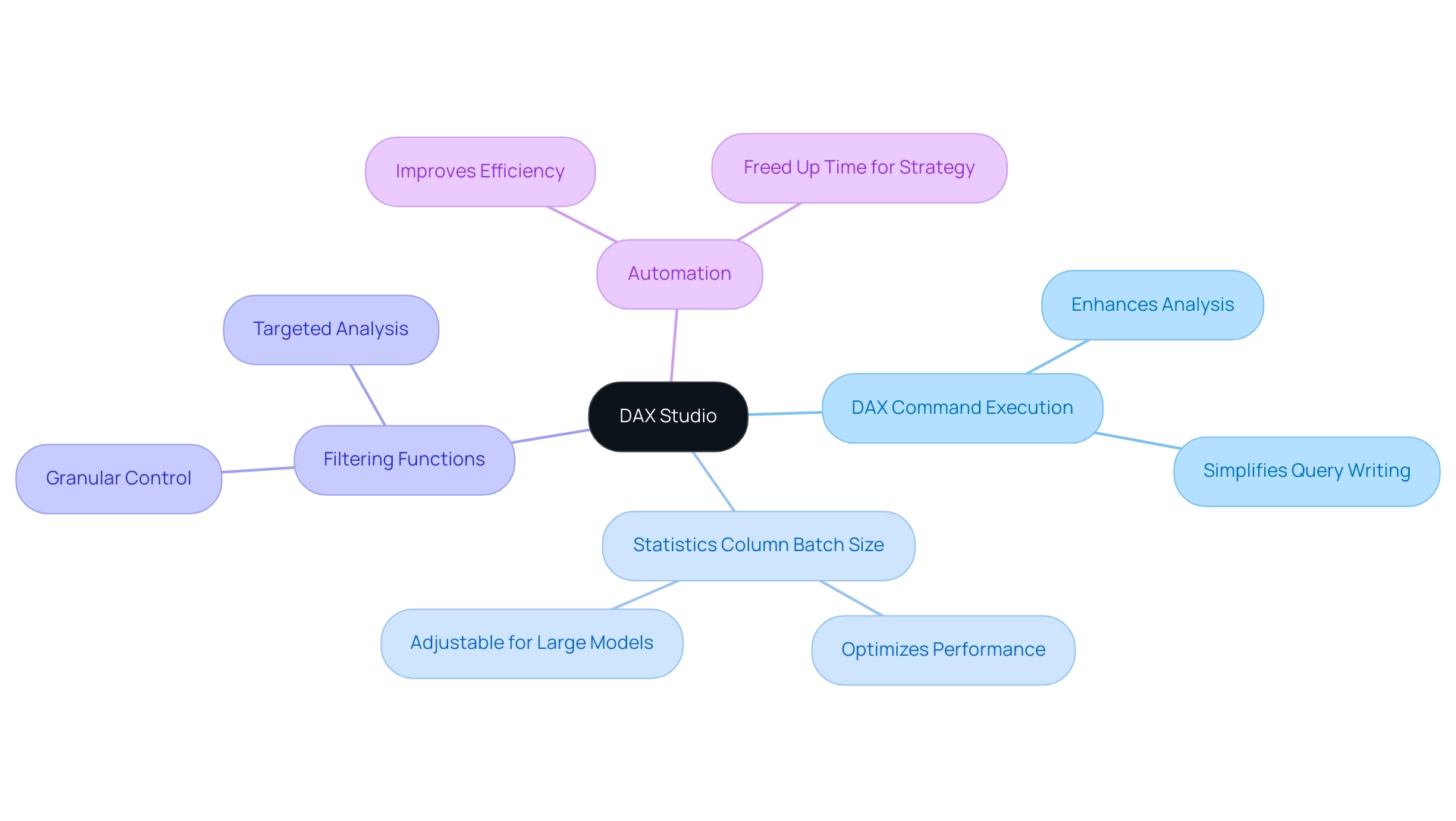
Connecting DAX Studio to Power BI: A Step-by-Step Guide
Linking DAX application to Power BI is an uncomplicated procedure that enables you to utilize the full capability of your analytics, crucial for enhancing operational efficiency and employing Business Intelligence to convert raw information into actionable insights. Follow these steps to establish a successful connection:
- Open Power BI Desktop: Launch the Power BI Desktop application on your computer to begin.
- Load Your Data Model: Ensure your data model is fully loaded and prepared for analysis, ready to drive insights amidst the complexities of data inconsistencies.
- Open DAX Application: Start DAX Application on your computer. This free open-source tool enhances your ability to write, execute, and analyze DAX commands effectively, addressing the time-consuming report creation challenge.
- Connect to Power BI: In DAX Application, locate and click on the ‘Connect’ button in the toolbar. Select ‘Power BI’ from the available connection options.
- Select Your Model: From the list that appears, choose the appropriate Power BI model you wish to analyze.
- Establish Connection: Click ‘Connect’ to finalize the link. A confirmation message will show up, signaling that your connection has been successfully set up.
With the connection set up, you are now ready to execute DAX commands and perform thorough analysis. The DAX Studio user interface, as described in the case study titled ‘DAX Studio UI Basics,’ features a query editor, results grid, charting pane, and information grid, offering an excellent environment for exploring your information effectively. Remember, as Raj Verma suggests, utilizing the default ‘All Users’ install option in your applications will provide the richest user experience, further enhancing your efficiency in analysis.
Moreover, think about employing RPA solutions alongside tools such as Hevo, which provides a 14-day free trial, to simplify your processes and further improve your analysis capabilities, ensuring your business stays competitive in today’s information-rich environment.
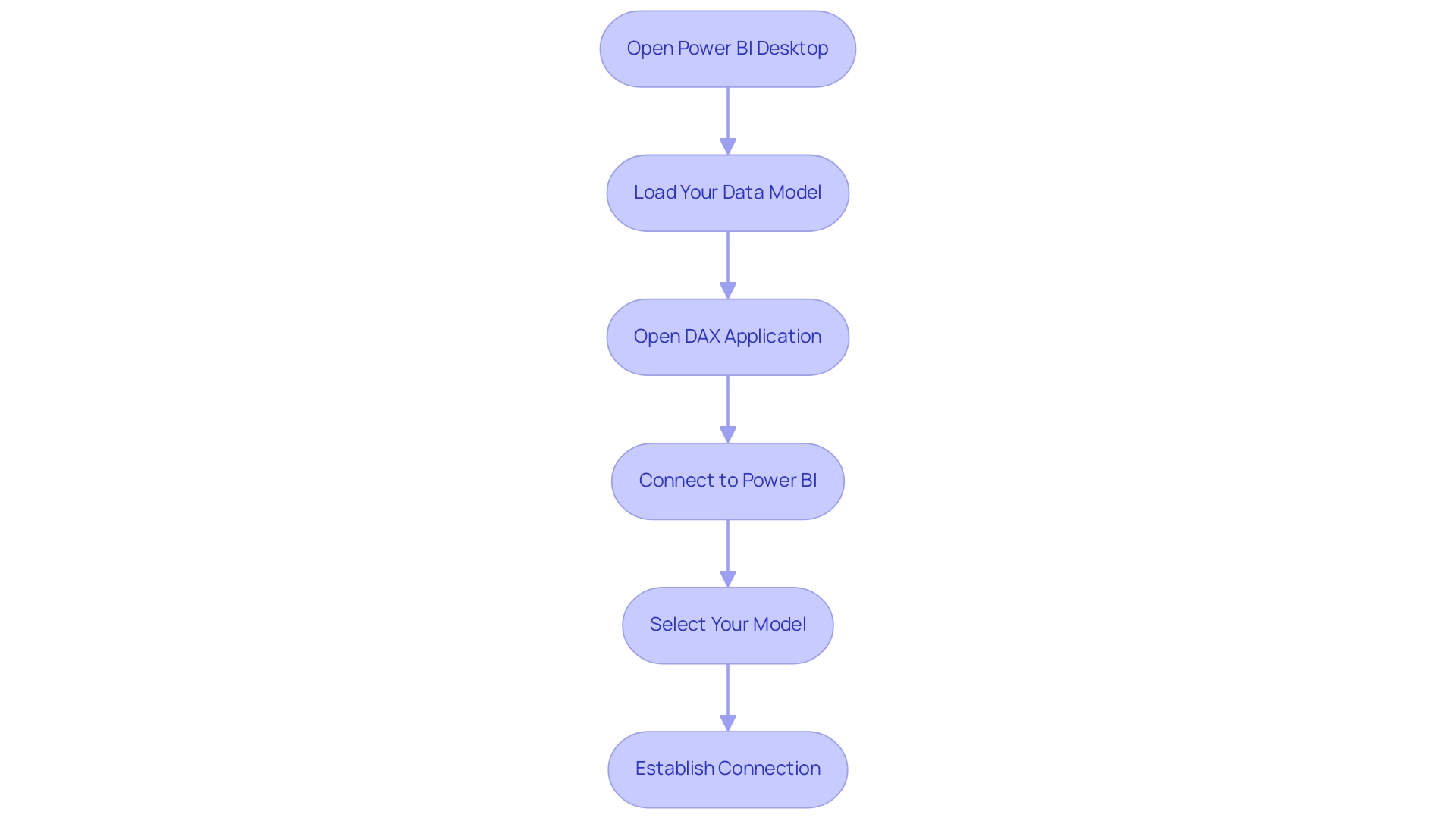
Executing Queries and Analyzing Data with DAX Studio
Executing DAX commands in Power BI DAX Studio is a simple process that enhances your ability to analyze data efficiently and generate actionable insights for your organization. Follow these steps to get started:
- Open a New Query: Begin by clicking the ‘New Query’ button in PowerBI DAX Studio to set up your workspace for a fresh analysis.
- Write Your DAX Statement: In the Power BI DAX Studio editor, input your DAX statement. For instance, to calculate total sales, you would enter:
DAX
Total Sales = SUM(Sales[Amount])
- Execute the request: Once your request is prepared, simply click the ‘Run’ button. The results will be displayed in the results pane below, allowing you to see immediate outputs that contribute to data-driven decision-making.
- Analyze the Results: Take the time to review the output carefully. This is where insights are uncovered that can inform your strategy. If required, you can export the results to Excel or CSV for more extensive analysis.
This practical method not only enables you to handle your information directly but also allows you to see the immediate effect of your requests on operational efficiency with Power BI DAX Studio. As lbendlin pointed out, “Don’t need DAX Studio for that – run your requests in your tool of preference – Visual Studio Code, SSMS, Powershell etc.” and use their timing features.
Don’t forget to clear the cache. This emphasizes the flexibility in executing DAX queries and the importance of addressing challenges such as time-consuming report generation and inconsistencies.
Moreover, recent optimization efforts have shown that ensuring code cleanliness and simplifying logic can lead to substantial performance improvements. For instance, a case study titled “Conclusion: DAX Performance Tuning” revealed that the final DAX code ran 30 times faster than the original, reinforcing the benefits of these practices. By applying these principles, you can significantly enhance your analysis capabilities and leverage BI and RPA to transform your operations.
Key features of our RPA solutions, such as EMMA RPA and Power Automate, further support this transformation by automating repetitive tasks, improving efficiency, and boosting employee morale. Remember, the early bird discount ends on December 31, so take advantage of the resources available to improve your DAX skills.

Optimizing Your Power BI Models Using DAX Studio
To effectively optimize your Power BI models with DAX tools and overcome common challenges such as time-consuming report creation, data inconsistencies, and lack of actionable guidance, consider the following strategies:
-
Analyze Execution Performance: Utilize the ‘Server Timings’ feature in PowerBI DAX Studio to monitor the execution time of your commands. This real-time analysis assists in identifying slow-performing requests that may hinder your report generation, enabling you to concentrate your optimization efforts where they are needed most. Additionally, use the Performance Analyzer in Power BI to measure the processing time required to update report elements based on user interactions, logging actions in real-time to identify performance bottlenecks.
-
Review DAX Plans: Examine your plans to pinpoint bottlenecks in your calculations. Understanding how your DAX expressions are processed in Power BI DAX Studio will empower you to make informed adjustments that can enhance performance and reduce the time spent on report creation. This process also aligns with establishing a governance strategy to ensure consistency across your reports.
-
Refactor Inefficient Queries: Simplifying complex DAX expressions can significantly improve performance. For instance, replacing intricate nested calculations with simpler measures can lead to faster processing times and help ensure consistency across your reports.
-
Use Variables: Implementing variables in your DAX queries to store intermediate results will streamline calculations and enhance performance, making it easier to deliver clear and actionable insights without overwhelming stakeholders with excessive information. This approach directly addresses the need for actionable guidance in your reports.
-
Reduce Volume: Load only the necessary information into your model to enhance both performance and efficiency in analysis. This will also help mitigate inconsistencies in your reports, ensuring that stakeholders receive accurate and reliable information.
-
Export Performance Information: Utilize the Export button to save performance information as a .json file, allowing for further analysis and necessary adjustments. This step can assist you in recognizing recurring issues in report creation and information presentation.
By implementing these optimization techniques, you can enhance the performance of your Power BI models and tackle the core challenges of report creation with Power BI DAX Studio. As Marco Russo enthusiastically notes, “Better yet, we can download this into Excel and everything gets broken down for you all the way to your relationships and measures… AMAZING!” Moreover, users can download metrics from Vertipaq Analyzer into Excel, providing a detailed breakdown that drives operational efficiency.
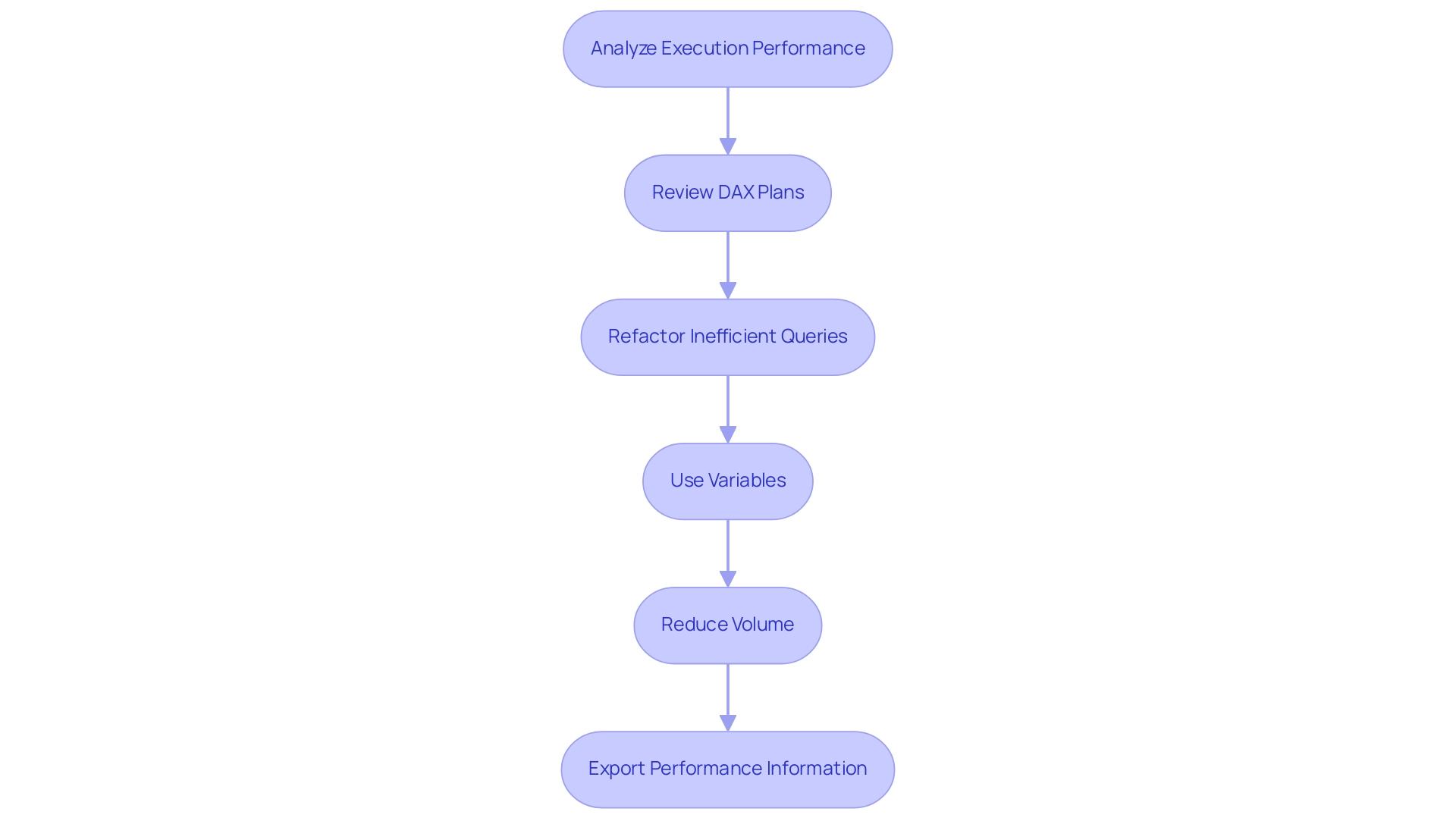
Troubleshooting and Best Practices for DAX Studio Users
To enhance your experience with DAX and effectively tackle common issues, consider the following troubleshooting tips and best practices:
- Check Your Connections: Ensure that Power BI DAX Studio is properly connected by confirming that Power BI is running and your model has fully loaded.
- Validate DAX Syntax: Regularly review your DAX expressions for syntax errors. Utilize the ‘Error List’ panel to quickly pinpoint and rectify these issues.
- Utilize the Editor: Leverage the robust features of the editor to format and organize your requests, enhancing both readability and efficiency, which is crucial for overcoming manual, repetitive tasks that slow down operations.
- Regularly Save Your Work: To prevent data loss from unexpected issues, make it a habit to save your requests frequently. This simple practice can save you time and frustration.
- Stay Updated: Keep both DAX and Power BI up to date. This ensures you leverage the latest enhancements and features, significantly improving performance.
- Master Plans: Understanding execution plans is crucial for optimizing DAX performance. Learning how to analyze them can help you identify potential bottlenecks and improve efficiency.
- Learn from Others: Engage with the DAX community to share experiences and solutions. For instance, Damian M. Jaworski highlighted a practical fix in PowerBI DAX Studio by adjusting timeout settings to enhance performance, demonstrating how community insights can lead to effective resolutions. He noted,
‘In Options–>Timeouts you can modify the times for Server Timings End Event Timeout and Trace Startup Timeout. Once I’ve increased it from original 30 seconds to 90, I can collect statistics on longer running queries.’ This emphasizes the importance of community knowledge in troubleshooting. - Consider Advanced Techniques: When basic troubleshooting steps are insufficient, explore advanced troubleshooting techniques. As outlined in a case study on advanced troubleshooting, experienced users often rely on these methods to effectively address more complex problems in Power BI.
Additionally, consider integrating Robotic Process Automation (RPA) into your workflows. RPA can streamline repetitive tasks related to management, allowing your team to concentrate on more strategic analysis. Tailored AI solutions can also enhance your ability to derive insights from your data, ensuring your strategies are aligned with your business goals.
By implementing these best practices, you will not only enhance your DAX Studio experience but also boost your proficiency in data analysis. This equips you to handle challenges with confidence, ultimately driving informed decision-making and operational efficiency in your organization.

Conclusion
DAX Studio is a transformative tool that empowers users to enhance their data analysis and modeling capabilities within Power BI. Through its intuitive interface, professionals can streamline the writing and execution of DAX queries, significantly reducing the time spent on report generation and addressing data inconsistencies. By adopting best practices such as:
- Optimizing query performance
- Utilizing variables
- Simplifying complex DAX expressions
organizations can unlock deeper insights and improve operational efficiency.
Establishing a robust connection between DAX Studio and Power BI is crucial for harnessing the full potential of data analysis. Following a straightforward connection process allows users to execute queries with ease, enabling them to derive actionable insights that drive strategic decision-making. Furthermore, by leveraging automation techniques and troubleshooting best practices, teams can overcome common challenges and enhance their analytical workflows.
Ultimately, mastering DAX Studio is essential for those looking to thrive in a data-driven landscape. By committing to continuous learning and embracing the functionalities of this powerful tool, organizations can transform their data management processes, foster informed decision-making, and position themselves for sustainable growth in today’s competitive environment.
Introduction
In a world where data reigns supreme, Power BI emerges as a transformative business analytics tool that empowers organizations to harness the potential of their data. Designed by Microsoft, this platform facilitates the visualization and sharing of insights, enabling teams to make informed, data-driven decisions swiftly.
With features like rapid report creation and enhanced data connectivity, Power BI not only streamlines workflows but also significantly boosts productivity. As businesses navigate the complexities of operational efficiency and scalability, understanding the capabilities of Power BI becomes essential.
This article delves into the fundamentals of Power BI, including:
- Effective training strategies
- Prerequisites for learners
- The wealth of free resources available
It also highlights real-world applications and success stories that demonstrate the profound impact of this powerful tool across various industries. By exploring these aspects, organizations can unlock the full potential of Power BI and drive their operational success in an increasingly data-centric landscape.
Understanding Power BI: An Overview for Beginners
This tool distinguishes itself as a strong business analytics solution created by Microsoft, intentionally designed to convert raw information into actionable conclusions. This platform not only allows organizations to visualize their information and share valuable insights effortlessly across teams but also enables users to create dynamic dashboards and thorough analyses that support evidence-based decision-making. Key features of BI include:
- A 3-Day BI Sprint for quick report creation
- The General Management App for comprehensive management and smart reviews
- Enhanced data connectivity for seamless integration with various data sources
Additionally, with Automate, organizations can streamline workflow automation, assess risks, and ensure professional execution for risk-free ROI, significantly reducing manual processes and enhancing productivity. These tools empower users to delve deep into their business metrics, fostering a better understanding of performance and facilitating timely, informed decisions. However, challenges may arise, such as issues viewing or downloading usage metrics from the Power BI service, which could impact user experience.
As organizations aim to enhance operational efficiency and scalability, it’s noteworthy that 80% of those utilizing cloud-based BI reporting report improved scalability. This corresponds with findings from recent case studies, such as the successful implementation of GUI automation in a mid-sized company, which faced challenges like manual information entry errors and slow software testing. The implementation of GUI automation resulted in a 70% reduction in entry errors and a 50% acceleration in testing processes, showcasing the transformative impact of innovative analytics tools.
Such examples underscore the significance of leveraging these tools, especially as the landscape of business analytics continues to evolve in 2024. Understanding tech trends is increasingly crucial for optimizing operational effectiveness, as highlighted by industry leaders like Tajammul Pangarkar, CMO at Prudour Pvt Ltd.
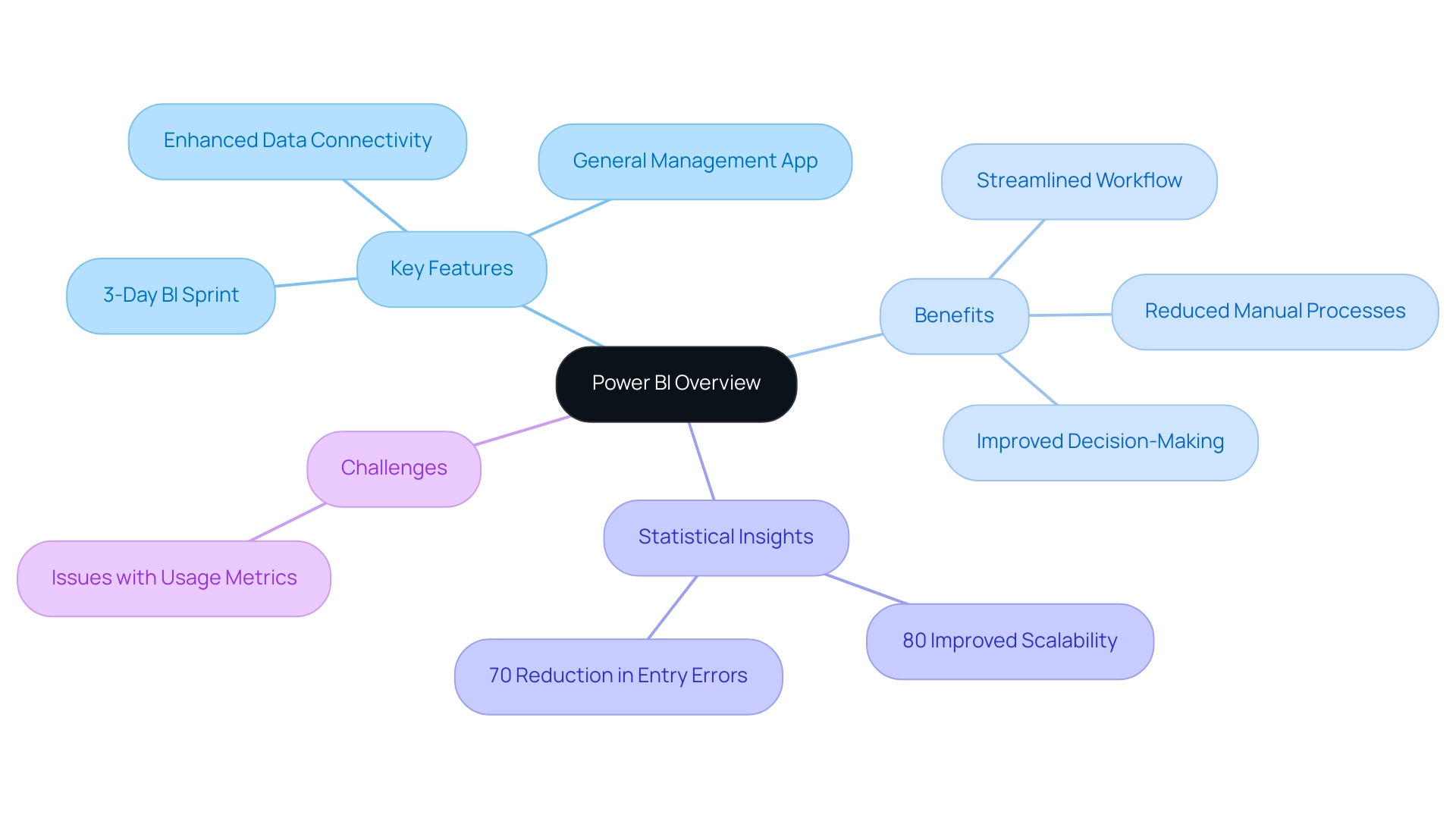
Navigating Power BI Training: Course Structures and Learning Outcomes
The introduction to Power BI training includes comprehensive courses designed to seamlessly blend theoretical knowledge with practical, hands-on exercises, ensuring participants can effectively apply what they learn in real-world scenarios. Usually organized into units, these classes address crucial subjects like information modeling, document creation, and dashboard sharing, resulting in actionable insights that enhance operational efficiency. Participants can anticipate improving their abilities in linking BI to various information sources, creating engaging visualizations, and publishing informative documents customized to their organizational requirements.
The introduction to Power BI training emphasizes practical applications that prepare learners to utilize Power BI effectively within their teams, tackling common challenges such as time-consuming documentation creation and data inconsistencies. Engaging in a well-structured introduction to Power BI training empowers beginners to systematically progress from fundamental concepts to advanced techniques, echoing the positive feedback from past participants who found the time investment well worth it. In just three days, participants will create a fully functional, professionally designed document on a topic of their choice, allowing them to focus on utilizing the insights.
Additionally, this report can serve as a template for future projects, ensuring a professional design from the start. This approach reflects a broader trend highlighted in recent case studies, where organizations with a robust training framework saw significant improvements in BI adoption rates. Significantly, a survey showed that 84% of companies have a BI adoption rate of less than 50%, highlighting the urgent necessity for effective training strategies.
Furthermore, as organizations define roles and responsibilities to ensure stakeholder engagement and alignment toward common goals, the relevance of Business Intelligence training increases, especially with Microsoft promoting Acterys as their preferred XP&A tool for cross-departmental planning and forecasting. This reinforces the importance of continuous learning in maximizing data-driven insights and operational efficiency.
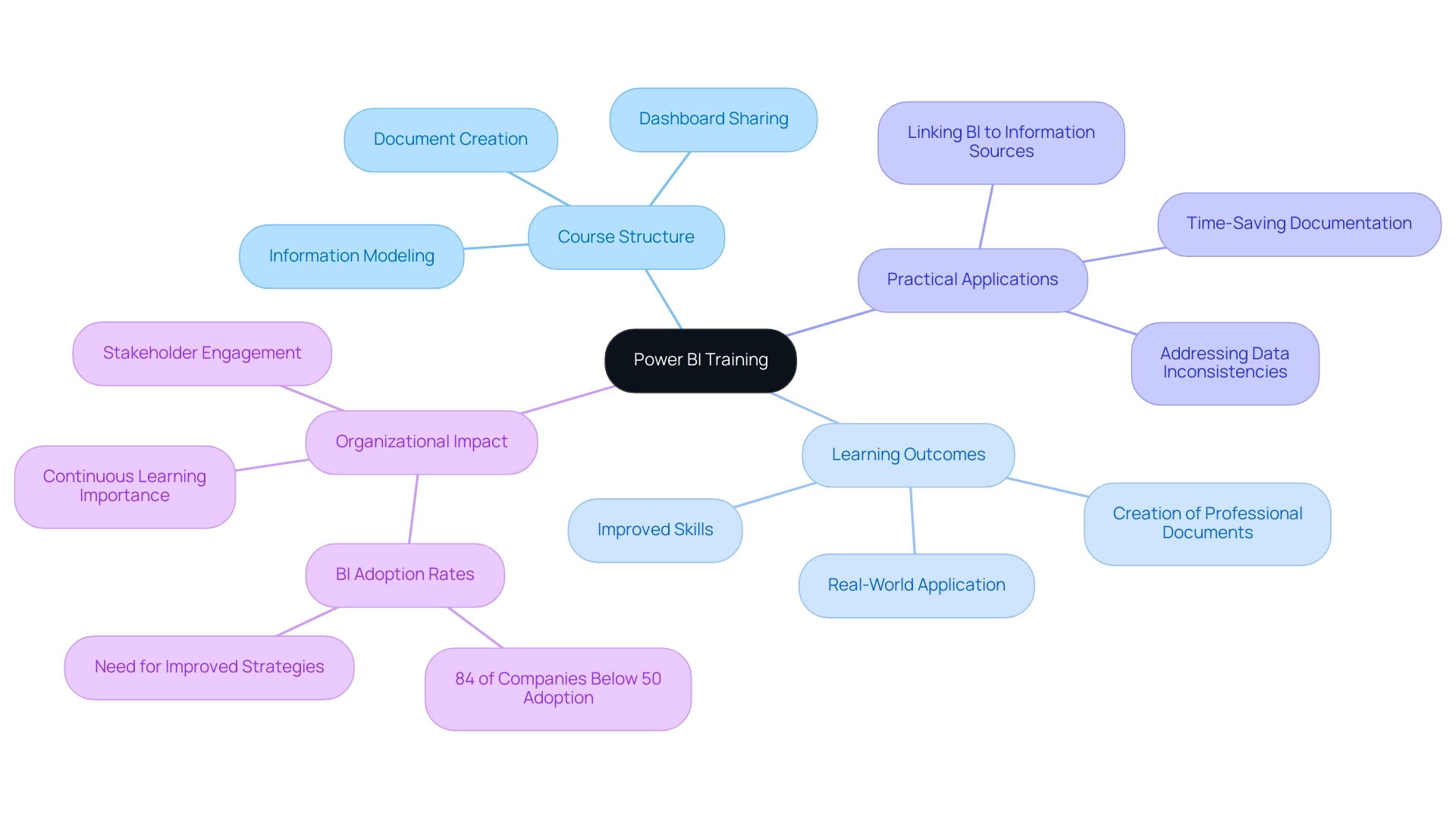
Prerequisites for Learning Power BI: What You Need to Know
An introduction to Power BI training is most effective when learners arrive with a foundational understanding of analysis concepts and familiarity with Microsoft Excel. Noble Desktop provides an introduction to Power BI training through live, instructor-led BI Bootcamp courses in NYC and online, offering an excellent opportunity to gain these essential skills. Additionally, their Data Analytics Certificate program features an introduction to Power BI training that focuses on practical training with analytics tools, enabling students to undertake real-world projects that improve their learning experience.
Classes are planned from October 1 – 3, 9:00 AM – 4:30 PM EDT in Toronto, providing timely opportunities for prospective learners.
An introduction to Power BI training that covers visualization concepts and offers practical experience with information manipulation can greatly enhance a learner’s capacity to use BI effectively. While an extensive background in programming or database management isn’t a strict prerequisite, the introduction to Power BI training will undoubtedly be enriched by an eagerness to embrace new technologies and concepts. Individuals with a strong analytical mindset often find it easier to comprehend BI’s functionalities and applications, which enhances their experience in an introduction to Power BI training and paves the way for success in their data-driven endeavors.
Additionally, the difficulties of utilizing information from BI dashboards, such as time-consuming document preparation and inconsistencies in information, highlight the need for an introduction to Power BI training and practical guidance.
For example, the module on creating and managing workspaces in the introduction to Power BI training addresses navigation within the service, including establishing and overseeing workspaces and sharing documents, which is essential for practical application. In the Microsoft Azure Data Fundamentals Training DP-900 course, you’ll learn the basics of database principles and build essential knowledge, reinforcing the significance of having a solid foundation in information concepts for an introduction to Power BI training that enhances operational efficiency and business growth. Moreover, incorporating RPA solutions such as EMMA RPA and Automate can simplify information processes and improve the effectiveness of document generation, ultimately resulting in more actionable knowledge and informed decision-making.

Exploring Learning Resources: Free Tutorials and Online Classes
For those looking to enhance their BI skills without financial investment, a wealth of free resources is readily available, addressing common challenges such as time-consuming report creation, data inconsistencies, and the lack of a governance strategy. Websites like Microsoft Learn present structured learning paths tailored to various skill levels, enabling users to progress at their own pace and overcome the hurdles of ineffective reporting and governance issues. A notable resource is the BI Cheat Sheet, which provides insights on creating visualizations and takes about 8 minutes to read, making it an efficient learning tool for understanding best practices in governance.
Additionally, platforms such as YouTube and Coursera provide extensive video tutorials and courses that explore different aspects of BI, catering to both beginners and experienced users alike, ensuring they gain actionable guidance. Community forums and user groups on platforms such as LinkedIn further enrich the learning experience by connecting learners with peers and industry experts, fostering collaboration and support. Engaging with these resources not only broadens knowledge but also equips users with diverse perspectives on effectively utilizing BI in real-world scenarios.
For instance, the HR Analytics in BI course on Udemy, led by Sarah Kithaka, equips participants with practical skills for utilizing BI in HR analytics, illustrating the application of these free resources. As highlighted by a Data Analyst from Rio Tinto, ‘Overall, the training is very good. Thank you, Simplilearn,’ which underscores the effectiveness of structured online learning, particularly for newcomers to the platform, and empowers them to leverage insights effectively while adhering to governance best practices.
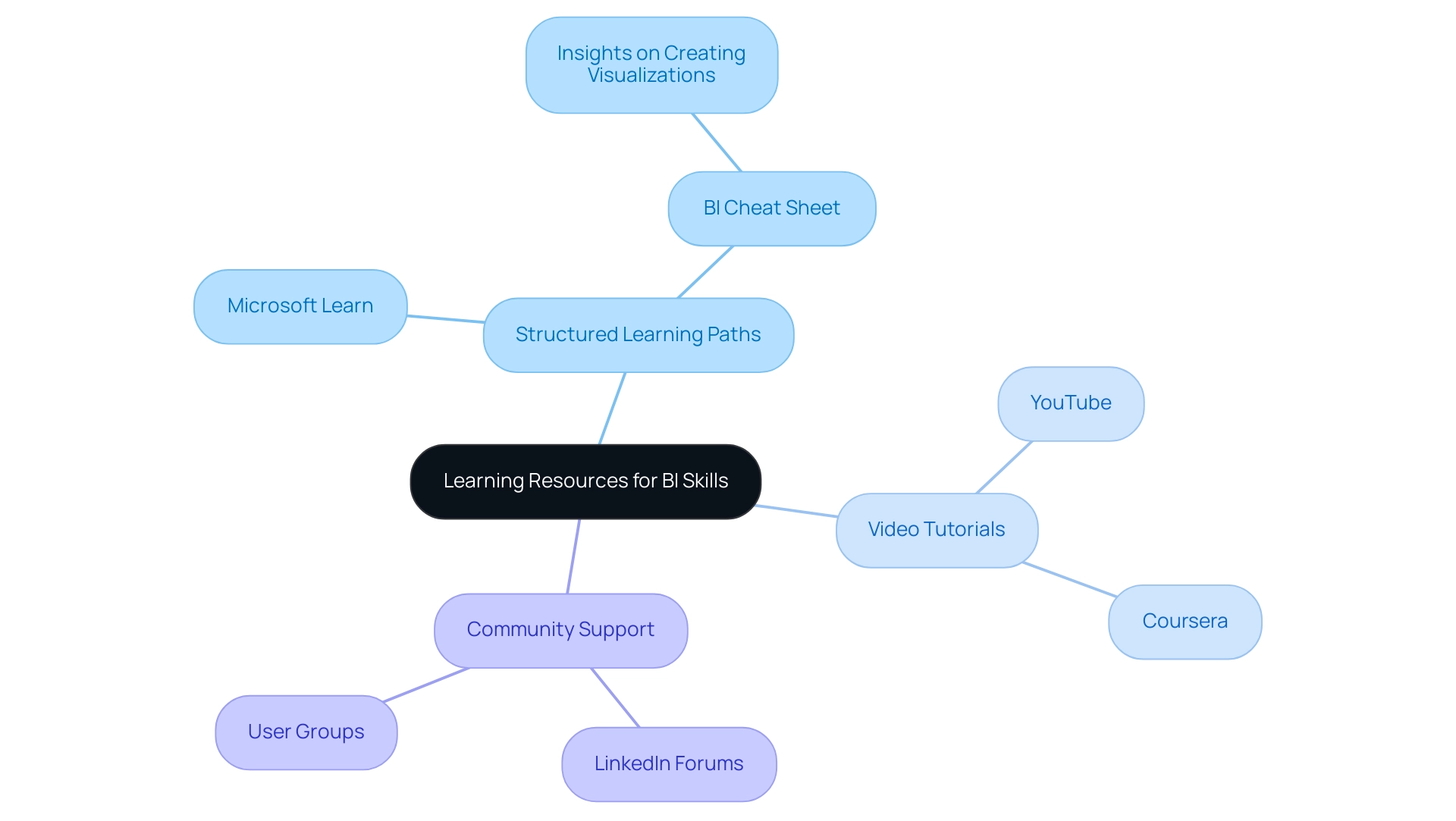
Real-World Applications of Power BI: Examples and Case Studies
BI functions as a robust tool with diverse applications across various industries, enhancing operational efficiency and informed decision-making. In the retail sector, for example, companies utilize BI to analyze sales data and optimize inventory management, resulting in enhanced customer satisfaction and significant cost reductions. A recent statistic reveals that businesses using Power BI in retail have seen a 30% improvement in inventory turnover rates.
One notable case involved a global company that automated its data processes from Salesforce, Webeo, and LinkedIn Ads using Robotic Process Automation (RPA), reducing manual refresh time from six hours to mere minutes. This transformation permitted daily report updates, streamlining operations and facilitating quicker responses to market dynamics while removing the challenges of time-consuming report creation and inconsistencies. The application of RPA not only diminished mistakes but also liberated team members for more strategic, value-enhancing tasks.
In the finance sector, organizations employ BI to illustrate financial information, oversee performance indicators, and direct investment strategies. By converting raw information into actionable insights, BI enables finance professionals to make informed decisions with confidence. A comparative analysis shows that BI offers superior cloud integration and customization options compared to competitors like Tableau and Salesforce, enhancing its usability for financial analytics.
The effectiveness of BI is further illustrated in a study that highlights its interactive dashboards and customizable reports, which not only enhance comprehension but also provide a competitive advantage in a landscape focused on information.
Statistics indicate that businesses utilizing BI have experienced marked improvements in operational efficiency, particularly in the retail and finance sectors. However, challenges such as poor master data quality and barriers to AI adoption persist, making it essential for organizations to consider tailored AI solutions that align with their specific needs. As SPEC INDIA aptly notes,
With efficient project management practices, international standards to comply, flexible engagement models, and superior infrastructure, SPEC INDIA is a customer’s delight.
This reinforces the notion that an introduction to Power BI training, combined with leveraging RPA to automate manual workflows, can significantly enhance one’s career trajectory, offering invaluable skills that align with the evolving demands of today’s business environments.

Conclusion
Power BI stands as a pivotal tool in the realm of business analytics, transforming raw data into actionable insights that drive operational success. By equipping organizations with the ability to visualize and share data effectively, Power BI enhances decision-making processes and fosters a culture of data-driven strategies. The article has explored essential components of Power BI, from effective training strategies that empower users to harness its full potential, to the prerequisites that ensure learners are well-prepared for their journey.
Furthermore, the availability of free resources and structured training programs underscores the importance of continuous learning in maximizing Power BI’s capabilities. Real-world applications highlighted throughout the article demonstrate the tangible benefits that organizations across various industries can realize, such as improved inventory turnover in retail and enhanced financial analytics in finance. These success stories not only illustrate the transformative impact of Power BI but also emphasize the need for strategic implementation to overcome common challenges.
As businesses continue to navigate an increasingly data-centric landscape, embracing Power BI is not merely advantageous but essential for maintaining a competitive edge. By committing to effective training, leveraging available resources, and understanding the practical applications of this powerful tool, organizations can unlock unprecedented operational efficiency and drive meaningful growth in their respective fields. Now is the time to seize the opportunities that Power BI presents and transform data into a catalyst for success.
Introduction
In the realm of data analysis, DAX (Data Analysis Expressions) stands as a critical component for unlocking the full potential of Power BI. As organizations grapple with the complexities of data-driven decision-making, mastering DAX becomes essential for transforming raw data into actionable insights that drive operational efficiency and growth.
This article delves into the foundational concepts of DAX, advanced techniques, and best practices, providing a comprehensive guide to enhance analytical capabilities. By equipping professionals with the knowledge to navigate DAX’s intricacies, the path to effective data manipulation and visualization becomes clearer, empowering teams to make informed decisions in an increasingly data-centric world.
Fundamentals of DAX: Building a Strong Foundation
DAX, or Data Analysis Expressions, serves as the backbone for information manipulation and analysis within Power BI. Mastering daxguide is essential for leveraging the full potential of this powerful analytics suite, especially in a data-rich environment where extracting meaningful insights is crucial for operational efficiency and business growth. However, in the context of navigating the overwhelming AI landscape, it is vital to understand how daxguide can help simplify your information processes.
Here are the core concepts that will lay a solid foundation for your DAX journey:
- Information Types: Understand the significance of various information types in DAX—Integer, Decimal, Boolean, and String. Each information type significantly influences how calculations are executed, impacting the accuracy and relevance of your analyses.
- Calculated Columns vs. Measures: Differentiate between calculated columns, which compute values row by row, and measures, which are dynamically calculated based on the report context. Grasping this distinction is essential for enhancing your models and ensuring effective decision-making.
- Filter Context and Row Context: Dive into how DAX evaluates expressions using filter context (the set of filters applied to datasets) and row context (the specific row being assessed). This knowledge is crucial for using daxguide to craft precise calculations that yield actionable insights, helping you navigate the complexities of data interpretation.
- Basic DAX Operations: Begin with foundational operations like SUM, AVERAGE, and COUNT. These essential functions act as the building blocks for developing more complex calculations, enhancing your analytical capabilities.
Furthermore, incorporating Robotic Process Automation (RPA) can greatly enhance operational efficiency by automating repetitive tasks, enabling your team to concentrate on strategic analysis instead of processing information. To illustrate the importance of effective visualization in presenting DAX measures, consider the case study titled “Visualizing DAX Measures Effectively.” This case study emphasizes how proper visualization can transform powerful measures into actionable insights.
Furthermore, as Microsoft states, “Microsoft certification ensures that the visual does not interact with external services, guaranteeing that your PDF files are securely stored and encrypted within the report, in alignment with your report sensitivity settings.” This quote adds credibility to the discussion of DAX functionalities and security. Additionally, with daily updates on usage metrics, it is evident that DAX remains a crucial tool in Power BI, underscoring the relevance of mastering these skills.
By mastering these foundational concepts, you empower yourself to delve into advanced DAX functionalities as outlined in daxguide, paving the way for sophisticated analyses that drive informed decision-making and enhance operational efficiency.
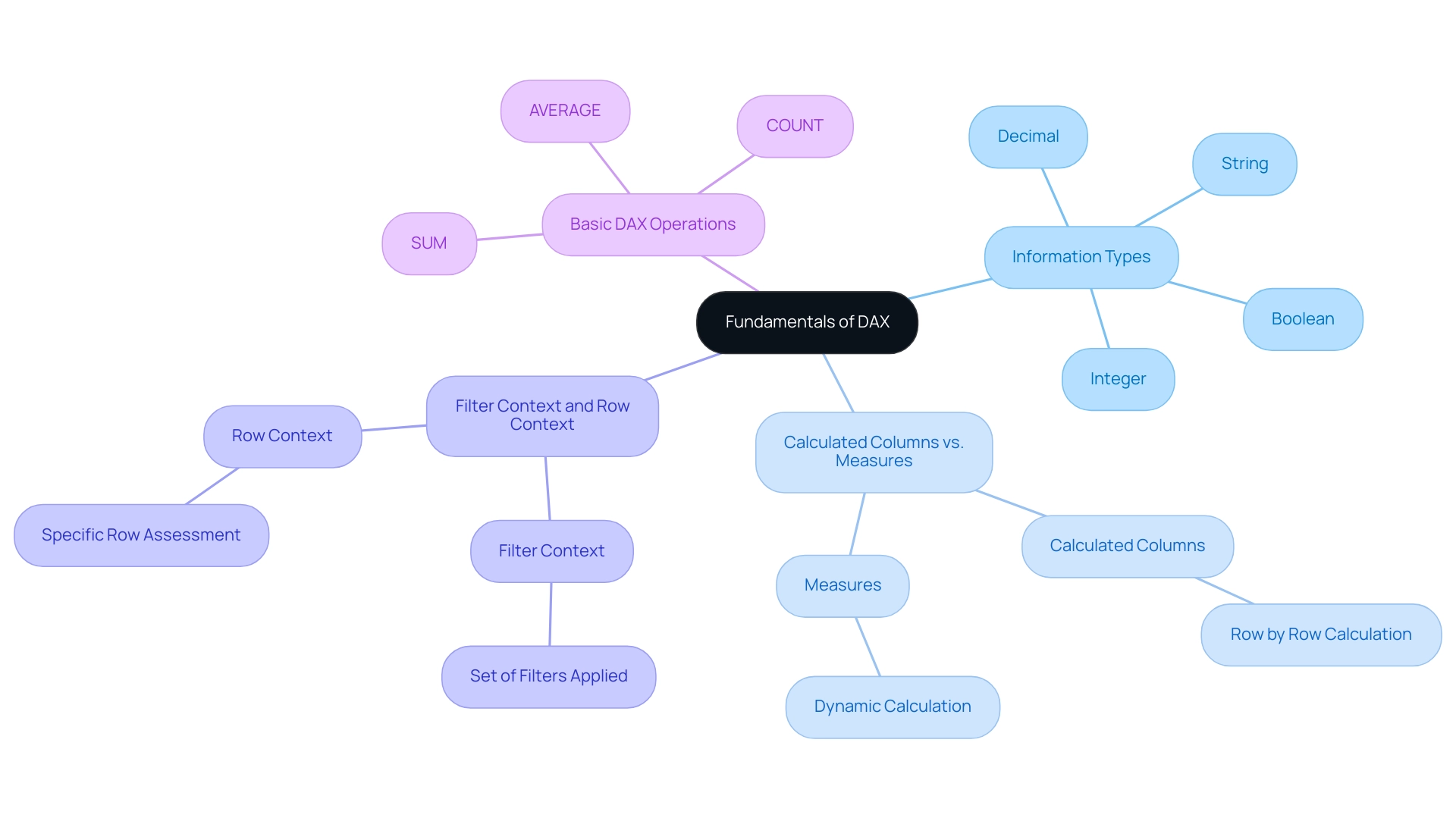
Advanced DAX Techniques for Enhanced Power BI Analysis
Once foundational DAX skills are established, diving into advanced techniques can profoundly enhance your data analysis capabilities in Power BI, aiding in overcoming common challenges such as time-consuming report creation and data inconsistencies. Here are several key techniques to explore, particularly in the context of creating interactive visualizations with tools like Drill Down Network PRO, which allows for extensive customization and automatic relationship detection:
- Using Multiple IF Statements: Master the art of nesting IF statements to create intricate conditional logic. For instance, you can categorize sales performance into distinct tiers based on established thresholds:
DAX
SalesTier = IF(Sales[Amount] > 10000, "High", IF(Sales[Amount] > 5000, "Medium", "Low"))
- Time Intelligence Features: Utilize DAX time intelligence features to perform powerful calculations such as year-to-date totals, comparisons with prior periods, and running totals. Functions like
TOTALYTD,SAMEPERIODLASTYEAR, andDATEDIFFare essential for conducting period-based analyses:
DAX
YTD Sales = TOTALYTD(SUM(Sales[Amount]), Date[Date])
- Using CALCULATE: The
CALCULATEfunction is a transformative tool that enables you to adjust the filter context of your calculations. This is particularly advantageous when applying additional filters or modifying existing ones:
DAX
SalesLastYear = CALCULATE(SUM(Sales[Amount]), SAMEPERIODLASTYEAR(Date[Date]))
- Variables in DAX: Introducing variables can streamline complex expressions and enhance performance. By capturing intermediate results in variables, you can render your DAX code more readable and efficient:
DAX
TotalSales = VAR CurrentSales = SUM(Sales[Amount])
RETURN CurrentSales
By mastering these advanced techniques, you will elevate your analytical capabilities in Power BI, transforming data into actionable insights that drive informed decision-making within your organization. These operations not only simplify complex business scenarios but also facilitate dynamic reporting, a necessity in today’s data-rich environment. Moreover, integrating these DAX techniques with Robotic Process Automation (RPA) can automate reporting processes, further enhancing operational efficiency and reducing the time spent on manual tasks.
Furthermore, Cloud that’s 12 years of experience in training and consulting reinforces the credibility of these techniques, ensuring that you learn from a trusted source. The structured learning context provided in the daxguide course outline for Advanced DAX will further enhance your understanding and application of these techniques in real-world scenarios, equipping you with the necessary skills for advanced data analysis in Power BI. As Jason Himmelstein observed, the ability to use visual calculations in combo charts, such as the line and clustered column chart, exemplifies the evolving capabilities of DAX tools in creating insightful visualizations.
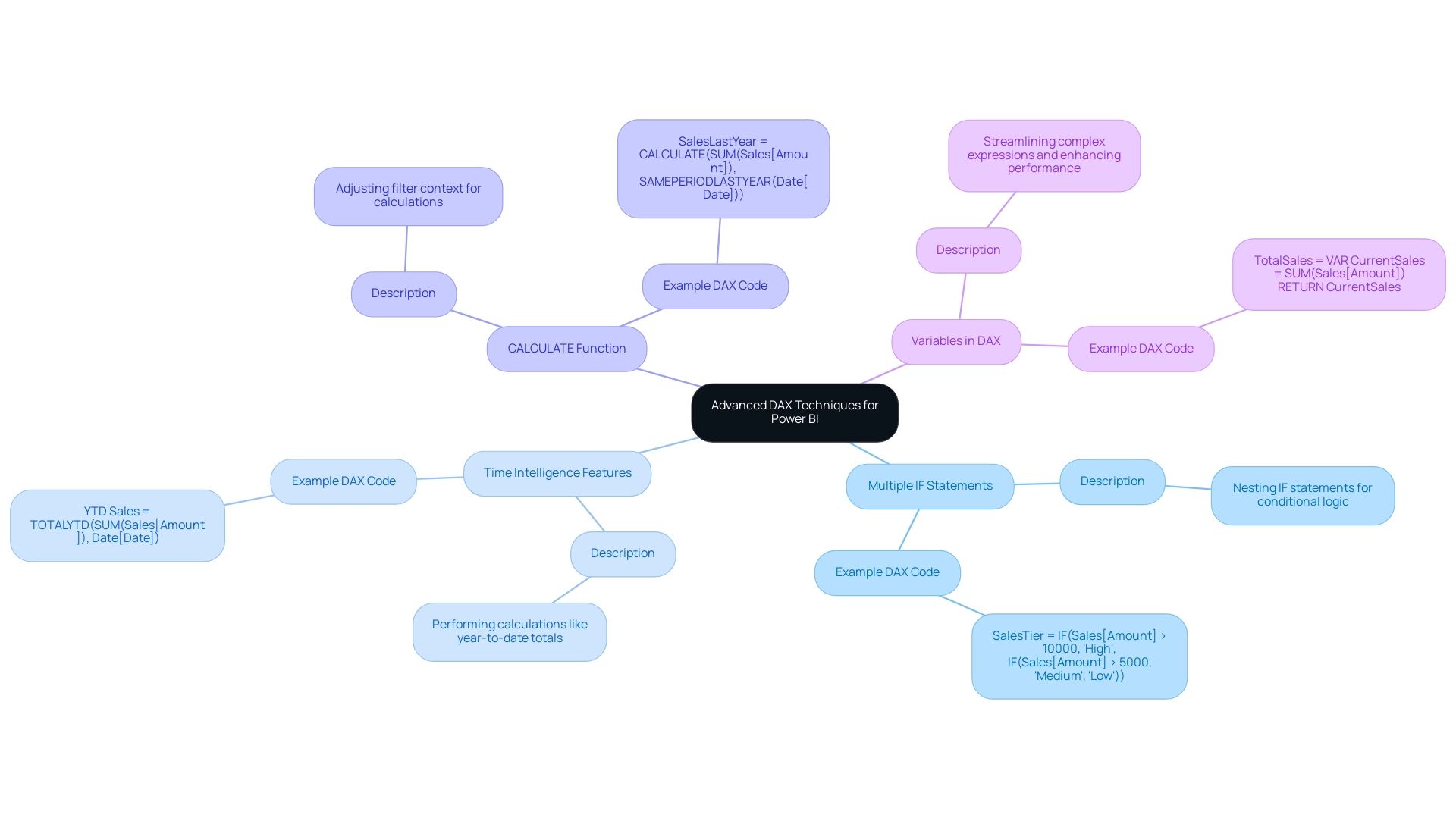
Common DAX Functions and Their Applications
Mastering common DAX expressions, referred to as daxguide, is crucial for executing a wide range of calculations efficiently and leveraging Business Intelligence for operational success. Here are five essential roles to consider for your analytical toolkit:
- SUM: This function aggregates all the values in a specified column, allowing for straightforward total calculations.
DAX
Total Sales = SUM(Sales[Amount]) - AVERAGE: Use this function to determine the mean of values within a column, providing insights into average performance.
DAX
AverageSales = AVERAGE(Sales[Amount]) - COUNTROWS: This function counts the total number of rows in a given table or expression, useful for tracking orders or transactions.
DAX
TotalOrders = COUNTROWS(Sales) - DISTINCT: Employ this function to return a one-column table with unique values from the specified column, assisting in customer segmentation.
DAX
UniqueCustomers = DISTINCT(Sales[CustomerID]) - FILTER: This powerful function generates a filtered table based on specified criteria, allowing for targeted analysis.
DAX
FilteredSales = FILTER(Sales, Sales[Amount] > 5000)
Additionally, the TOTALMTD function is particularly useful for calculating the month-to-date total sales amount, which can be expressed as:
DAX
TotalSalesMTD = TOTALMTD(SUM(Sales[Amount]), 'Calendar'[Date])
This practical application highlights how DAX functions can be employed to derive meaningful insights from your data, streamline report creation, and mitigate data inconsistencies. For instance, using the FILTER tool can help you quickly isolate high-value sales, allowing for faster decision-making and reporting.
Moreover, understanding the distinction between calculated columns and measures is essential in daxguide. Measures are utilized for dynamic calculations based on the present context, while calculated columns are static and computed during loading. This distinction enables analysts to select the suitable approach for their particular analytical requirements in Power BI.
Incorporating RPA solutions alongside DAX operations can further improve operational efficiency. By automating repetitive tasks linked to preparation and reporting, RPA can free up valuable time for analysts, enabling them to concentrate on deriving actionable insights. By merging these functions and concepts into your daxguide arsenal, you enhance your analytical capabilities within Power BI, streamline your analysis processes, and empower yourself to derive actionable insights that drive growth and innovation.
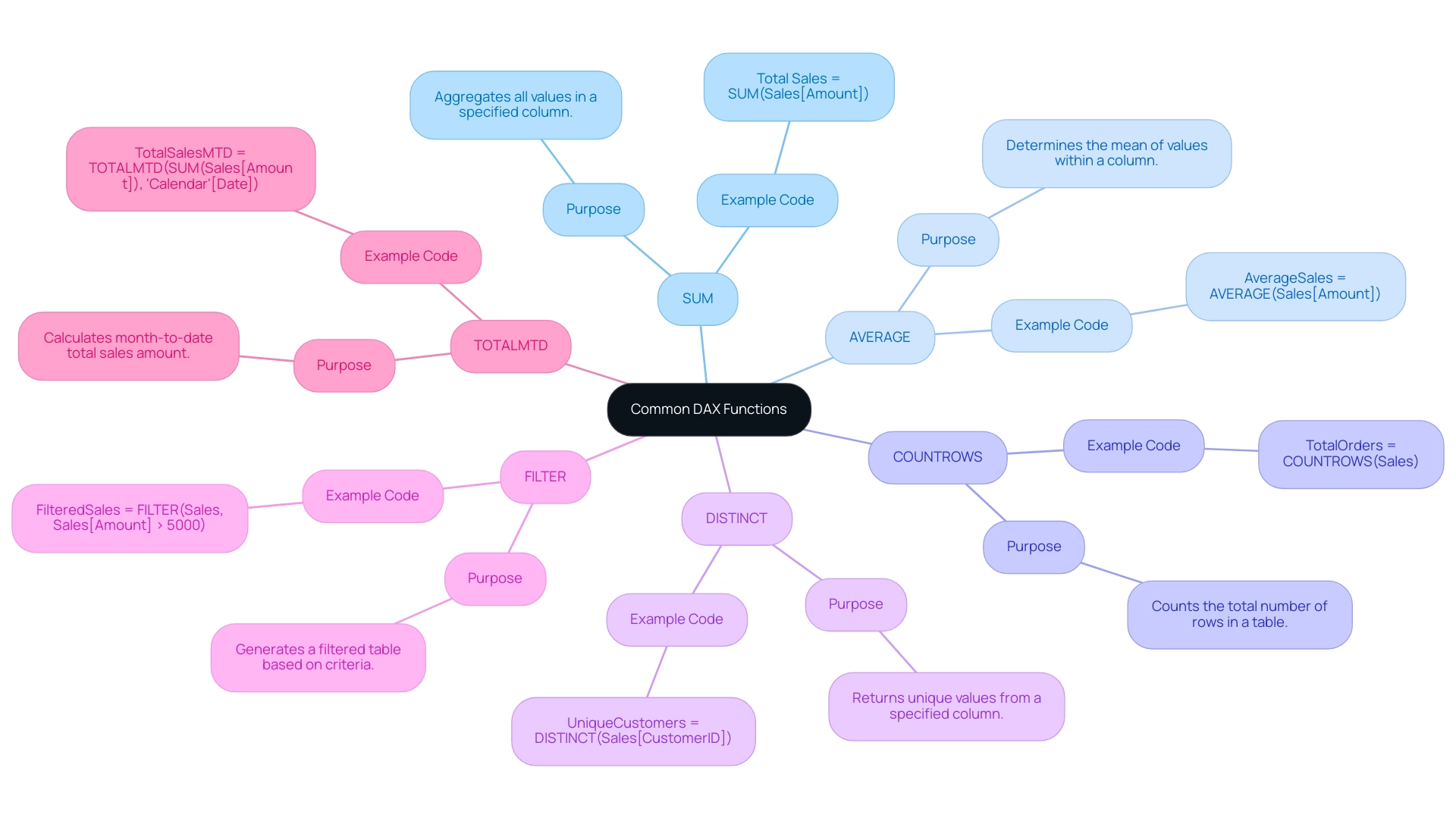
Debugging DAX: Common Errors and Solutions
Troubleshooting DAX formulas can often feel overwhelming, particularly when confronted with challenges such as time-consuming report creation, inconsistencies, and the need for a comprehensive daxguide. By recognizing and understanding common errors, you can streamline the debugging process and enhance your analytical performance. Here are some frequent issues along with their effective solutions, each directly addressing the challenges you may encounter:
- Errors in Syntax: Always ensure that your DAX expressions are formatted correctly, with appropriate parentheses and commas. For instance:
DAX
TotalSales = SUM(Sales[Amount)
Should be corrected to:
DAX
TotalSales = SUM(Sales[Amount])
This attention to syntax can prevent unnecessary delays in report generation.
-
Incorrect Information Types: DAX is particularly sensitive to types. Always confirm that you are using the correct type for your calculations. Executing mathematical operations on text information, for instance, will invariably result in errors, contributing to inconsistencies in your reports.
-
FILTER Function Issues: When using the FILTER function, ensure that your table expressions and conditions are valid. Incorrect conditions can yield unexpected results, so double-check your criteria for accuracy. Tackling this can help offer clearer, actionable insights from your information.
-
Circular References: Circular dependency errors occur when a measure inadvertently refers back to itself. To avoid this, closely review your calculations and eliminate any scenarios that could create such references. This practice supports a more reliable governance strategy in your reporting.
-
Neglecting a Dedicated Date Table: Failing to integrate a dedicated date table can significantly affect time intelligence calculations. This oversight can lead to inaccurate analyses, making it crucial to implement a separate date table in your model. Such integration is essential for generating trustworthy reports that guide decision-making.
By familiarizing yourself with these prevalent errors and their corresponding solutions provided in daxguide, you can significantly enhance your debugging capabilities for DAX formulas, ultimately improving your analytical performance and addressing common challenges in report creation. As Mohan Raju, a results-driven business analyst, aptly stated, “Thank you for sharing, this is helpful!” This sentiment highlights the importance of mastering these concepts to bridge information gaps effectively.
Additionally, the case study titled “Common Mistakes in DAX Usage” illustrates how avoiding mistakes such as incorrect syntax, wrong data types, and circular references can lead to more effective DAX utilization and improved data analysis in Power BI, directly addressing the challenges of report creation and actionable guidance.
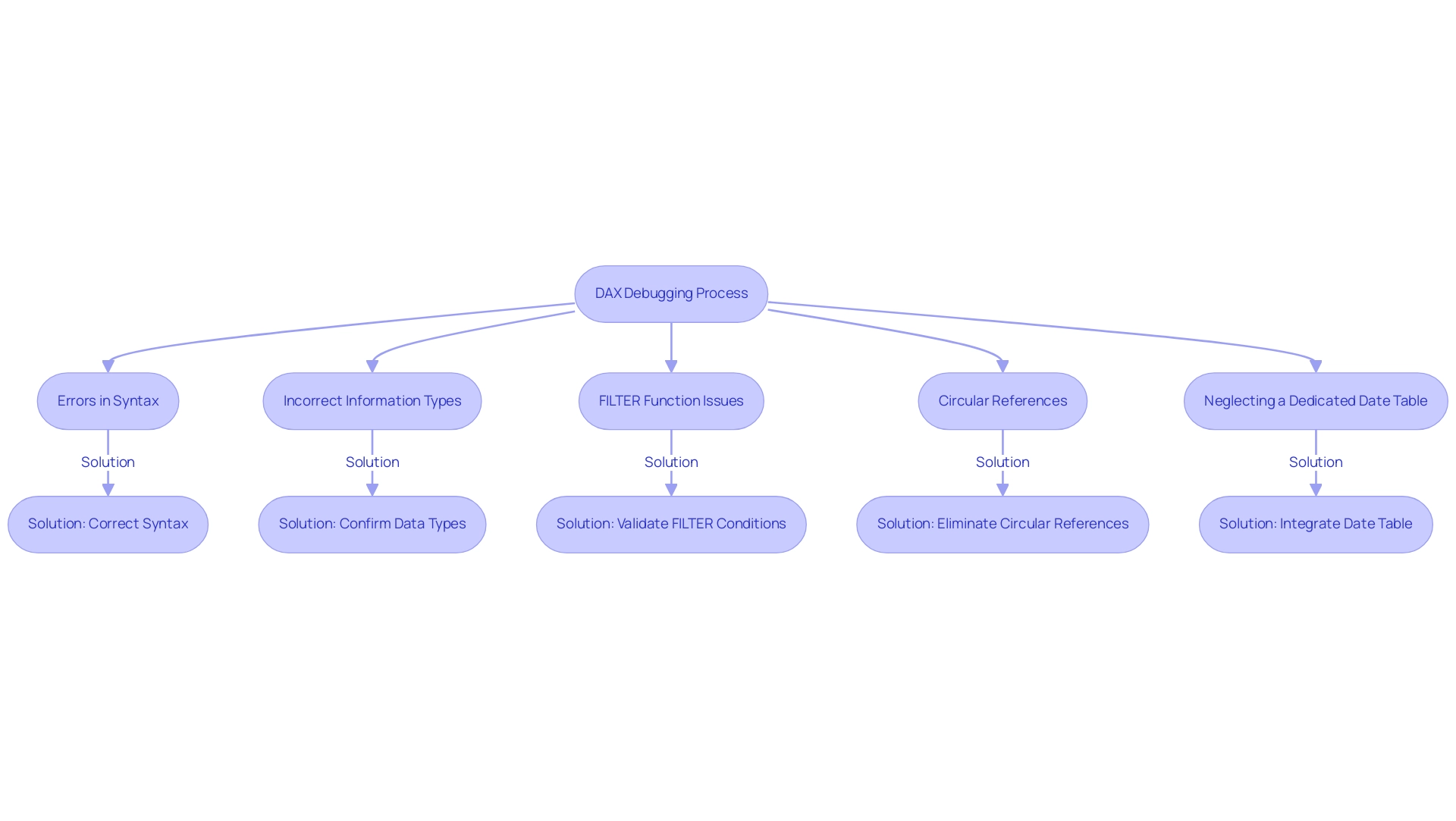
Best Practices for Writing DAX Code
To write effective DAX code, consider the following best practices that can significantly enhance both clarity and performance while supporting your business intelligence goals:
-
Use Clear Naming Conventions: Descriptive names for measures and calculated columns make it easier for both you and others to understand their purpose. For instance, prefer
Total Sales Amountover generic options likeMeasureto convey purpose clearly, aligning with the need for actionable insights. -
Keep Formulas Simple: Break down complex calculations into smaller, manageable components. Utilizing variables to store intermediate results not only simplifies your DAX but also improves readability and debugging efficiency, addressing challenges in report creation.
-
Limit the Use of Nested IFs: Instead of relying on multiple nested IF statements, opt for SWITCH to create cleaner and more comprehensible logic. For example:
DAX
SalesTier = SWITCH(TRUE(),
Sales[Amount] > 10000, "High",
Sales[Amount] > 5000, "Medium",
"Low")
-
Optimize Performance: Mindful coding can enhance performance; limit row-by-row calculations and utilize aggregations when feasible. For iterating over tables, prefer functions like SUMX or AVERAGE to ensure efficiency, crucial for operational efficiency. Additionally, integrating RPA solutions can automate repetitive tasks in your reporting processes, further enhancing performance and reducing manual errors.
-
Document Your Code: Incorporate comments within your DAX formulas to elucidate the logic behind intricate calculations. This practice not only supports future updates but also fosters collaboration among team members, promoting a culture of clarity and efficiency.
By adhering to these best practices outlined in daxguide, you can elevate the quality and maintainability of your DAX code, leading to more efficient analyses that empower your operational decisions. For instance, a recent case study titled Working Upstream for Complex Calculations illustrates how daxguide can be used to create calculated columns or flags in the backend, simplifying complex DAX formulas and significantly boosting performance in Power BI.
Moreover, consider exploring the fully featured 30-day free trial of BI Connector, which can enhance your DAX coding experience without requiring a credit card. As of the last update on 07 Nov, 2024, these tools are continually evolving to support users effectively. Furthermore, as Yana Khare emphasizes, integration and collaboration are key; Power BI’s compatibility with tools like Microsoft Excel, Azure, and SharePoint enhances the overall analytical experience, particularly in the context of using clear naming conventions.
By leveraging both DAX best practices and RPA solutions, you can mitigate data inconsistencies and streamline report creation, ensuring your business intelligence efforts are both effective and efficient.
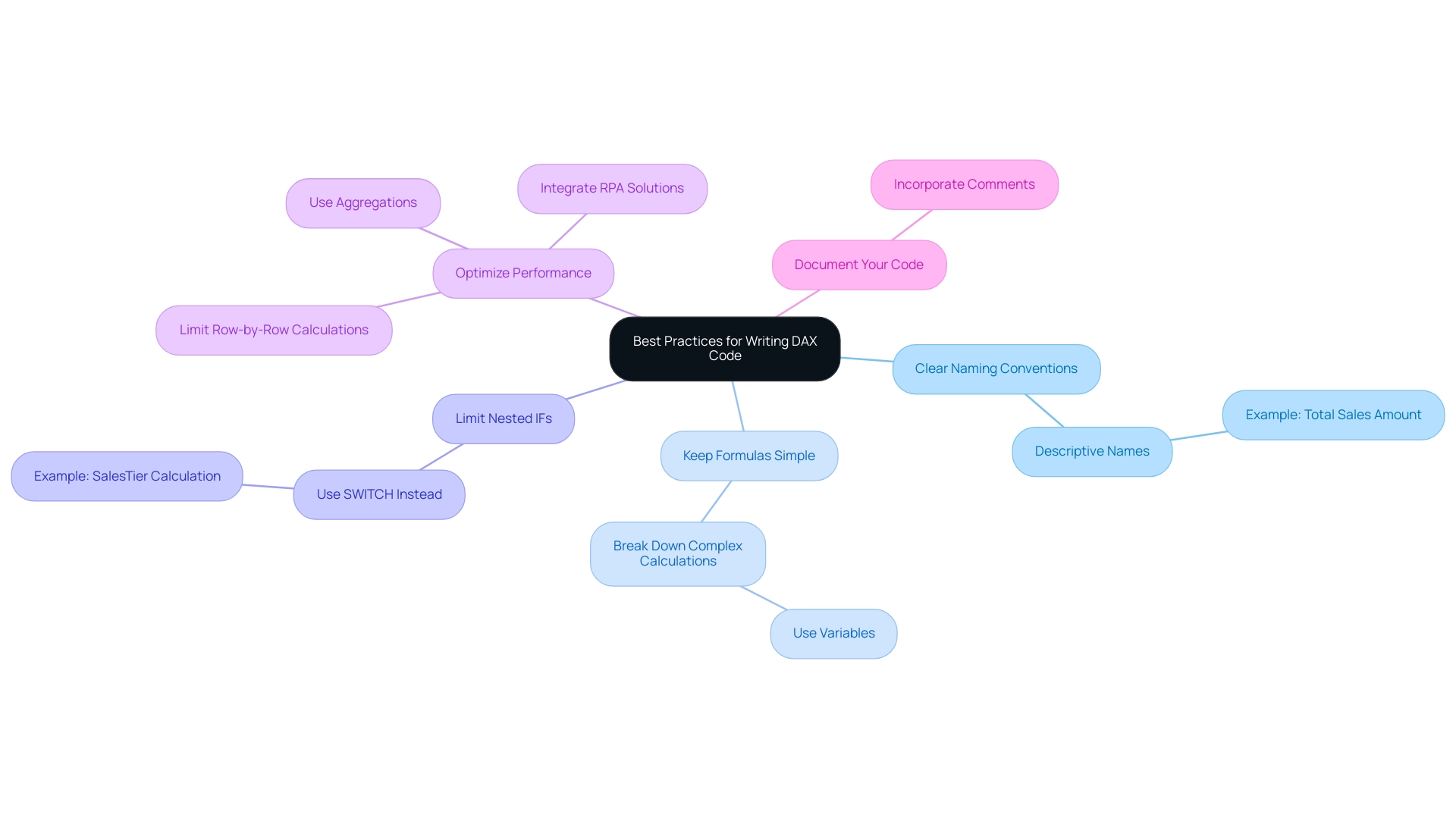
Conclusion
Mastering DAX is not merely an academic exercise; it represents a transformative journey toward enhancing data analysis capabilities within Power BI. By establishing a strong foundation with core concepts such as:
- Data types
- Calculated columns
- Measures
- Basic functions
professionals can confidently navigate the complexities of data manipulation. This foundational knowledge is crucial for driving operational efficiency and informed decision-making in a data-rich environment.
As one delves into advanced techniques, the power of DAX becomes even more pronounced. Utilizing advanced functions and strategies, such as:
- Time intelligence
- The CALCULATE function
significantly enhances analytical capabilities, allowing for deeper insights and streamlined reporting processes. Moreover, integrating best practices in DAX coding ensures clarity and performance, fostering collaboration and minimizing errors in analytical workflows.
Ultimately, the mastery of DAX is a strategic advantage in today’s data-driven landscape. By embracing both foundational and advanced DAX techniques, organizations can transform raw data into actionable insights, driving growth and operational efficiency. The commitment to continuous learning and application of these skills empowers teams to tackle complex data challenges and make informed, strategic decisions that propel their organizations forward in an increasingly competitive market.
Introduction
In the dynamic world of business, analytics has emerged as a cornerstone for informed decision-making and operational excellence. By understanding the four primary types of business analytics—descriptive, diagnostic, predictive, and prescriptive—organizations can unlock a treasure trove of insights that drive strategic initiatives and foster growth. Each type plays a distinctive role, from summarizing historical performance to forecasting future trends and recommending actionable strategies.
However, the journey to effective analytics is not without its challenges, including data privacy concerns and the need for robust training. As organizations navigate this complex landscape, the integration of advanced tools like Robotic Process Automation (RPA) and tailored AI solutions becomes essential.
This article delves into the intricacies of business analytics, highlighting practical applications and future trends that empower businesses to enhance performance and gain a competitive edge in an increasingly data-driven marketplace.
Exploring the Four Types of Business Analytics
Business analytics types can be categorized into four primary categories: descriptive, diagnostic, predictive, and prescriptive. Descriptive analysis plays a vital role in summarizing historical data, allowing organizations to identify trends and patterns through intuitive dashboards and comprehensive reports. This fundamental layer of analysis is crucial for companies seeking to comprehend their historical performance.
Building on this, diagnostic examination delves deeper, exploring the reasons behind historical outcomes. By uncovering the factors contributing to success or failure, businesses can make informed adjustments to their strategies. Predictive analysis leverages statistical models and machine learning techniques to anticipate future outcomes, empowering organizations to proactively address potential challenges before they arise.
A notable example is the use of predictive analysis in higher education, where approximately 1,400 universities have adopted these techniques to tackle low graduation rates. For instance, Georgia State University has successfully raised its graduation rate by 23% since 2003, demonstrating the effectiveness of predictive data analysis in identifying trends and supporting student success. Finally, prescriptive analysis takes it a step further by suggesting specific actions based on insights.
Through optimization algorithms and simulations, it guides decision-makers in achieving their desired results. Each of these business analytics types serves a unique and crucial purpose, enabling businesses to enhance their intelligence and operational efficiency. However, organizations encounter considerable obstacles to effective utilization, including:
– Privacy and security issues (49%)
– Restricted access to information (33%)
– Insufficient training (29%)
As we navigate the overwhelming AI landscape, it’s crucial to harness tailored solutions that cut through the noise. IDC forecasts that by 2025, consumers will hold a remarkable 36% portion of information, highlighting the necessity for efficient analysis tools to utilize this abundance of knowledge. Companies must also invest in information management solutions and analysis tools to navigate the complexities of large-scale information handling effectively.
Indeed, with 57% of organizations utilizing a chief data officer and 59% depending on system administrators, the strategic execution of these data types, alongside improved Power BI services—including the 3-Day Power BI Sprint for swift report generation and the General Management App for thorough management—combined with AI-driven insights from Small Language Models and GenAI Workshops, is vital for attaining operational efficiency and addressing the challenges posed by big data.
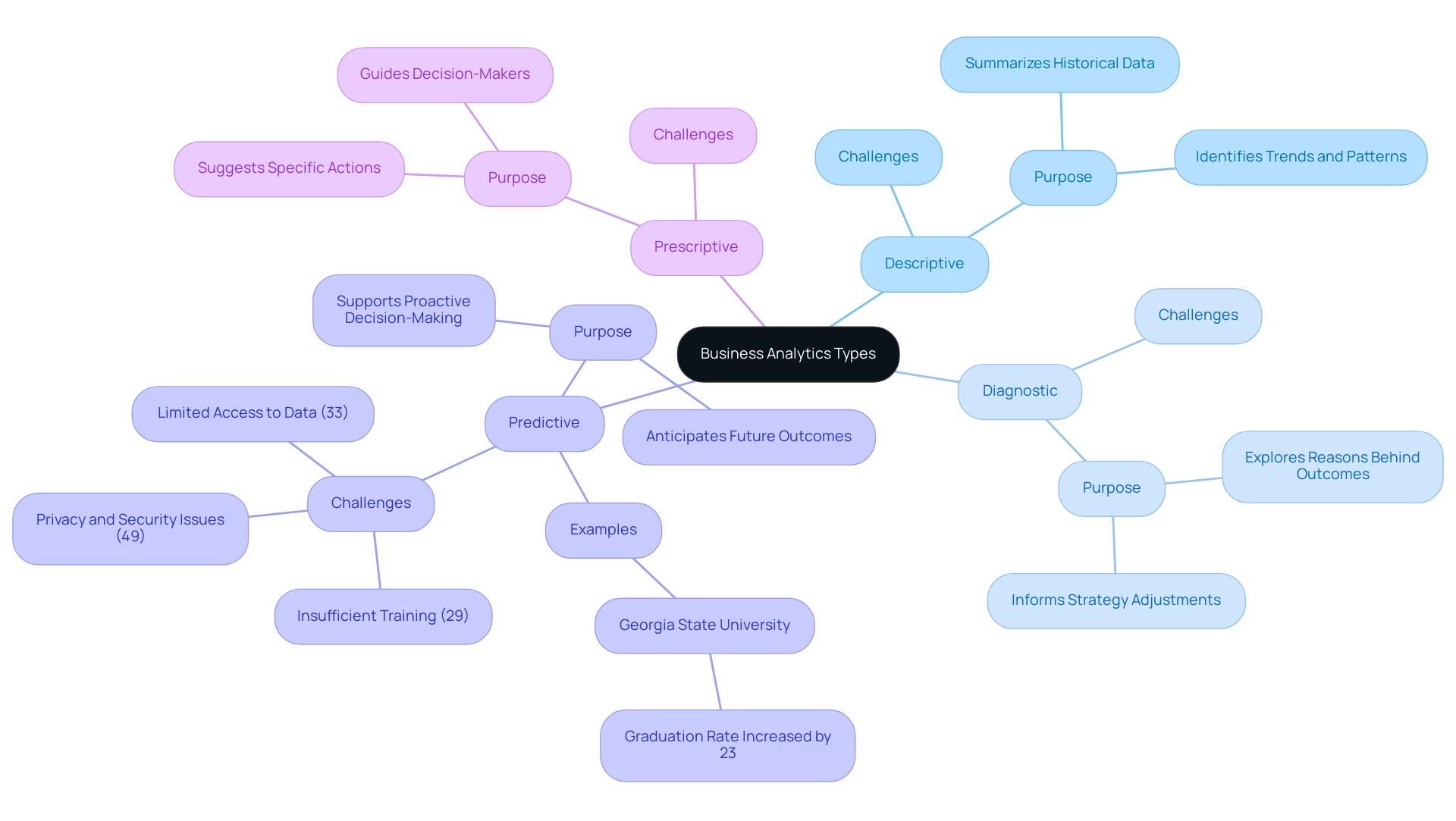
When and Why to Use Each Type of Business Analytics
Descriptive analysis serves as a foundational tool for businesses aiming to comprehend past performance, making it particularly effective for conducting performance reviews and producing historical reports. In this context, hospitals track patient admissions over time, leveraging Business Intelligence (BI) to allocate resources more efficiently and optimize care delivery. This practical application underscores the significance of BI in the healthcare sector.
Conversely, diagnostic analysis is essential when companies need to explore the underlying causes of specific results, such as uncovering reasons for sales decreases or customer turnover. Insights gained from diagnostic assessments can drive targeted improvements, highlighting the importance of collaboration among cross-functional teams in sharing insights from various evaluations.
Predictive analysis is essential for organizations looking to forecast future trends. By anticipating sales forecasts or inventory needs, companies can make proactive decisions that align with projected demands, which has been shown to enhance overall operational efficiency significantly. Moreover, prescriptive analysis is utilized to identify the optimal course of action, such as in logistics optimization or effective resource allocation.
These business analytics types serve distinct purposes, and their effectiveness hinges on the specific questions that a business seeks to answer. As highlighted in the case study ‘Integrating Four Types of Analysis,’ a cohesive strategy that integrates various business analytics types, including descriptive, diagnostic, predictive, and prescriptive analyses, can significantly improve organizational decision-making, fostering collaboration across departments and enabling a more comprehensive understanding of data-driven insights. Furthermore, the implementation of Robotic Process Automation (RPA) has proven to streamline operations, reduce manual errors by 70%, and free up valuable resources, improving workflow efficiency by 80%.
This makes RPA an essential tool for boosting productivity in healthcare services, particularly in tackling challenges such as manual information entry errors and sluggish software testing.
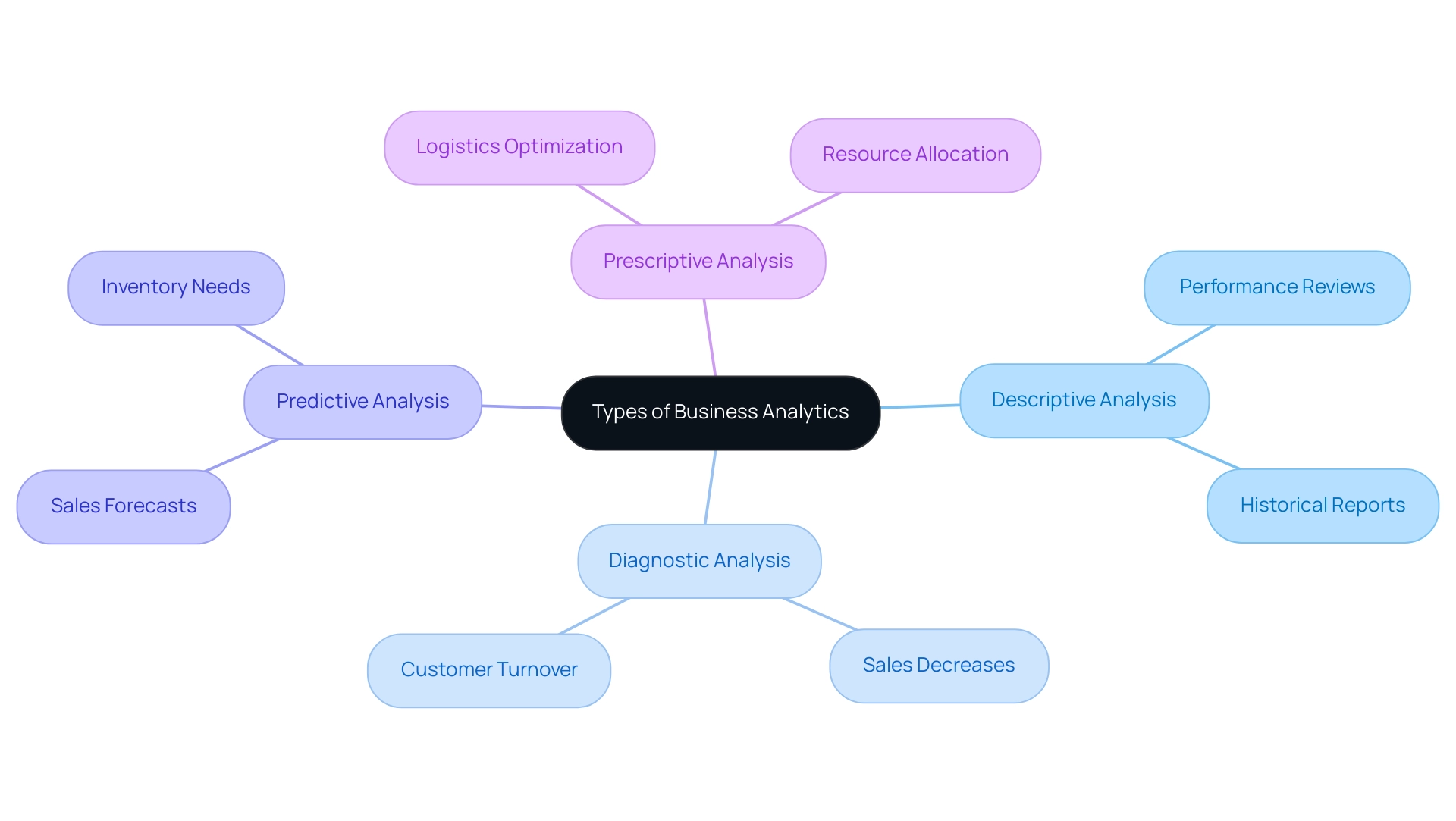
Benefits and Challenges of Business Analytics Types
Descriptive analysis acts as a strong instrument for companies, providing a clear overview of historical performance metrics. However, it’s important to acknowledge that this method can sometimes oversimplify complex situations, potentially leading to misinterpretations of information. As businesses look to 2024, the benefits of descriptive analysis are highlighted by emerging statistics, revealing that organizations effectively utilizing these insights, alongside Robotic Process Automation (RPA), are better positioned for strategic decision-making.
RPA streamlines manual workflows, enhancing operational efficiency and allowing teams to concentrate on analysis rather than repetitive tasks. Yet, while descriptive analysis offers foundational benefits, it is diagnostic examination that provides a more profound understanding of underlying issues. This type of analysis reveals the reasons behind past outcomes, but it often requires advanced analytical capabilities and can be time-consuming.
As noted by Jonathan J. Deeks,
They have been shown to have better statistical properties when there are few events,
highlighting the intricacies involved in executing diagnostic evaluations successfully. Organizations encounter difficulties when applying diagnostic analysis, especially in guaranteeing the accessibility and reliability of the essential information, as well as overcoming obstacles to AI integration and tackling inadequate master information quality. Here, the integration of Business Intelligence can help unlock the power of information, providing actionable insights that drive growth and innovation.
The case study on subgroup analyses and meta-regressions highlights that a substantial number of studies is necessary for meaningful investigations of heterogeneity, aligning with the challenges of diagnostic evaluation. In this context, sensitivity analyses—performing evaluations with and without outlying studies—become crucial for deriving meaningful insights while navigating these challenges. Predictive techniques advance the process, allowing companies to anticipate upcoming trends using past information.
Yet, its effectiveness hinges on the quality of that historical data and is susceptible to unforeseen market changes, particularly when the value of correlation coefficients ranges between -1 and +1, underscoring the need for precision in data interpretation. Finally, prescriptive analysis provides actionable recommendations to optimize decision-making; however, the implementation of these recommendations can be hindered by a lack of organizational buy-in. By comprehensively understanding the benefits and challenges across various business analytics types, including the necessity for tailored AI solutions to navigate the overwhelming AI landscape, organizations can more effectively leverage data-driven insights for enhanced operational efficiency through RPA and Business Intelligence.
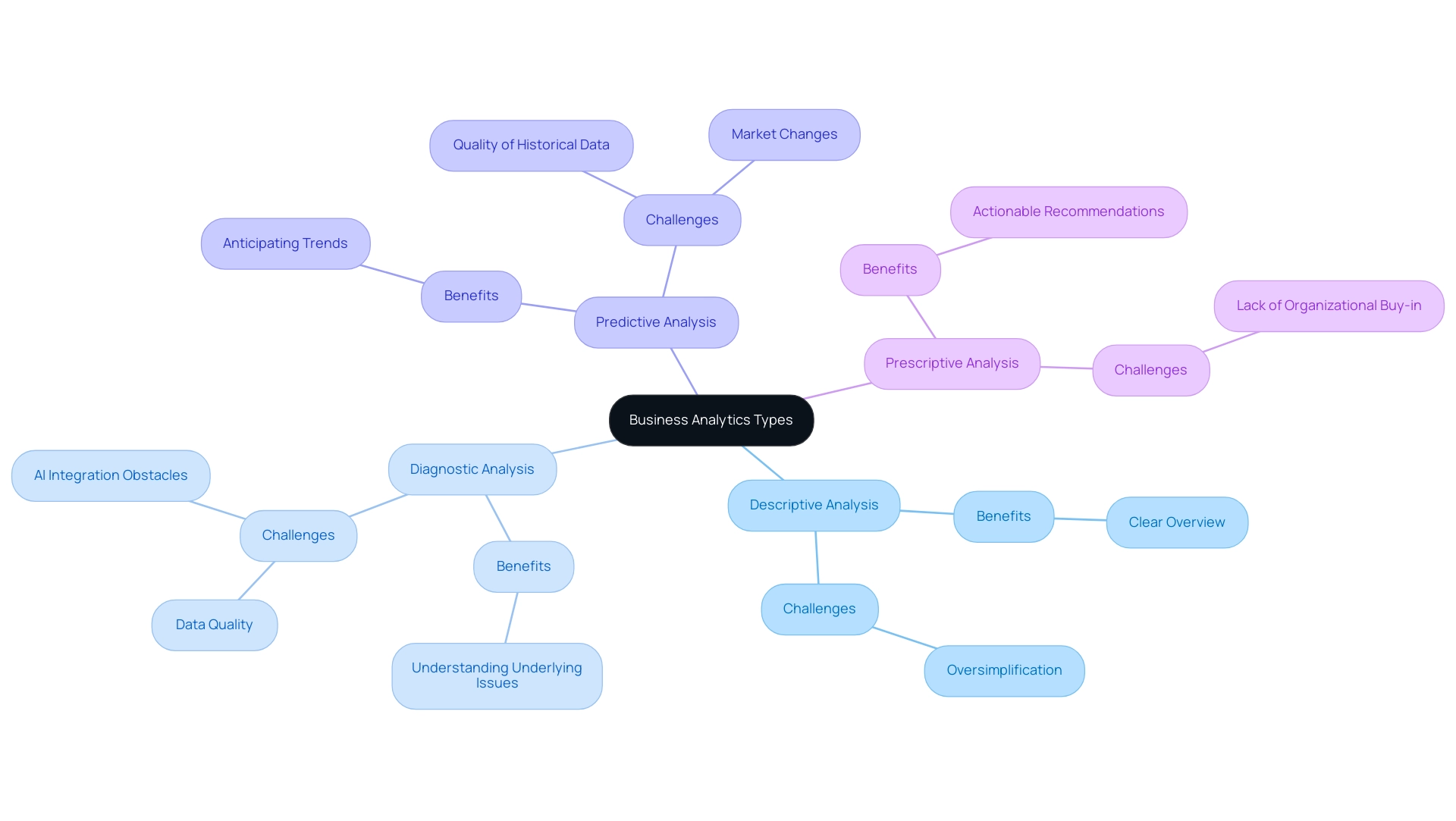
Enhancing Business Performance Through Analytics
Leveraging the power of business analytics types, including Robotic Process Automation (RPA) and customized AI solutions, offers the potential for transformative improvements in organizational performance across various dimensions. For instance, companies leveraging RPA can automate manual workflows, significantly boosting operational efficiency while reducing costs and minimizing errors. This is especially vital in a rapidly evolving AI landscape where organizations must adapt swiftly.
Predictive analysis, which is one of the business analytics types, can optimize inventory management, effectively cutting costs while simultaneously boosting customer satisfaction through improved product availability. Such an approach not only minimizes stockouts but also allows businesses to anticipate demand fluctuations. Descriptive analysis, which is one of the business analytics types, further refines marketing strategies by identifying successful campaigns and discerning customer preferences, enabling targeted efforts that resonate with the audience.
Meanwhile, one of the important business analytics types, diagnostic analysis, plays a crucial role in uncovering operational inefficiencies, enabling organizations to streamline processes and achieve significant cost savings. Furthermore, among the business analytics types, prescriptive analysis enables companies to enhance resource distribution, aiding in the maximization of return on investment—a vital factor in today’s competitive environment. In fact, the average ROI for enterprises utilizing business intelligence and data analysis is an impressive 1300%, underscoring the substantial benefits these tools can provide.
By integrating data analysis into their decision-making frameworks, companies can cultivate a robust data-driven culture that enhances overall performance. A case in point is a financial services firm that utilized trend analysis to adjust its investment strategies in anticipation of market shifts, exemplifying how data insights can effectively inform strategic decisions. Furthermore, as the business intelligence software market is anticipated to hit around $177 billion by 2030, it is clear that companies are progressively acknowledging the significance of data analysis, RPA, and BI in fostering success.
As entities continue to embrace these analytical tools, they position themselves for sustained growth and success in an increasingly data-centric world. According to the U.S. Bureau of Labor Statistics, the median yearly salary for management analysts was $99,410 in May 2023, emphasizing the importance of skilled professionals who utilize data analysis to enhance organizational performance and decision-making. Moreover, unlocking practical insights from information is vital, as it offers a competitive edge that can distinguish enterprises in the marketplace.
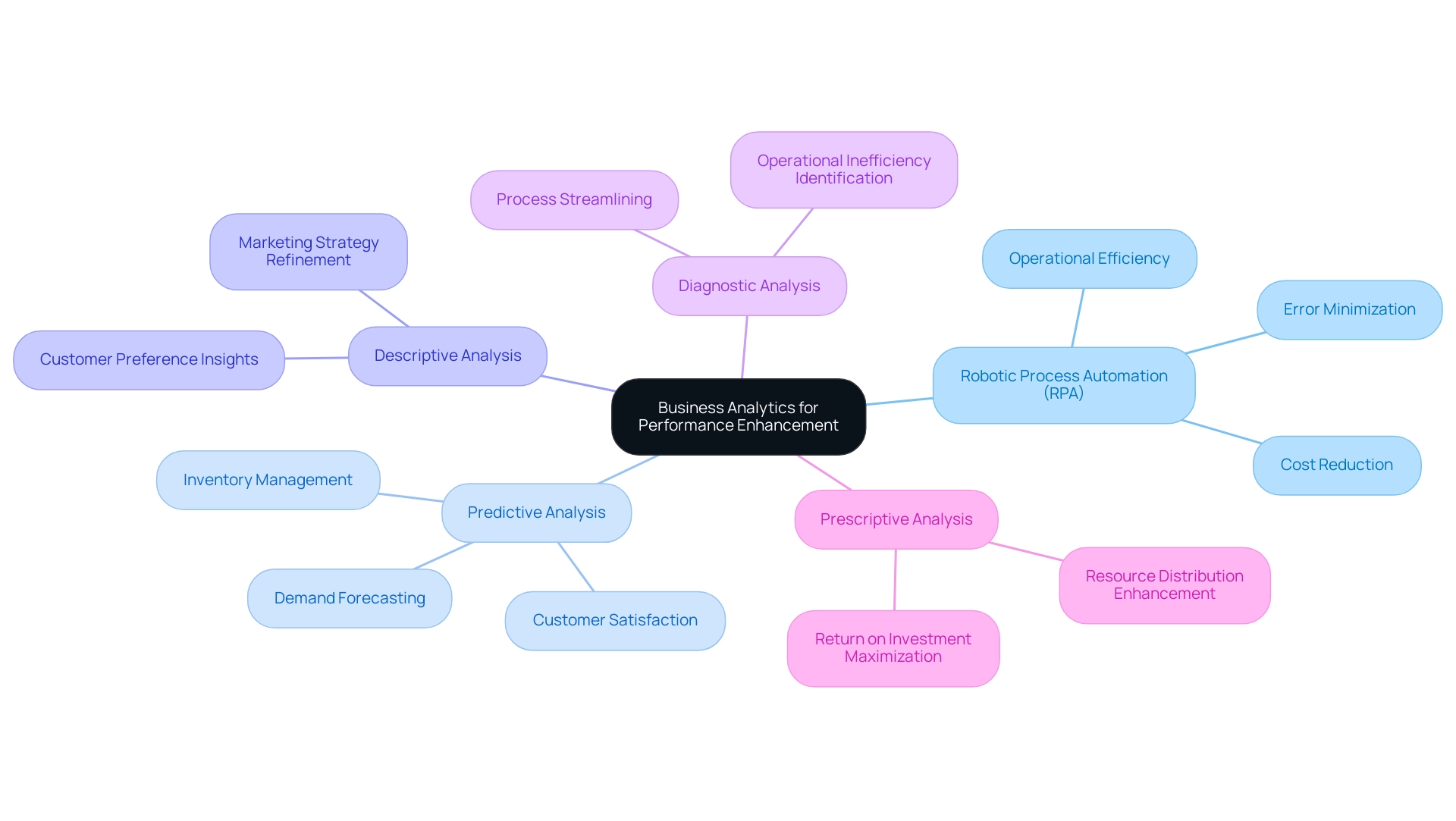
Future Trends in Business Analytics
The landscape of business analysis is undergoing a significant transformation, influenced by advancements in artificial intelligence and machine learning. These technologies not only transform how entities assess information but also enable the application of advanced predictive and prescriptive analytics capabilities. For instance, AI can automate information gathering and analysis, which is essential for addressing poor master information quality, including issues of inconsistent, incomplete, or flawed information that often hamper operational efficiency.
As numerous entities grapple with the perception that AI projects are costly, complex, and time-intensive, it is crucial to recognize how tailored AI solutions can alleviate these concerns and streamline integration into existing processes. Additionally, leveraging Robotic Process Automation (RPA) can significantly enhance productivity by automating manual workflows, allowing teams to focus on strategic initiatives. The increasing focus on real-time insights enables businesses to make rapid, informed choices based on the most recent information accessible, which is essential as 75% of executives indicate that business functions frequently compete instead of collaborating.
Moreover, the incorporation of big data technologies expands the scope of analysis, allowing entities to handle extensive datasets from various sources effortlessly. As industry leaders like Google and Alibaba invest in decision intelligence, the significance of adopting responsible data practices becomes paramount. Reports suggest that incorporating data analysis will expand considerably across multiple sectors, including healthcare, further highlighting the necessity for enterprises to adopt these advancements for a competitive advantage.
The success story of Urban Outfitters exemplifies this; by utilizing over 240 Qlik applications to monitor eCommerce sales and supply chain management, they demonstrate how cloud-based analytics can enhance operational efficiency. By embracing these trends, organizations can overcome the challenges of AI implementation and position themselves to thrive in a rapidly evolving business environment.
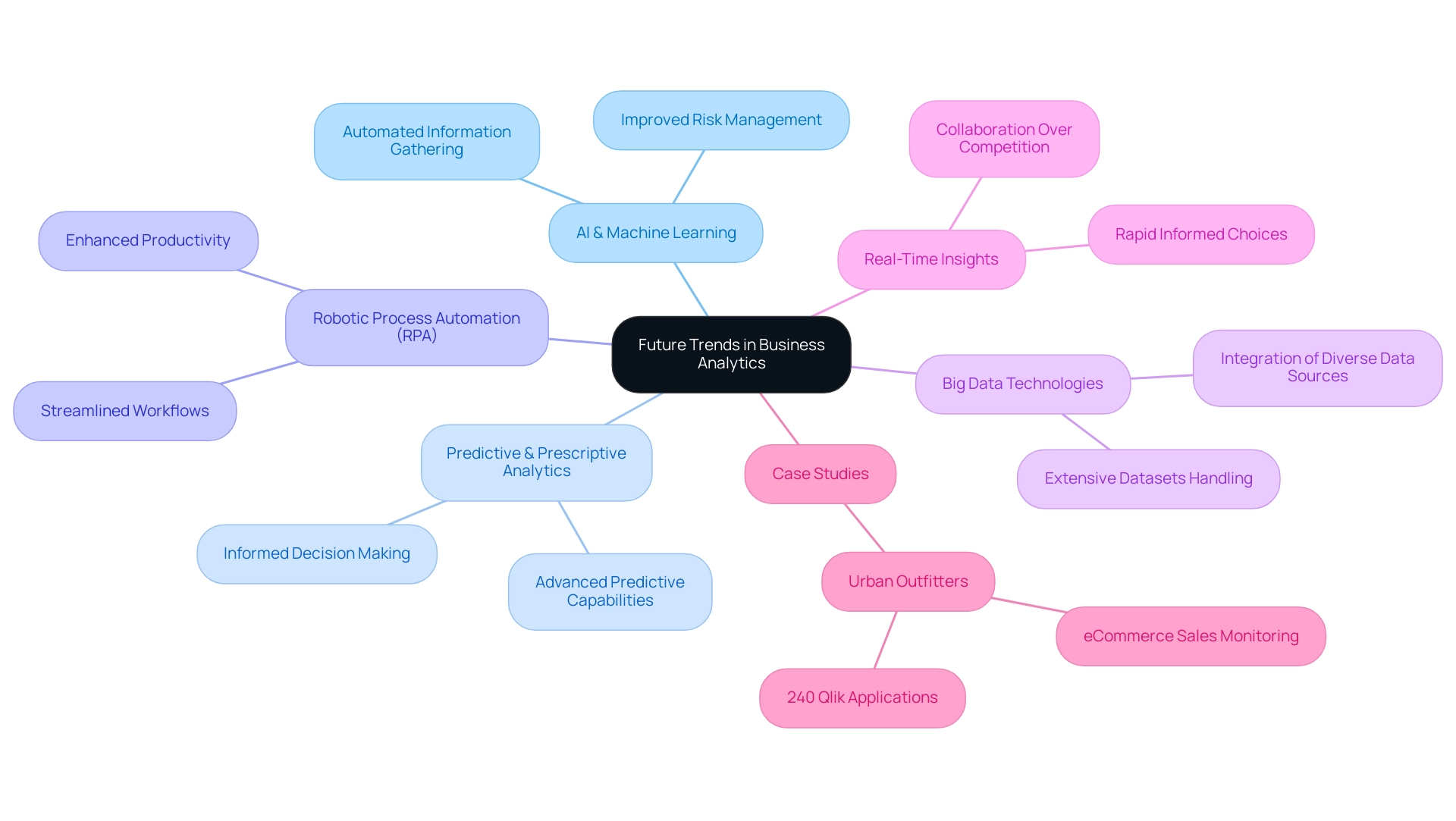
Conclusion
Embracing the diverse types of business analytics—descriptive, diagnostic, predictive, and prescriptive—empowers organizations to navigate the complexities of today’s data-driven landscape. Each type serves a unique purpose, from providing insights into past performance to forecasting future trends and recommending actionable strategies. By effectively utilizing these analytics, businesses can make informed decisions that enhance operational efficiency and drive growth.
However, the journey towards optimizing analytics is not without its challenges. Organizations must address:
– Data privacy concerns
– Ensure data integrity
– Invest in training to harness the full potential of these tools
The integration of Robotic Process Automation and tailored AI solutions can significantly alleviate these challenges, streamlining processes and enabling teams to focus on strategic initiatives rather than repetitive tasks.
The future of business analytics is promising, with advancements in AI and machine learning paving the way for more sophisticated analytical capabilities. As organizations continue to embrace these technologies, they position themselves to unlock actionable insights that can differentiate them in a competitive marketplace. By embedding analytics into their decision-making processes, businesses not only enhance their performance but also cultivate a culture of data-driven decision-making that is essential for sustained success in an ever-evolving business environment.
Introduction
In the rapidly evolving landscape of data analytics, mastering tools like Power BI is no longer optional; it is essential for organizations aiming to harness the power of their data. Effective training programs that delve into the core features of Power BI—such as data importation, transformation, and report creation—can significantly elevate an organization’s analytical capabilities.
By focusing on practical, hands-on exercises and fostering cross-departmental collaboration, companies can cultivate a culture of data-driven decision-making. Moreover, implementing robust feedback mechanisms and tracking progress ensures that training remains relevant and impactful.
As organizations navigate the complexities of data management, embracing comprehensive training strategies will not only improve operational efficiency but also empower teams to unlock valuable insights that drive success.
Understanding the Core Features of Power BI for Effective Training
Effective training PBI begins with a deep dive into its core features, which encompass importation, transformation, and report creation. Mastering information modeling is critical, as it allows users to establish relationships between various sources, significantly enhancing their capacity to generate insightful reports. The role of visual representations—such as graphs and dashboards—is paramount in making complex information comprehensible and actionable.
Training PBI sessions should prioritize the effective use of these visual tools to clearly convey information. Moreover, the significance of real-time information analysis cannot be overstated; users must understand how timely insights can influence decision-making processes. Demonstrating how to link Business Intelligence with real-time information sources enables users to obtain the most recent insights, thereby promoting more informed choices.
‘Collectiv, acknowledged as a top Microsoft consulting company, demonstrates the significance of incorporating comprehensive BI education into operational strategies, assisting organizations in developing solid information architecture and enhancing analytics procedures.’ The 3-Day BI Sprint offers a rapid framework for creating professionally designed reports, while the General Management App enhances comprehensive management and smart reviews. Moreover, the use of Small Language Models and GenAI Workshops can enhance information quality and effectiveness of preparation, ensuring that organizations can utilize AI for insightful operations.
The challenges in effectively utilizing BI dashboards, such as time-consuming report creation and data inconsistencies, highlight the necessity of structured training PBI for actionable guidance. Furthermore, addressing the lack of data-driven insights is essential for organizations to remain competitive, and RPA solutions can play a crucial role in automating repetitive tasks, thereby improving operational efficiency. As Tajammul Pangarkar, CMO at Prudour Pvt Ltd, emphasizes, ‘Understanding the core features of tools like BI is essential for driving insightful decision-making.’
As organizations continue to adapt to the evolving business intelligence landscape, embracing these educational methodologies will be instrumental in driving success.
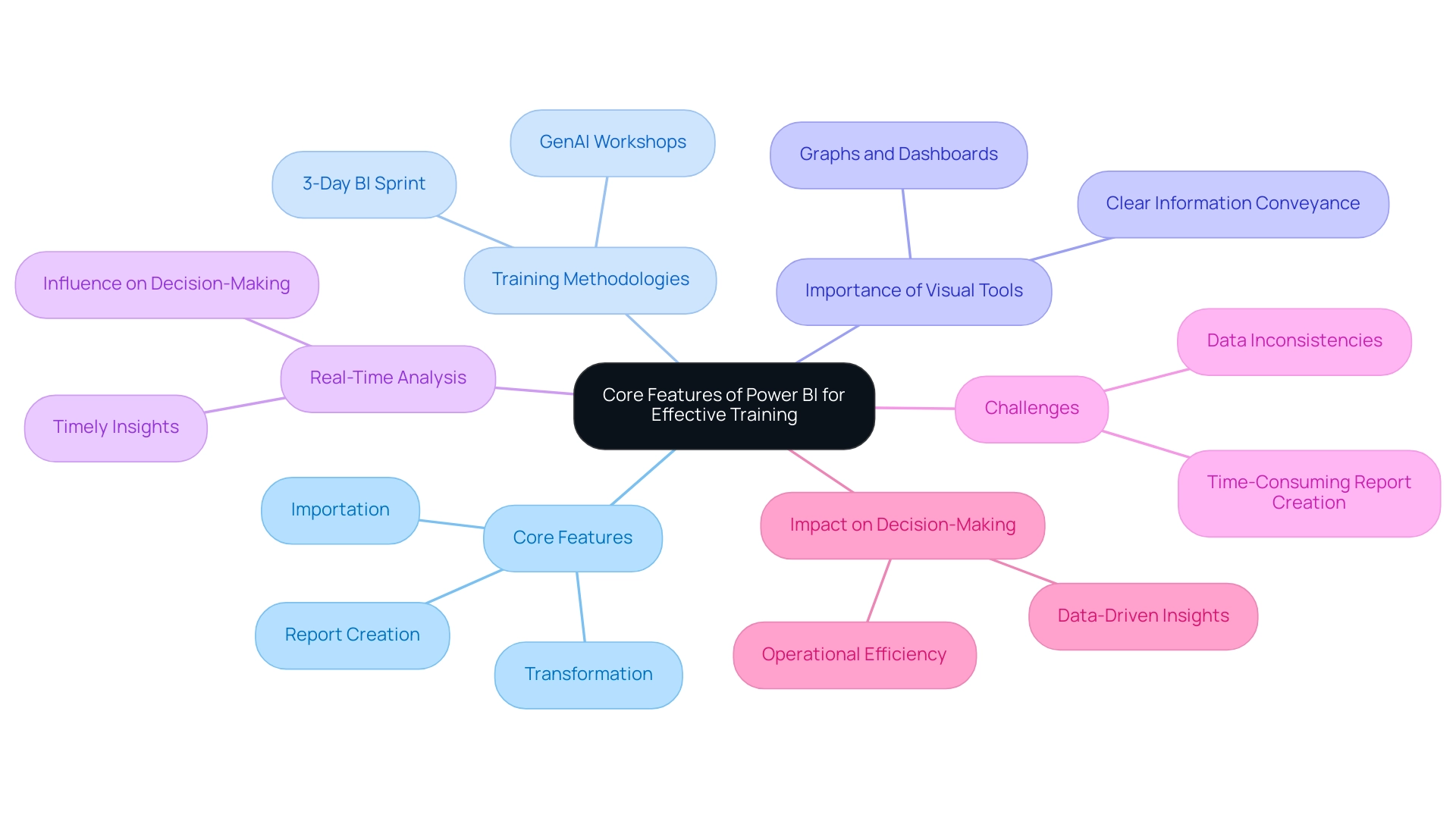
Exploring Training Resources and Community Support for Power BI
An abundance of educational resources is available to BI users, varying from official Microsoft courses to independent online platforms like Coursera and Udemy. These platforms offer structured courses aimed at fulfilling the requirements of all experience levels, ensuring that both novices and seasoned professionals can uncover relevant development opportunities. At present, the training PBI certification aligns with the PL-300: Microsoft BI Data Analyst certification, making it an excellent time for users to leverage these resources effectively.
It is essential to tackle the absence of a governance strategy, as this can result in inconsistencies that undermine the effectiveness of reports. Engaging with the Power BI community through forums, including the Power BI Community site and dedicated LinkedIn groups, can significantly enrich the learning experience, particularly in overcoming challenges like time-consuming report creation and data inconsistencies. These platforms foster collaboration, allowing users to share insights, experiences, and questions, ultimately enhancing their skill set and providing actionable guidance.
Furthermore, resources like blogs, YouTube tutorials, and webinars serve as excellent supplements to formal training, offering practical tips and strategies that users can apply immediately. Engagement in community events, such as BI user groups and meetups, not only encourages networking but also aids in knowledge sharing among peers, further enhancing the learning journey. As Jason Himmelstein aptly noted, “We encourage you to leave them on though!”
This serves as an invitation to immerse oneself in the vibrant community that supports BI users. Additionally, the recent blog entry on BI has garnered a total of 1,115 views, reflecting the growing interest in these resources. The introduction of improved information cataloging and lineage tracking features in Business Intelligence demonstrates how these educational resources can lead to effective information management and clarity in organizations, ultimately driving knowledge-based understanding and operational efficiency.
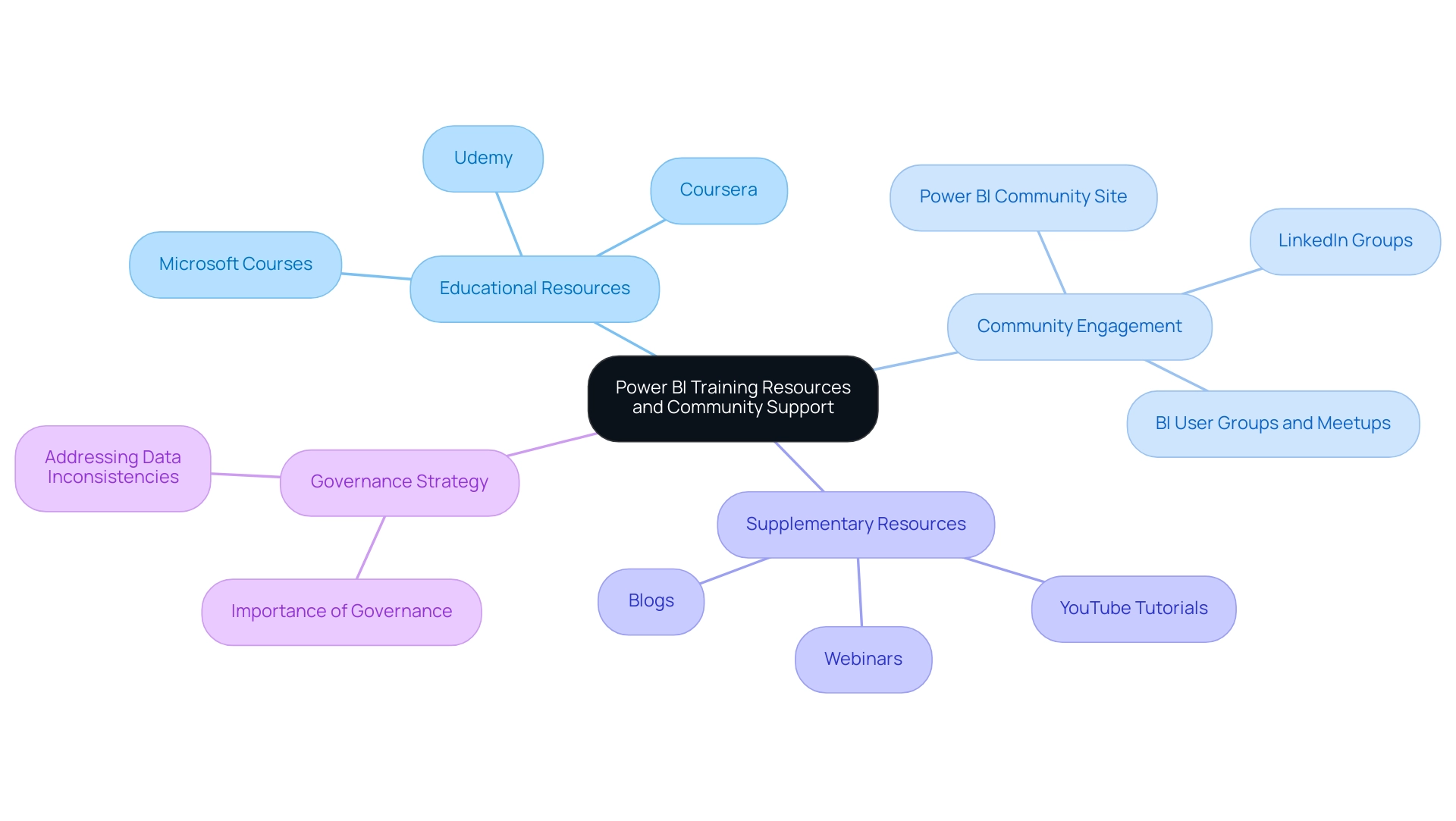
Implementing Hands-On Training Exercises for Practical Learning
Incorporating practical exercises into training PBI education programs is a transformative approach that can greatly improve learning results while tackling common obstacles in utilizing information. The Platform Fundamentals (PL-900) certification serves as an excellent starting point for those aiming to establish a career in analytics or business intelligence, providing a strong basis for training PBI. By encouraging participants to engage with real datasets that mirror their business contexts, they can create reports and dashboards that tackle genuine business challenges, moving beyond time-consuming report construction to actionable insights.
For example, a workshop could be organized where participants work together to examine sales information using BI, navigating the process of creating visualizations that offer clear, actionable insights rather than just figures and charts. This immersive approach not only reinforces their grasp of the tool but also showcases its practical applications in their daily operations, addressing issues of data inconsistencies and governance. Furthermore, introducing challenges or projects that require participants to address specific issues with BI fosters a competitive yet collaborative learning atmosphere.
To further enhance productivity, incorporating Robotic Process Automation (RPA) can streamline workflows, allowing teams to focus on high-value tasks. Furthermore, customized AI solutions can aid companies in recognizing the appropriate technologies to enhance their BI usage and educational efforts. As noted, ‘Investing in innovative educational methods not only boosts employee performance and satisfaction but also significantly contributes to organizational success.’
Such an environment underscores the significance of practical exercises in mastering analytics, supported by the case study titled ‘Practice, Practice, Practice,’ which emphasizes that proficiency in BI requires consistent training PBI and application of learned skills, ultimately leading to improved job performance and career advancement opportunities.
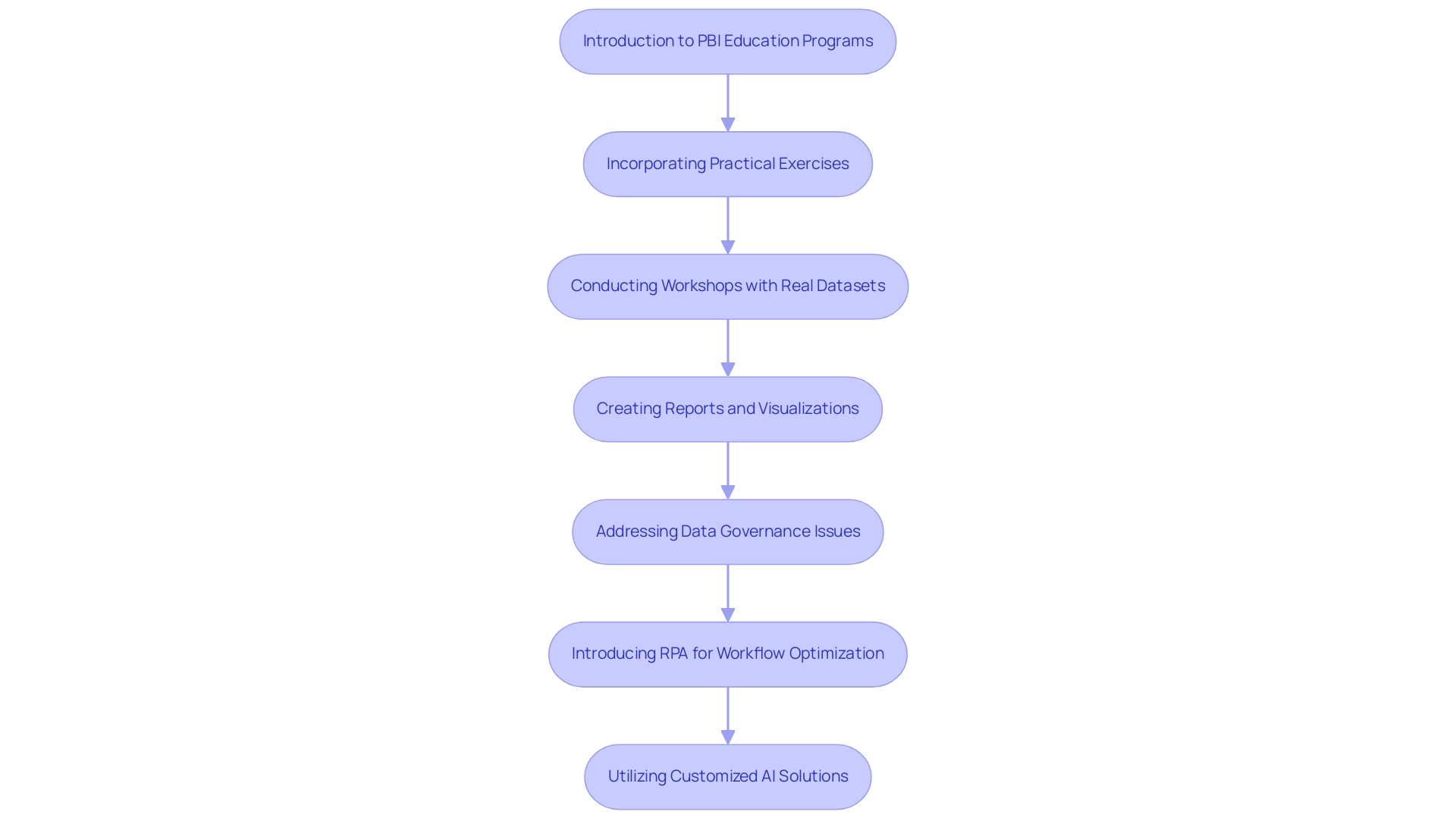
Establishing a Feedback Mechanism for Continuous Improvement
Establishing a robust feedback mechanism is vital for evaluating the effectiveness of training PBI instructional programs amidst the challenges of report creation and data inconsistencies. By systematically gathering responses from participants via surveys or interactive discussions following each session, organizations can obtain valuable information about successful aspects and areas requiring improvement. This method not only tackles common challenges but also improves participants’ capacity to utilize practical information effectively, crucial in driving operational efficiency.
Notably, organizations that prioritize feedback have reported substantial improvements in employee engagement; employees receiving regular feedback are four times more engaged at work. Furthermore, 72% of organizations acknowledge that incorporating feedback is essential for effective development, resulting in a 25% rise in employee satisfaction and a 15% enhancement in performance metrics within a year. Furthermore, integrating feedback mechanisms into our training PBI for the 3-Day BI Sprint can significantly enrich the learning cycle, ensuring that participants can apply insights effectively in their roles.
This commitment to continuous improvement, similar to the results observed in leadership development, fosters a supportive work environment that enhances employee morale and motivation. Deloitte’s findings highlight that such strategies can lower turnover rates and save companies up to $10 million in annual hiring costs. By incorporating tools like EMMA RPA and Automation, organizations can further streamline processes, ensuring that BI education remains relevant, impactful, and aligned with the evolving needs of their workforce, ultimately supporting growth and innovation.
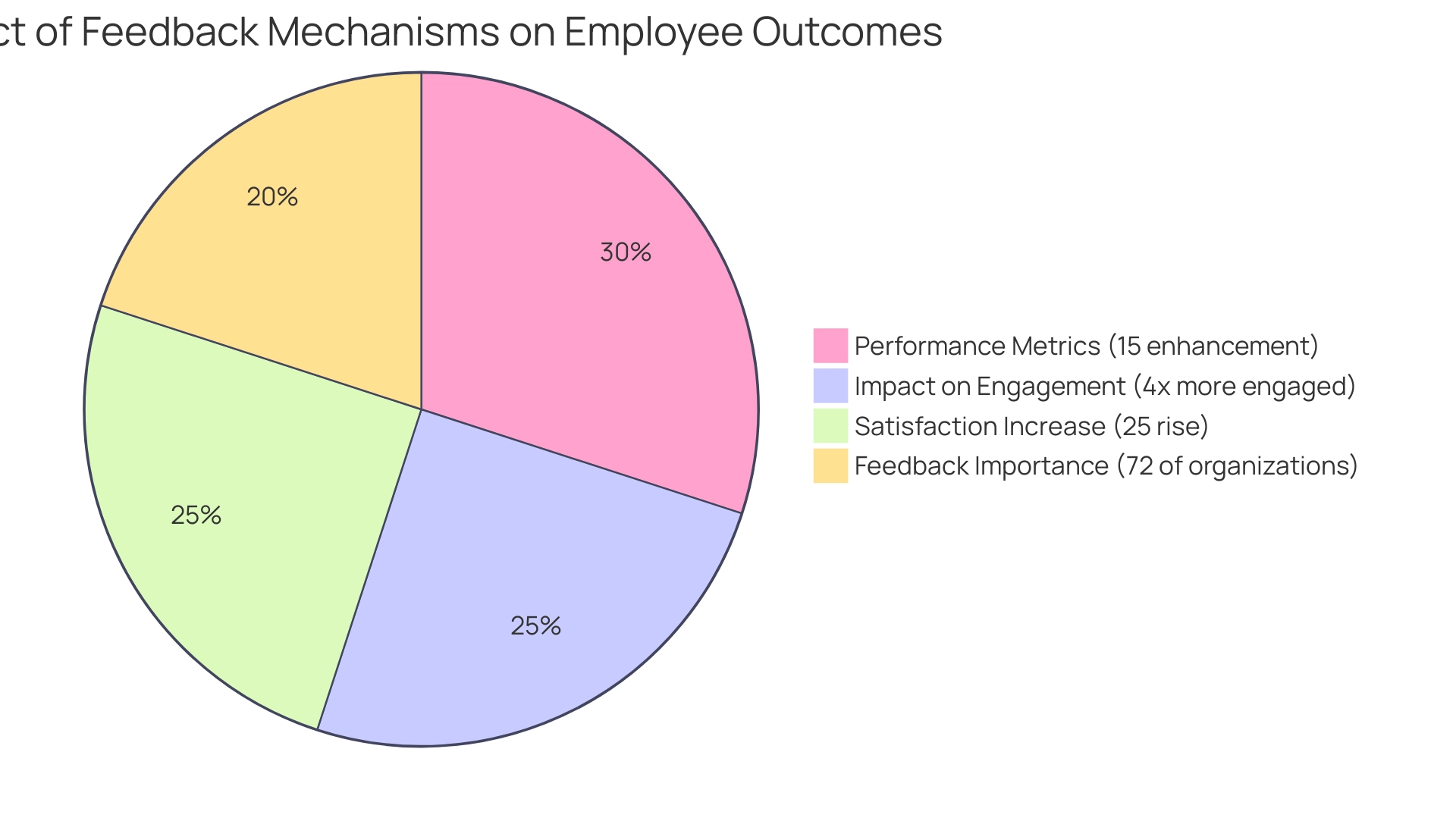
Encouraging Cross-Departmental Collaboration for Enhanced Learning
Encouraging cross-departmental collaboration during training PBI significantly enriches the learning experience and aligns with Creatum GmbH’s mission to design transformative solutions. By uniting participants from diverse functions—such as marketing, sales, and operations—trainers can encourage meaningful discussions about how each department leverages data and insights. This collective engagement not only expands users’ comprehension of Power BI’s versatility through training PBI but also cultivates a culture of shared knowledge and innovation, which is essential for driving operational efficiency.
Comprehending employee sentiments is vital in customizing these development efforts, ensuring they resonate with all participants. Statistics reveal that a staggering 86% of workforce members cite ineffective communication as a core reason for workplace breakdowns, highlighting the critical need for enhanced collaboration. Furthermore, as 75% of individuals embrace new tools to tackle business communication challenges in 2023, organizations must prioritize effective strategies in their development programs.
For instance, Pixar’s renowned ‘Braintrust’ meetings exemplify how cross-departmental feedback fosters a creative and unified environment. By arranging joint training PBI sessions where teams cooperate on projects that require input from various departments, organizations can foster a comprehensive understanding of data-driven decision-making. Moreover, incorporating Robotic Process Automation (RPA) and customized AI solutions into these educational sessions can significantly boost productivity by streamlining workflows and offering focused analyses.
This approach not only facilitates knowledge sharing but also empowers participants to learn from each other’s experiences, ultimately driving productivity and employee satisfaction. As we transition into 2024, training PBI through collaborative education in BI instruction will be crucial for leveraging the complete capabilities of varied teams, emphasizing the significance of RPA and Business Intelligence in attaining data-driven understanding and operational excellence.
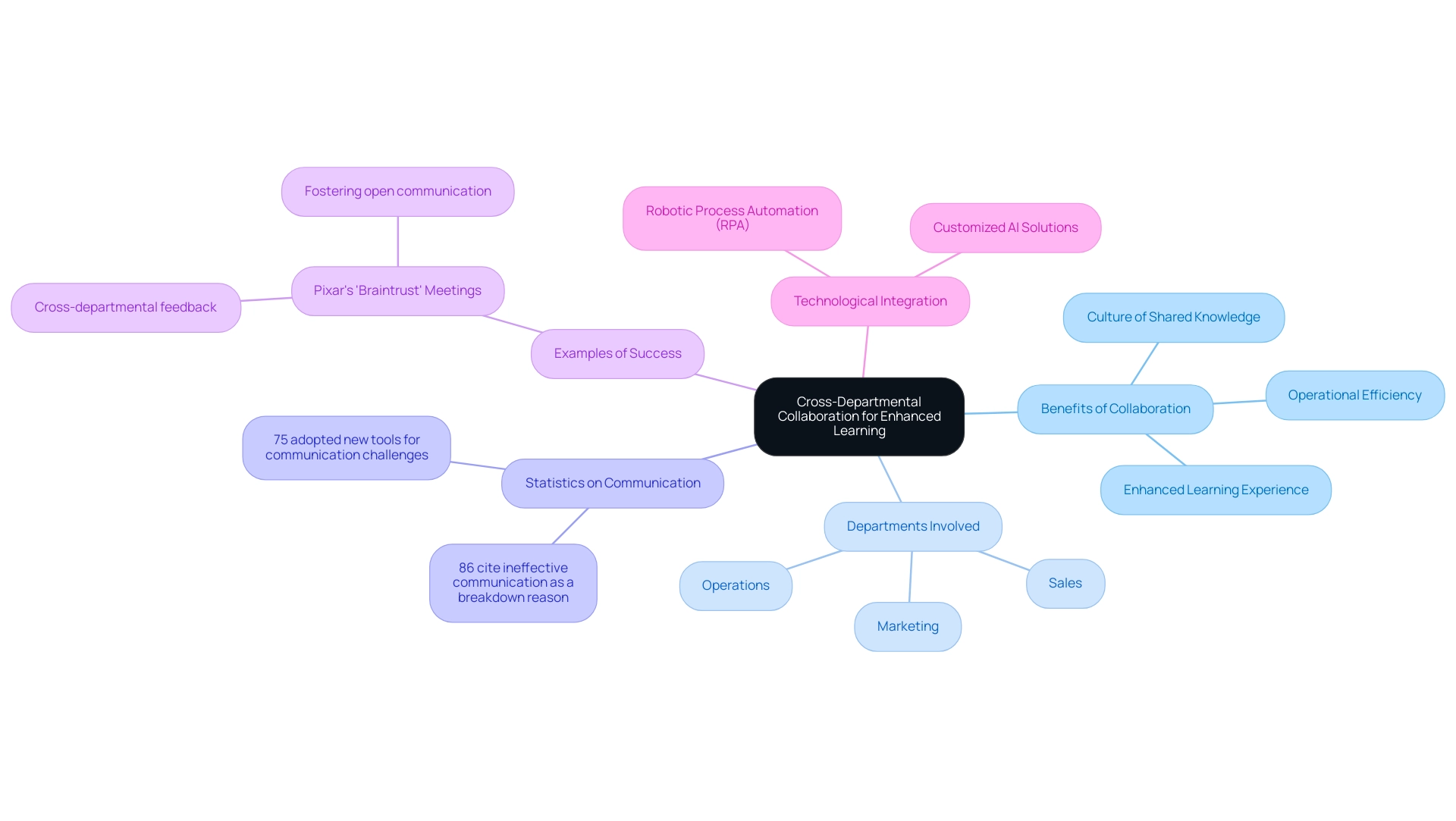
Tracking Progress and Measuring Training Effectiveness
To maximize the effectiveness of training PBI, organizations must implement robust metrics for tracking participant progress and measuring the outcomes of this training. Starting the process with pre-training evaluations enables a clear understanding of users’ initial proficiency levels, while post-training assessments offer knowledge about what has been learned. Furthermore, to truly assess the application of skills, it is essential to monitor real-world usage—such as the number of reports generated or practical conclusions derived using Power BI.
Notably, compliance course completion rates can reach as high as 95% with the use of mobile platforms, underscoring the effectiveness of flexible methods. As noted in the context of Business Intelligence, unlocking the power of information can transform raw insights into growth opportunities, which is crucial for operational success. Abhi, Head of Data Analytics, illustrates this point well:
As you can see Emma can see her goal.
Emma is a business user; she can only perform the check-in if we give status permissions to her role. Such role-based permissions promote accountability and ensure users are actively engaging with the educational material. Additionally, leveraging RPA solutions like EMMA RPA and Power Automate can enhance data collection processes and reduce report creation time, directly addressing challenges like data inconsistencies and lack of actionable guidance.
Automating repetitive tasks not only streamlines these processes but also improves employee morale by allowing staff to focus on higher-value activities. The Non-Compliance Diagnostic Tool serves as a practical example, helping management address compliance issues by mapping the number of days from registration to today against each department. Regular reviews of these metrics will unveil trends and pinpoint areas for improvement, enabling data-driven adjustments to training PBI programs.
This commitment to tracking progress underscores the organization’s dedication to continuous learning and development, fostering a culture that values skill enhancement and accountability, while simultaneously driving operational efficiency.
![]()
Conclusion
Embracing comprehensive Power BI training is vital for organizations aiming to enhance their data analytics capabilities. By focusing on the core features of Power BI—such as data importation, transformation, and effective report creation—companies can empower their teams to generate actionable insights. The integration of hands-on exercises and real-world applications ensures that users not only understand the tool but can also apply it effectively in their daily operations.
Moreover, fostering cross-departmental collaboration enriches the learning experience and cultivates a culture of shared knowledge. Engaging with training resources and community support amplifies this effect, allowing users to learn from each other’s experiences and insights. Establishing robust feedback mechanisms further enhances the training process, enabling continuous improvement and ensuring that the training remains relevant and impactful.
Ultimately, tracking progress and measuring training effectiveness are crucial steps in maximizing the benefits of Power BI training. By implementing structured metrics and leveraging automation tools, organizations can streamline their data management processes, driving operational efficiency and empowering teams to harness the full potential of their data. As the landscape of data analytics continues to evolve, prioritizing effective training strategies will be instrumental in achieving sustained success and fostering a data-driven culture.
Introduction
In a world where efficiency is paramount, automation stands as a beacon of opportunity for organizations across various sectors. As technology rapidly evolves, the integration of automation tools such as robotic process automation (RPA) and artificial intelligence (AI) is no longer a luxury but a necessity for businesses striving to enhance operational efficiency and remain competitive.
With a significant percentage of organizations still lagging in automation adoption, the potential for growth and innovation is immense. This article delves into the transformative power of automation, exploring its benefits, applications across industries, essential tools for seamless integration, and the future trends that promise to reshape the operational landscape.
By understanding and embracing these advancements, businesses can unlock new levels of productivity and effectiveness, ensuring they are well-equipped to navigate the challenges of an ever-evolving market.
Defining Automation: An Overview of Key Concepts
Automation online encompasses the application of technology to execute tasks with minimal human intervention, significantly transforming various operational landscapes. This domain encompasses advanced technologies like robotic task management (RPA), artificial intelligence (AI), and machine learning, each enhancing a more efficient workflow. For Directors of Operations Efficiency, grasping these technologies is vital, particularly as 37% of businesses presently lack the resources needed to enhance onboarding processes, highlighting a significant gap in adoption that companies must tackle.
Current trends indicate a notable shift toward automation online, with 56% of businesses leveraging mechanization and automated tools to achieve marketing objectives. As highlighted by Nick Rockwell, Content Marketing Manager, ‘According to a Camunda report, 48% of companies are implementing automated systems right now.’ This insight strengthens the necessity for companies to embrace automation online technologies to remain competitive and adaptable in an ever-evolving market.
Furthermore, organizations often hesitate to adopt AI due to concerns about complexity, cost, and integration challenges. These perceptions can lead to uncertainty about where to begin and how to effectively incorporate AI into existing systems. The case study of a mid-sized company successfully implementing GUI technology to streamline operations demonstrates how such processes can address these concerns.
The results were significant:
– Data entry errors were reduced by 70%
– Testing processes were accelerated by 50%
– Overall workflow efficiency improved by 80%
By implementing automation online, businesses can enhance operational efficiency and software quality, avoiding the risk of losing market share and ensuring innovation drives their success in a competitive landscape. Furthermore, product improvements propelled by AI and automated processes are expected to represent 45% of total economic gains by 2030, demonstrating the significant economic influence of these technologies and their importance in the present market environment.
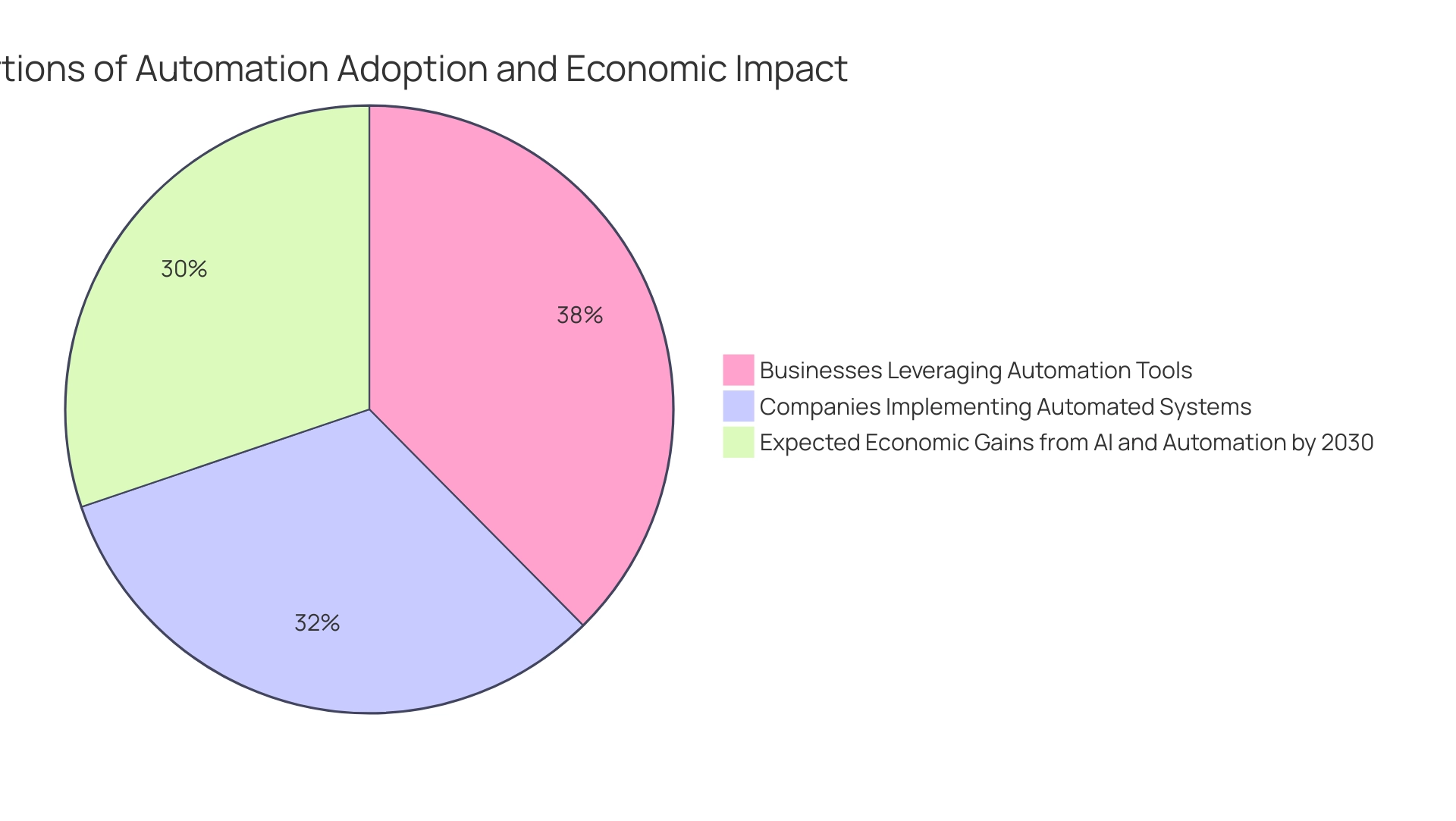
The Benefits of Automation: Enhancing Efficiency and Productivity
Implementing mechanization presents a transformative opportunity for organizations across various industries, yielding increased efficiency, reduced operational costs, and enhanced productivity. Fields such as healthcare, manufacturing, and finance are embracing workflow optimization through innovative tools like EMMA RPA and Microsoft Power Automate, which are intended to enhance productivity, reduce errors, and lower labor expenses. By utilizing automation online for repetitive tasks, businesses significantly diminish the likelihood of human error while reallocating valuable resources toward strategic initiatives.
For instance, with automation online for data entry processes, companies can slash the time dedicated to manual tasks, resulting in quicker turnaround times and improved service delivery. This trend is further backed by a HIMSS report stating that 80% of health systems intend to invest in digital healthcare solutions over the next five years, indicating a significant shift towards mechanization in the healthcare sector. Recent findings also reveal that 48% of companies are currently integrating automation online into their operations, showcasing the growing acceptance of these technologies.
The economic impact of this shift is staggering; predictions suggest that automation and AI could contribute an impressive $15.7 trillion to the global economy by 2030. Furthermore, tailored AI solutions and Business Intelligence play a crucial role in overcoming challenges like poor master data quality and outdated systems, enhancing decision-making processes. Platforms like Unmudl are empowering individuals by offering affordable, flexible courses designed with direct input from employers, ensuring that learners acquire the skills needed for real-world success in high-demand fields.
As operational efficiencies advance, entities that embrace RPA, tailored AI solutions, and Business Intelligence position themselves favorably in an increasingly competitive landscape, effectively addressing staffing shortages and outdated systems. To explore how our solutions can help your organization thrive, book a free consultation today.
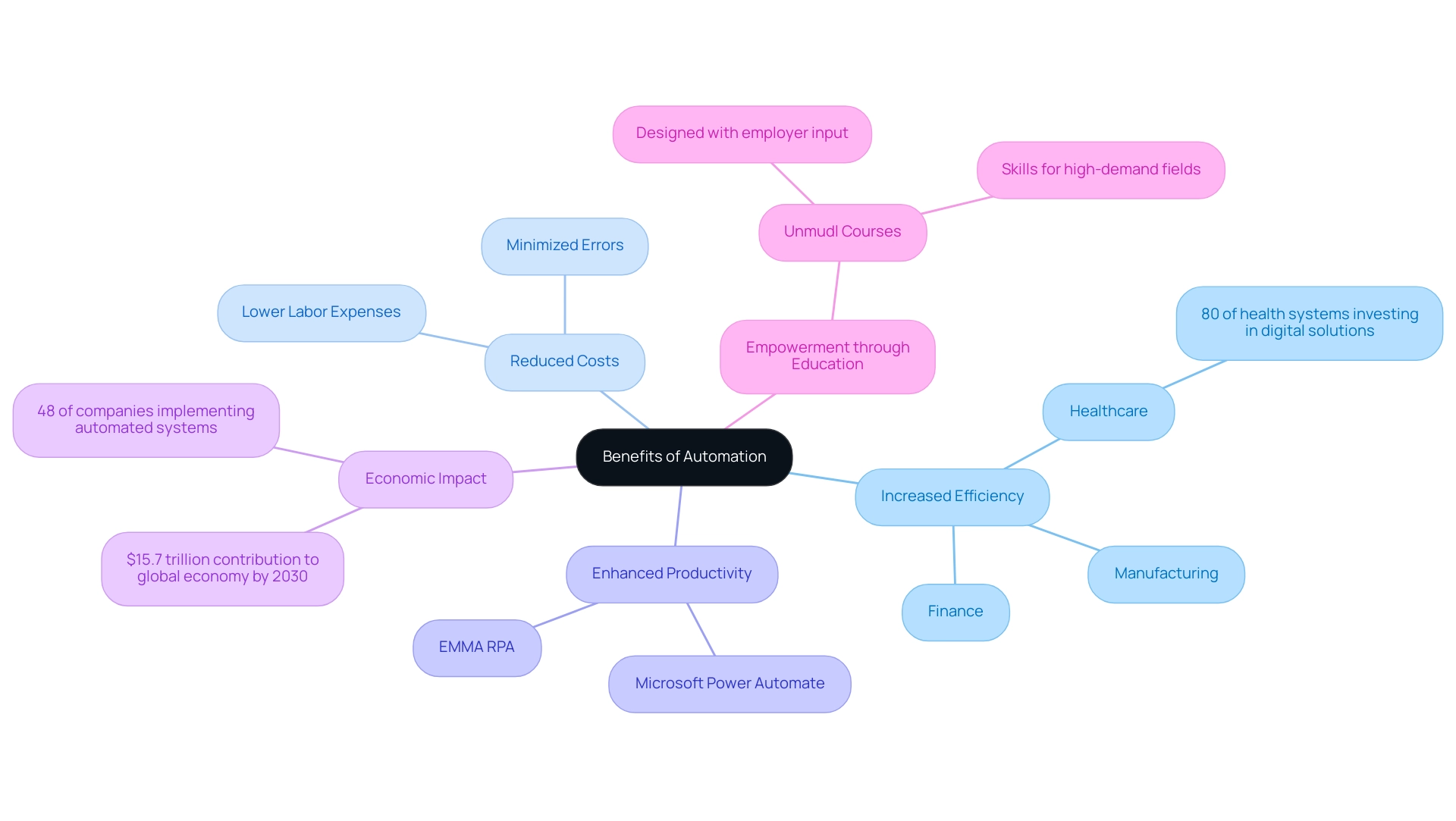
Applications of Automation Across Industries: From Marketing to Manufacturing
Automation online technologies are revolutionizing a multitude of industries, bringing efficiency and innovation to the forefront. In marketing, for example, technological tools empower businesses to execute personalized email campaigns and schedule social media posts, significantly enhancing customer engagement. Significantly, almost 37% of companies presently do not possess the technological tools required to enhance their onboarding systems, emphasizing a considerable deficiency in technology adoption.
This is especially significant as 64% of respondents from enterprise organizations intend to create technologies focused on enhancing employee experience, including automation online for various tasks such as onboarding and offboarding. In manufacturing, leveraging Robotic Process Automation (RPA) is instrumental in facilitating robotic assembly lines, which not only speed up production but also ensure consistency in output while reducing errors and freeing up team members for more strategic tasks. Moreover, in finance, automation online plays a critical role in streamlining processes such as invoice processing and compliance reporting, thereby reducing manual errors and improving accuracy.
As emphasized by Tidio, almost 70% of recruiters regard AI as an essential resource for reducing unconscious bias in hiring, further highlighting the wide-ranging relevance of technology across industries. By unlocking the power of Business Intelligence, entities can transform raw data into actionable insights, enabling informed decision-making that drives growth and innovation. This diverse range of applications illustrates how tailored AI solutions can be customized to meet specific business challenges, ultimately enhancing operational efficiency and fostering innovation.
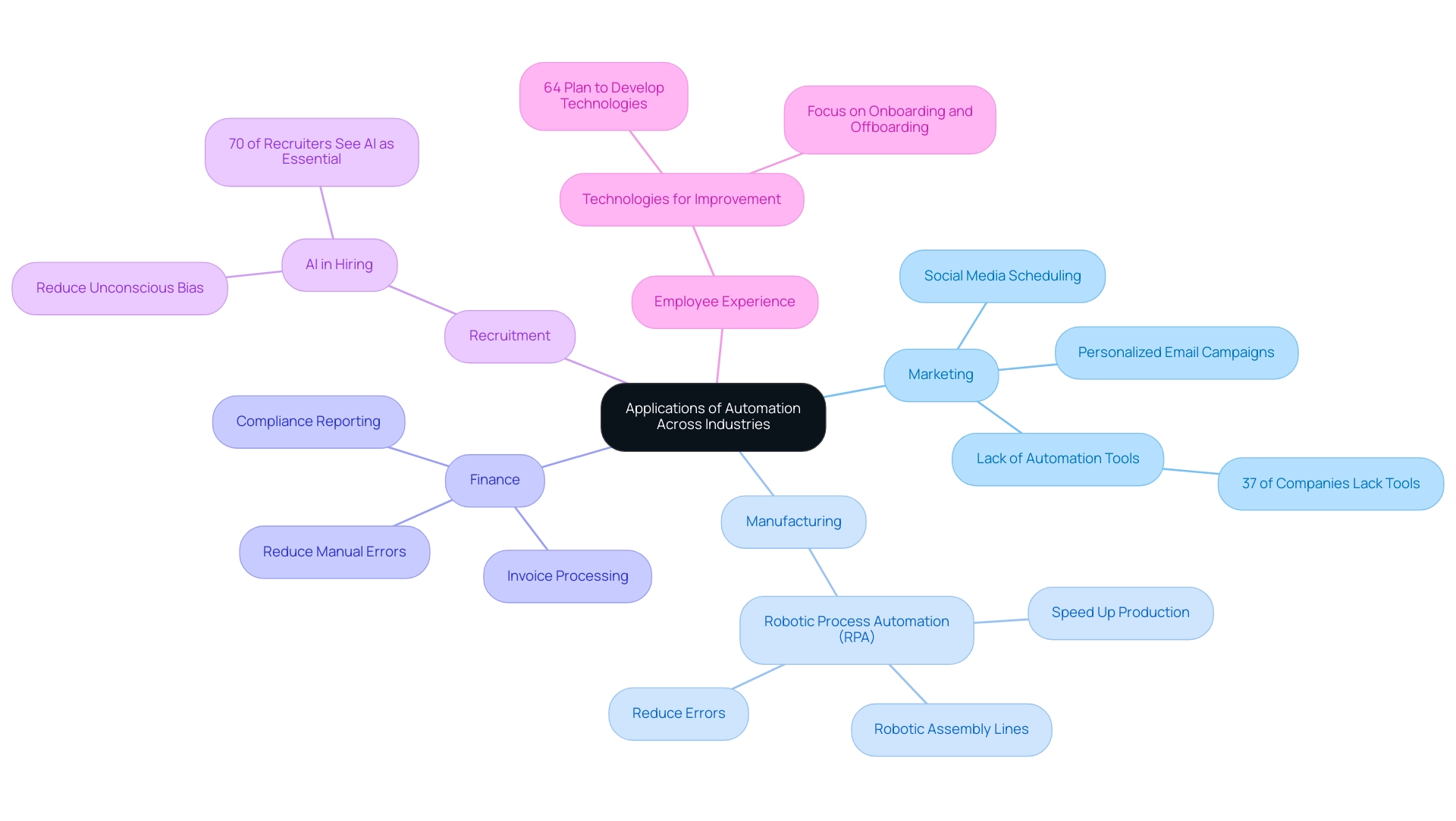
Key Automation Tools and Platforms: Enabling Seamless Integration
To effectively execute mechanization, organizations must utilize various essential resources and platforms. Robotic Process Automation (RPA) software, notably UiPath and Automation Anywhere, are instrumental in addressing workplace challenges such as repetitive tasks and staffing shortages, empowering businesses to utilize automation online for mundane operations across a myriad of applications. This not only significantly enhances operational efficiency but also transforms workflows, freeing up valuable human resources for more strategic tasks.
Moreover, configuration management applications such as Ansible enable the mechanization of IT operations, simplifying software deployment and guaranteeing prompt system updates. For example, Mobot provides its services beginning at $1,500 monthly per action, with a 30-day free trial, making it a reachable choice for entities eager to improve their operational capabilities. Mobot’s innovative application of mechanical robots for automated mobile app testing demonstrates how such resources can result in higher quality and bug-free releases.
Grasping and employing these resources is vital for organizations dedicated to attaining smooth incorporation of automation online into their workflows. Furthermore, modernizing outdated systems is critical; RPA can play a key role in this transformation, ensuring that businesses remain competitive and agile. As mentioned by XENON HOLDINGS, ‘Their comprehensive test cases and efficient system updates impressed us the most,’ illustrating the positive impact of strong technological tools on both performance and security.
Moreover, the case study titled ‘AI-Powered Automation in Testing’ highlights how AI-driven systems not only enhance exploratory testing but also enable real-time KPI tracking, ultimately leading to improved software quality and accelerated development cycles. Customized AI solutions and business intelligence are also essential for informed decision-making, enabling organizations to utilize data effectively in their strategies.

The Future of Automation: Trends and Innovations to Watch
The future of mechanization is poised for remarkable advancements, driven by innovations in artificial intelligence, machine learning, and the Internet of Things (IoT). As these technologies evolve, automation online systems will increasingly excel in managing complex tasks with heightened intelligence. The synergy of AI with Robotic Process Automation (RPA) will not only facilitate automation online for routine tasks, reducing the burden of manual, repetitive processes but also streamline intricate decision-making processes and predictive analytics.
This evolution is vital for enhancing operational efficiency through automation online, while also addressing critical labor challenges, particularly in sectors like manufacturing where a shrinking workforce poses significant hurdles. Significantly, a staggering 80% of health systems plan to invest in digital healthcare solutions over the next five years, highlighting the urgency for entities to embrace these trends. A compelling case study illustrates this need: one healthcare office achieved over $4,000 in monthly savings by utilizing automation online for paper-based tasks, showcasing the tangible financial benefits of embracing digital solutions.
As 68% of non-users are from the Gen X or Baby Boomer demographics, there is a pressing need for targeted strategies to engage these groups in adopting new technologies. Additionally, organizations that fail to keep pace with these advancements risk falling behind their competitors. Those that actively leverage tailored AI solutions and automation online will be strategically positioned to gain a competitive edge in their industries.

Conclusion
Embracing automation is not merely an option; it is an essential strategy for organizations aiming to thrive in today’s fast-paced environment. The integration of technologies such as robotic process automation (RPA) and artificial intelligence (AI) has proven to enhance operational efficiency, reduce costs, and drive productivity across various sectors. With a significant portion of businesses still lacking adequate automation tools, the potential for growth and innovation is vast.
The benefits of automation are clear: from minimizing human error to reallocating resources towards strategic initiatives, organizations that adopt these technologies are better equipped to navigate the complexities of modern markets. Industries ranging from healthcare to finance are already witnessing transformative results through the implementation of tailored automation solutions. As highlighted, the economic impact of automation is projected to be monumental, contributing trillions to the global economy by 2030.
Looking ahead, the future of automation is bright, with advancements in AI and machine learning set to revolutionize how businesses operate. Organizations must stay ahead of the curve, leveraging the latest tools and platforms to ensure seamless integration and continued competitiveness. By embracing these innovations, businesses will not only enhance their operational landscapes but also secure their position as leaders in an ever-evolving marketplace. The time to act is now; those who harness the power of automation will unlock unparalleled opportunities for success.
Introduction
In an age where efficiency and productivity are paramount, content automation tools are emerging as game-changers for organizations striving to optimize their operations. These innovative solutions streamline content creation, management, and distribution, allowing businesses to shift their focus from mundane tasks to strategic initiatives that drive growth.
With a significant percentage of companies already embracing marketing automation, the benefits are clear:
– Reduced manual effort
– Improved data quality
– Enhanced overall performance
However, as organizations navigate the complexities of integrating these tools, understanding their diverse applications and potential impacts becomes essential. This article delves into the landscape of content automation, exploring its various types, benefits, and future trends, while providing actionable insights for leveraging these technologies effectively within workflows.
Defining Content Automation Tools: An Overview
Content production applications are vital software programs that enhance and simplify different elements of content generation, management, and distribution. These automate tools empower organizations to significantly reduce manual effort while enhancing overall productivity and maintaining consistent quality across all outputs. By utilizing mechanization, businesses can redirect their focus towards strategic initiatives rather than getting bogged down by repetitive tasks, which is crucial in addressing common concerns related to poor master data quality that often hinder AI adoption.
This shift not only optimizes resource allocation but also maximizes time efficiency. Interestingly, despite 40% of companies utilizing both promotional technology and a Customer Data Platform (CDP), these systems are frequently not connected, highlighting a major opportunity for enhancement in operational efficiency. The importance of material processing resides in its capability to enhance workflows and allow teams to create high-quality outputs at scale.
As mentioned by HubSpot, approximately 3 in 4 businesses are now employing marketing technology, highlighting its increasing significance in modern operations. Moreover, with 50% of marketers using these resources daily, it is clear that the automate tool is becoming a fundamental aspect of successful operational strategies. However, it is essential to recognize the concerns regarding technology; 39% of sales professionals not utilizing AI systems cite over-reliance as a significant issue.
Additionally, the case study ‘Streamlining Operations with GUI Automation’ illustrates how a mid-sized company improved efficiency by utilizing an automate tool for data tasks, reducing errors by 70%, and achieving a remarkable ROI within 6 months. This case study highlights the importance of addressing poor master data quality, which can complicate AI integration and lead to misconceptions about the complexity and cost of AI projects. This multifaceted perspective highlights the necessity for organizations to balance the advantages of content generation with an awareness of its broader effects, ultimately enabling them to overcome the perceived complexities and costs related to AI adoption.
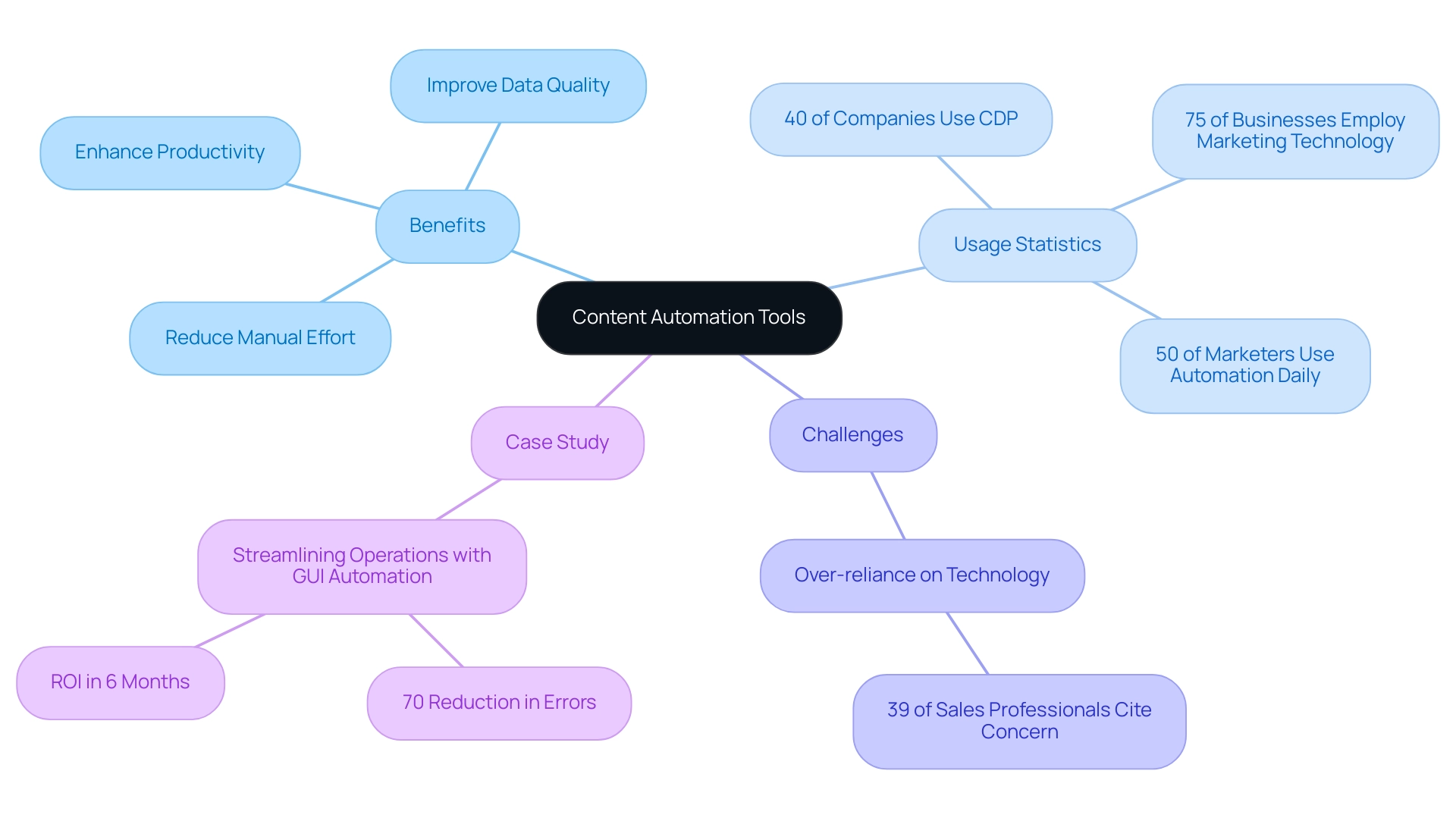
Exploring Different Types of Content Automation Tools
Content management resources are essential for optimizing business procedures and improving operational effectiveness. Among these, Robotic Process Automation (RPA) solutions like EMMA RPA and Microsoft Power Automate serve as an automate tool that effectively handles repetitive tasks, thereby improving employee morale and addressing challenges such as task repetition fatigue and staffing shortages. EMMA RPA offers features such as intelligent task management and seamless integration with existing systems, while Microsoft Power Automate provides user-friendly workflows that enable rapid execution of routine tasks.
These instruments can be classified into several essential categories:
- AI-driven generators, which create written material based on user-defined prompts.
- Scheduling solutions that utilize an automate tool for posting information across various social media platforms.
- Analytics applications that provide valuable insights into performance.
Furthermore, organizations can gain advantages from a range of applications, including the use of an automate tool for social media, email promotion platforms, and material curation resources. Each of these serves a distinct purpose, enabling businesses to optimize various stages of the content lifecycle.
Significantly, as of 2024, the growing use of RPA solutions indicates a change in how businesses manage their operations, with marketing teams at the forefront in utilization. This shift underscores the increasing dependence on mechanization, allowing organizations to improve their efficiency and adjust to current trends in the marketplace. With the rapid advancement of AI-driven technology, integrating RPA and Business Intelligence into operational strategies is essential for driving data-driven insights, staying competitive, and achieving long-term success.
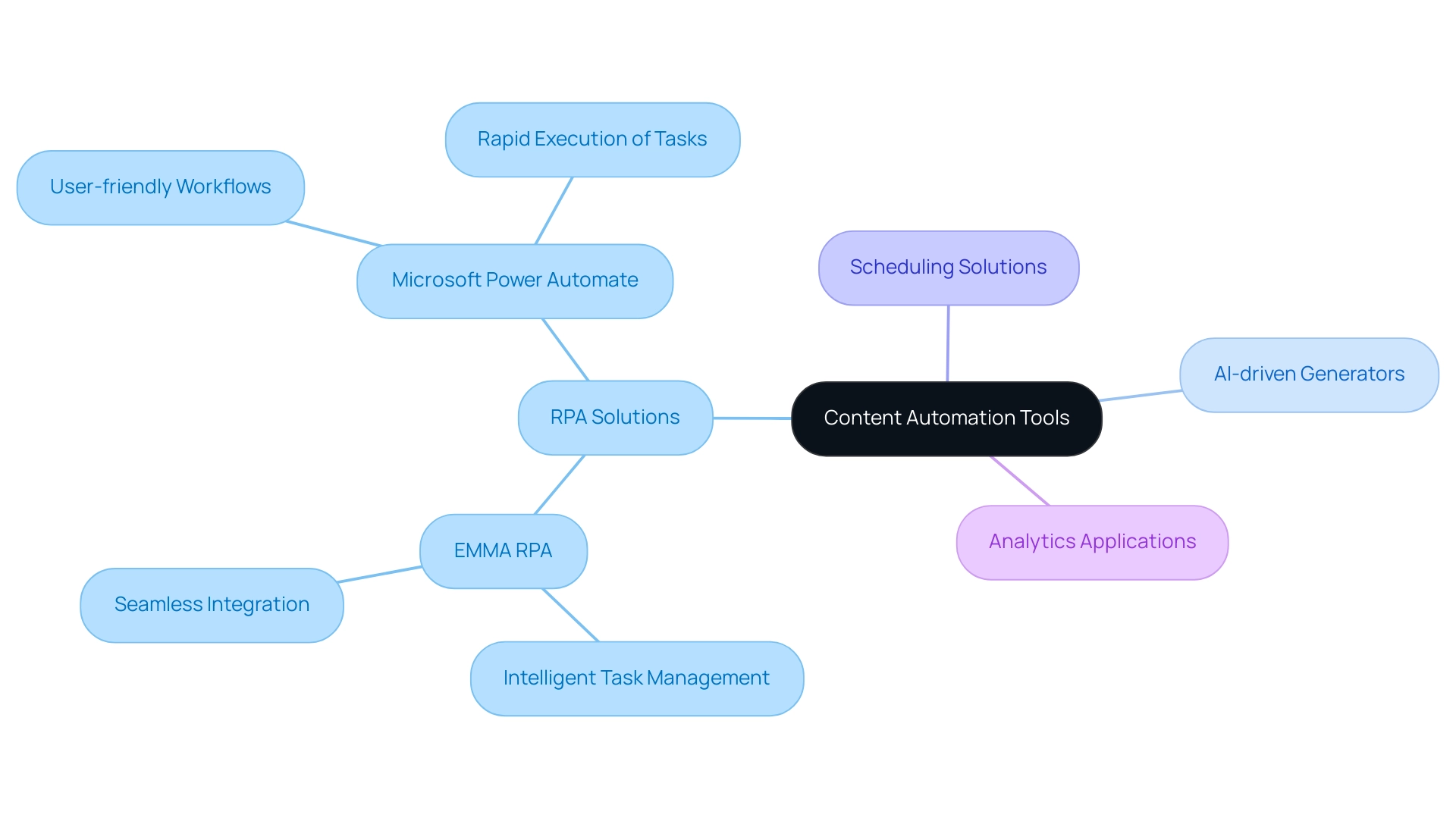
The Benefits of Implementing Content Automation
The introduction of content management solutions provides a transformative chance for companies, delivering various advantages that enhance efficiency, lower expenses, and improve content quality. With 56% of enterprises currently employing promotional technology and 50% of advertisers using these automate tools daily, the trend is undeniably shifting towards mechanization. In fact, the marketing automation industry has seen significant revenue growth, with leading players continually innovating their automate tool offerings to meet market demands.
By utilizing an automate tool to automate repetitive tasks through Robotic Process Automation (RPA), organizations can drastically expedite the creation and distribution processes, while also reducing errors, allowing teams to reallocate their focus towards higher-value activities such as strategic planning and creative development. This shift not only leads to operational cost reductions but also enhances the overall quality of content produced. As emphasized by Oracle, promotional software can lead to a significant 14.5% rise in sales productivity, highlighting its potential effect.
Furthermore, companies that incorporate these automate tools often experience quicker turnaround times and enhanced audience engagement. Importantly, with 40% of B2B companies considering adoption soon, there is a growing urgency to embrace these technologies. However, a significant gap persists, as only 18% of B2B advertisers currently utilize process optimization in conjunction with a customer data platform (CDP), while 42% lack a CDP in their tech stack.
Tackling this integration gap is vital for enhancing the efficiency of material generation initiatives and realizing significant cost reductions, particularly considering recent budget adjustments in the promotional technology sphere. Additionally, as the AI landscape continues to evolve, businesses face challenges in identifying suitable solutions for their needs. By leveraging tailored AI solutions and harnessing Business Intelligence, companies can transform raw data into actionable insights that support informed decision-making, thus driving growth and operational efficiency in this rapidly evolving landscape.
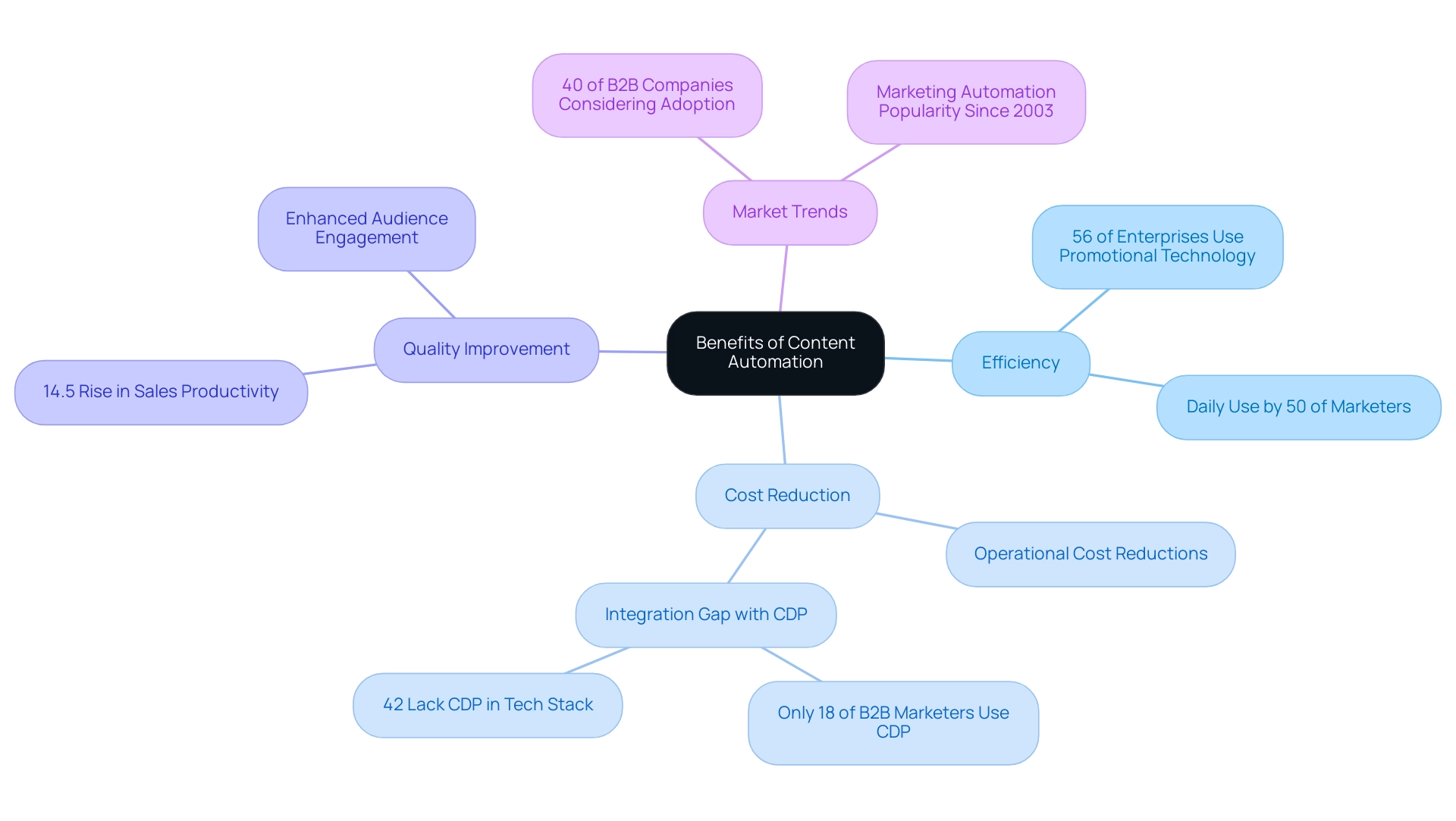
How to Effectively Use Content Automation Tools in Your Workflow
To leverage the full capability of content generation resources in your workflow, start by using an automate tool to identify repetitive tasks that are ready for streamlining, such as content scheduling and social media posting. With 50% of advertisers actively utilizing promotional systems daily, the appropriate resources can greatly improve your efficiency. For instance, the case study titled ‘Marketing Technology’s Time-Saving Benefits’ reveals that marketing technology saves companies over six hours per week on routine tasks like social media posting and email marketing.
Choose automation solutions like Robotic Process Automation (RPA) resources, which can serve as an automate tool for data entry and reporting processes, enhancing efficiency and decreasing errors. Implement these solutions in stages to allow your team to acclimate to the new processes. Ongoing assessment of performance is essential; analytics applications can offer insights into which content types connect most effectively with your audience, enabling a data-driven modification of your strategy.
Significantly, 74% of marketers report time savings from using an automate tool to handle repetitive tasks, emphasizing the importance of these resources. This approach not only streamlines operations but also contributes to an average reduction of operational costs by 12.2%. Furthermore, addressing talent retention challenges is vital; by alleviating the burden of mundane tasks through RPA, you can enhance job satisfaction and retain key personnel.
Considering the present growth of the promotional technology sector, now is a favorable moment to embrace these tools and improve your operational efficiency while navigating the swiftly changing AI environment.
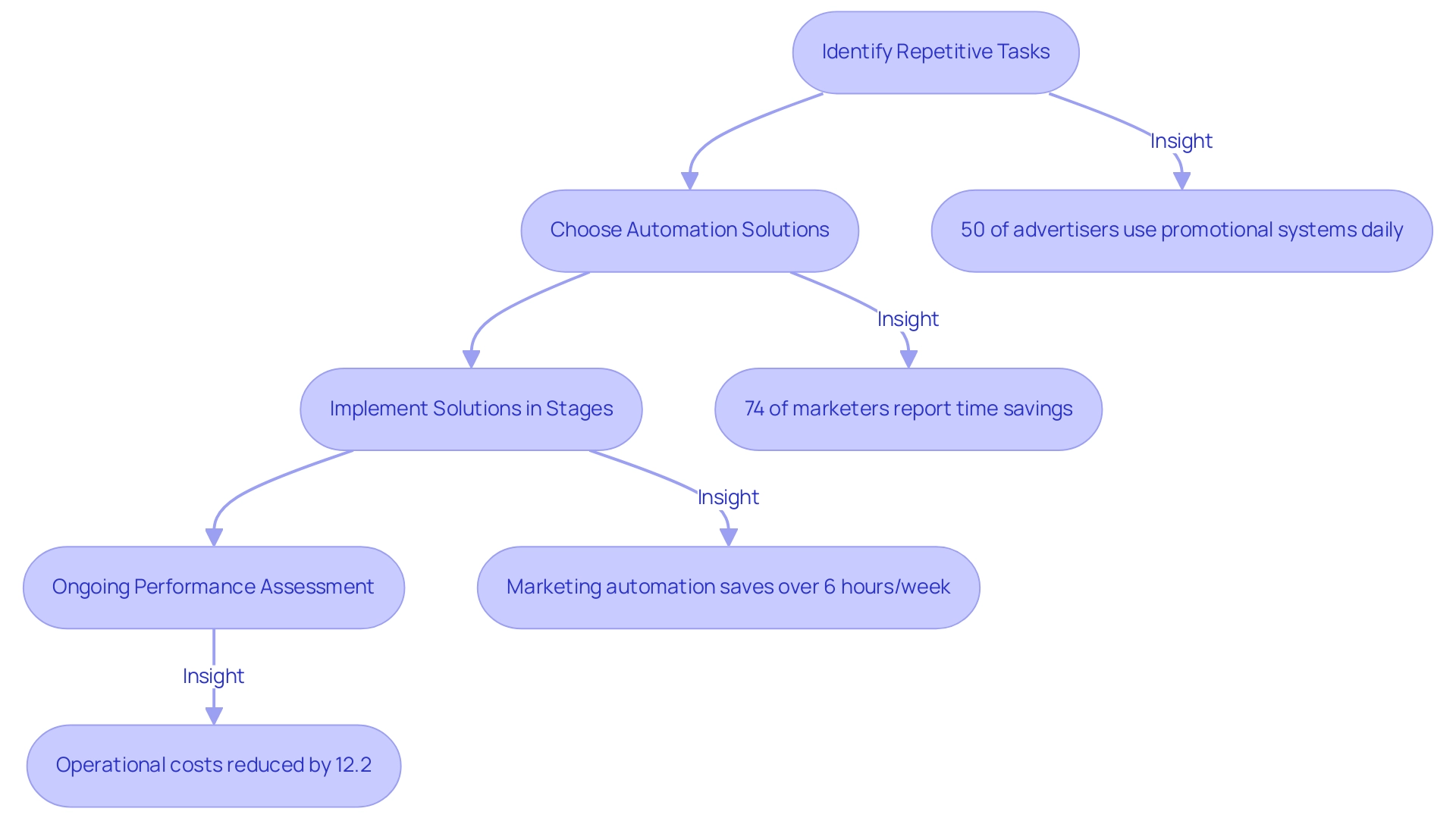
Future Trends in Content Automation: What to Expect
The future of content generation is set for remarkable evolution, particularly through advancements in artificial intelligence and machine learning. These technologies, including Robotic Process Automation (RPA), are revolutionizing the way organizations use an automate tool to automate manual workflows, enhancing operational efficiency and productivity while also significantly reducing costs. As noted, the integration of tailored AI solutions will empower businesses to analyze data and refine strategies in real-time, driving informed decision-making.
RPA not only streamlines processes but also reduces errors, allowing team members to focus on more strategic, value-adding tasks. With promotional technology employing AI experiencing a 250% rise in 2023, the momentum for RPA and Business Intelligence is undeniable. Nick Rockwell, a Content Marketing Manager, aptly states,
In today’s fast-paced world, not implementing innovations will result in stagnation and decline.
Significantly, 81% of top marketers now utilize a single platform for promotional processes, emphasizing the increasing reliance on these instruments. As the automate tool becomes increasingly intuitive and user-friendly, we can anticipate a surge in adoption across various industries. This aligns with findings from Act-On’s survey, where 58% of marketers identified quality data as the most effective tactic enhanced by marketing automation platforms.
Furthermore, Business Intelligence plays a crucial role in transforming raw data into actionable insights, enabling businesses to make informed decisions that drive growth and innovation. The combination of RPA and Business Intelligence will utilize an automate tool to drive further innovation and efficiency in content creation, paving the way for a more personalized and impactful digital landscape.
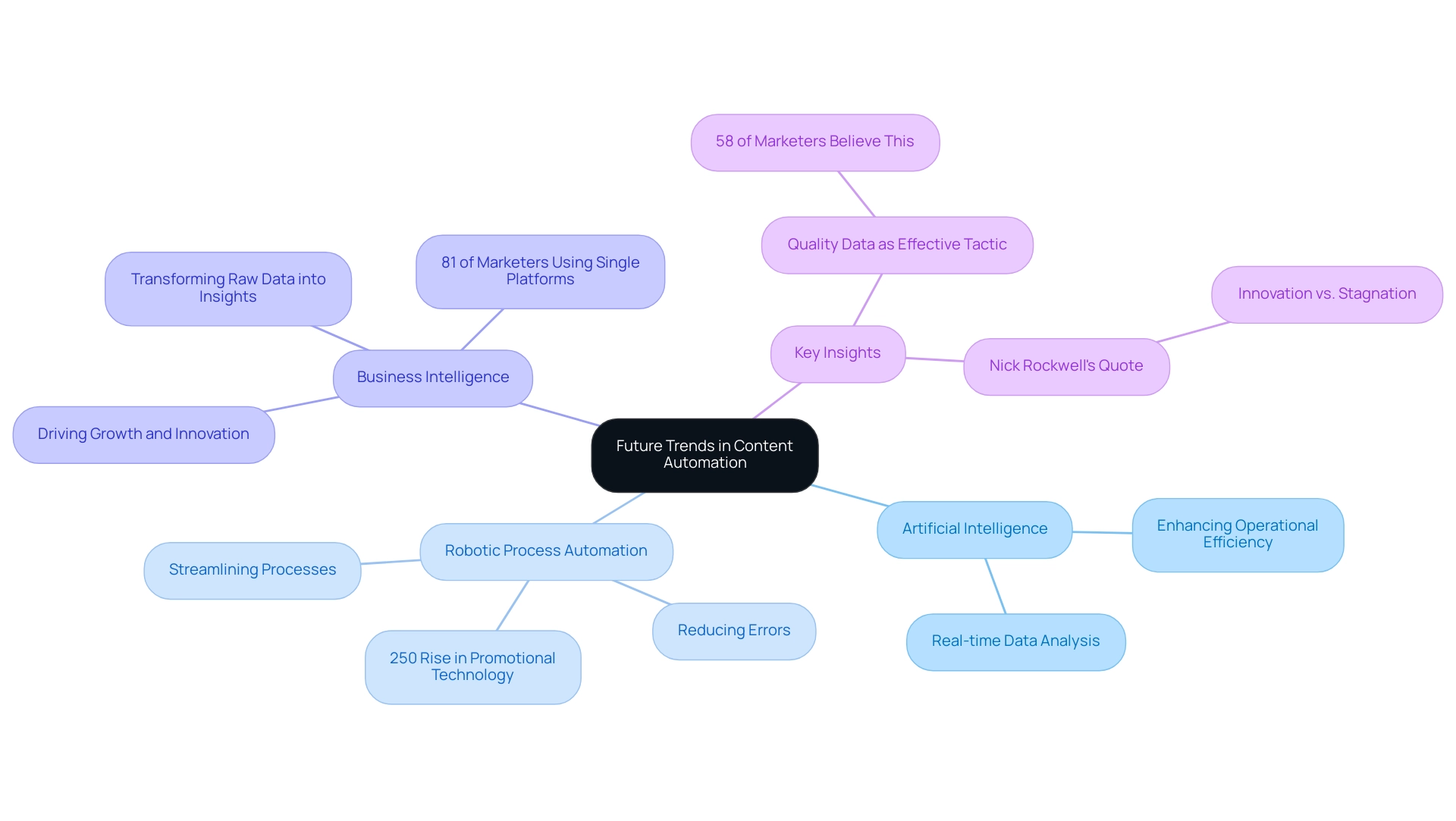
Conclusion
Embracing content automation tools is not just a trend; it is a strategic necessity for organizations looking to enhance efficiency and productivity. By automating repetitive tasks, businesses can significantly reduce manual effort, improve data quality, and ultimately elevate the quality of their content. The diverse types of content automation tools available, from Robotic Process Automation (RPA) to AI-powered content generators, provide organizations with the means to streamline their workflows, allowing teams to focus on strategic initiatives that drive growth.
As highlighted throughout the discussion, the benefits of implementing these tools are substantial. Organizations that adopt content automation experience:
- Faster turnaround times
- Improved audience engagement
- A notable increase in sales productivity
The integration of these technologies not only addresses operational inefficiencies but also empowers teams to leverage their creativity and strategic thinking. The case studies presented demonstrate the tangible impact that effective content automation can have on reducing errors and optimizing resource allocation.
Looking ahead, the future of content automation is bright, with advancements in AI and machine learning poised to further transform how organizations operate. As the reliance on these tools continues to grow, it is crucial for businesses to stay ahead of the curve and integrate tailored solutions that meet their specific needs. By doing so, organizations can navigate the complexities of the digital landscape with confidence, ensuring they remain competitive and responsive to market demands. The time to act is now—leveraging content automation tools is essential for achieving operational excellence and driving sustainable growth in today’s fast-paced business environment.
Introduction
In a world inundated with data, the ability to transform information into actionable insights is paramount for organizations striving to maintain a competitive edge. Data analytics has emerged as a powerful tool, enabling businesses to navigate the complexities of their operations and make informed decisions.
However, the journey towards effective data utilization is fraught with challenges, including data integrity issues and the fear of adopting advanced technologies like artificial intelligence.
By understanding the different types of data analytics—descriptive, diagnostic, predictive, and prescriptive—organizations can unlock the full potential of their data, driving operational efficiency and fostering innovation.
This article delves into the nuances of each analytical type, providing practical strategies for overcoming common obstacles and leveraging data to achieve strategic goals.
As the landscape of data technologies continues to evolve, embracing these insights will be essential for organizations aiming to thrive in an increasingly data-driven world.
Understanding Data Analytics: An Overview
Information analysis includes the systematic computational examination of information, utilizing statistical and logical methods to describe, summarize, and compare information sets. In a time when information is plentiful, companies are increasingly utilizing various types of data analytics to derive actionable insights that promote informed decision-making, improve operational efficiency, and encourage innovation. Nevertheless, challenges like inconsistent, incomplete, or flawed information can result in AI implementation stagnation, hindering companies from completely utilizing the capabilities of their information.
Many organizations perceive AI projects as time-intensive, costly, and complex, which further exacerbates their hesitance to adopt these technologies. As emphasized in a recent analysis of information traits, companies dependent on insight-driven conclusions must prioritize information integrity for effective decision-making. A compelling case study on a mid-sized company illustrates how implementing GUI automation transformed their operations; by reducing entry errors by 70% and accelerating workflow efficiency by 80%, they overcame significant barriers to operational success.
Additionally, the overall worth of investments in FinTech firms globally in 2022 reached $226.5 billion, an increase from $127.7 billion in the prior year, highlighting the increasing dependence on types of data analytics for fostering business success. The emergence of technologies like web scraping has transformed the extraction and enhancement of Points of Interest (POI) information, ensuring precision and promptness in analysis. As we look toward 2024, the latest trends in types of data analytics indicate a growing emphasis on automation and the integration of robotic process automation (RPA) to streamline routine tasks, thus further enhancing operational efficiency.
Significantly, 68% of individuals who do not utilize information analysis are Gen X or Baby Boomers, emphasizing a generational gap in the adoption of such tools. Adopting information analysis through different types of data analytics is not merely an option but a requirement for enterprises seeking to utilize their information for strategic efforts and operational enhancements, particularly in addressing the concerns linked to AI accessibility.
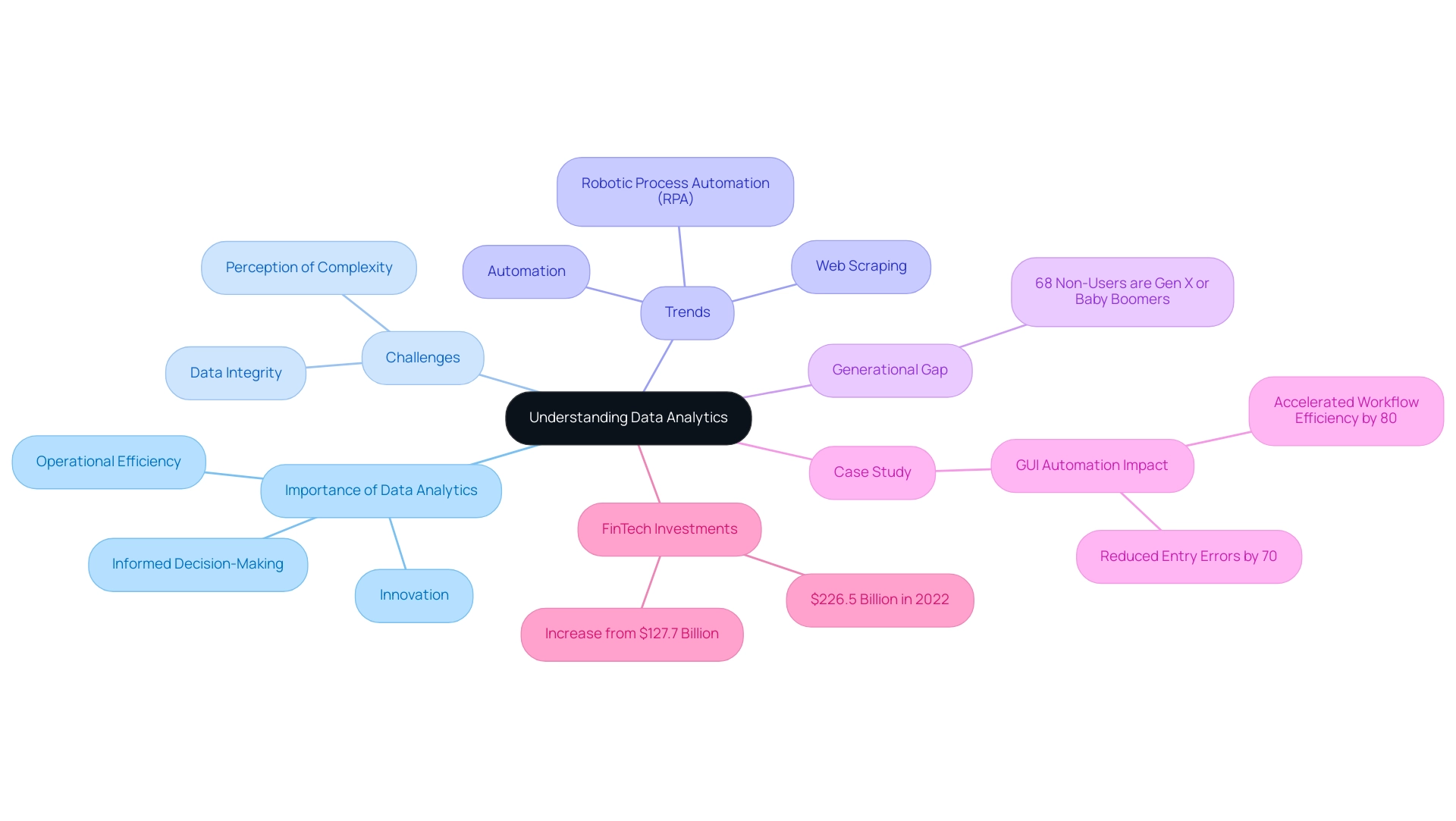
The Four Main Types of Data Analytics: Descriptive, Diagnostic, Predictive, and Prescriptive
In the field of information analysis, organizations can utilize four main types, each serving a specific purpose:
- Descriptive Analytics: This foundational type focuses on analyzing historical information to uncover trends and patterns, enabling businesses to understand what has happened over time. By distilling complex datasets into actionable insights, descriptive analysis lays the groundwork for informed decision-making. As we approach 2025, it’s estimated that consumers will possess a 36% share of information, highlighting the importance of these insights.
- Diagnostic Analytics: Building on descriptive insights, diagnostic analytics delves into past performance to elucidate the reasons behind certain outcomes. This type is essential for organizations seeking to comprehend the ‘why’ behind their information, facilitating more strategic responses to challenges faced. It is noteworthy that 85% of Singaporean business leaders experience decision distress but believe that information can enhance decision-making and reduce risk.
- Predictive Analytics: Utilizing statistical models and machine learning techniques, predictive analytics forecasts future outcomes based on historical information. This forward-looking approach empowers organizations to anticipate market changes and adapt strategies proactively, reducing uncertainty in decision-making processes. Utilizing AI technologies, such as tailored Small Language Models for efficient analysis and enhanced privacy, along with GenAI workshops for custom GPT creation, can significantly improve predictive capabilities and enhance quality.
- Prescriptive Analytics: This advanced type goes beyond prediction by recommending specific actions based on information analysis. By simulating various scenarios, prescriptive analysis guides organizations in making informed choices that align with their strategic goals. The integration of Business Intelligence tools, such as Power BI services—which include a 3-Day Power BI Sprint for quickly creating professionally designed reports and a General Management App for comprehensive management and smart reviews—allows for enhanced reporting and actionable insights, further aiding in operational efficiency.
As the landscape of information technologies expands—driven by innovations like the Internet of Things (IoT), which is projected to generate a staggering 79.4 zettabytes of information by 2025—the significance of these analytical types becomes increasingly essential. The exponential growth of information technologies is being driven by new advancements that enhance transmission, reception, and storage, as illustrated by the IoT’s contribution to the volume of big information generated. With 57% of enterprises appointing a chief information officer and 59% employing system administrators, the necessity to integrate these insights effectively into operations has never been clearer.
Embracing all four types not only enhances organizational efficiency but also positions companies to harness the full potential of their data-driven strategies, including streamlined workflows through Robotic Process Automation (RPA) and tailored AI solutions that navigate the overwhelming technology landscape.
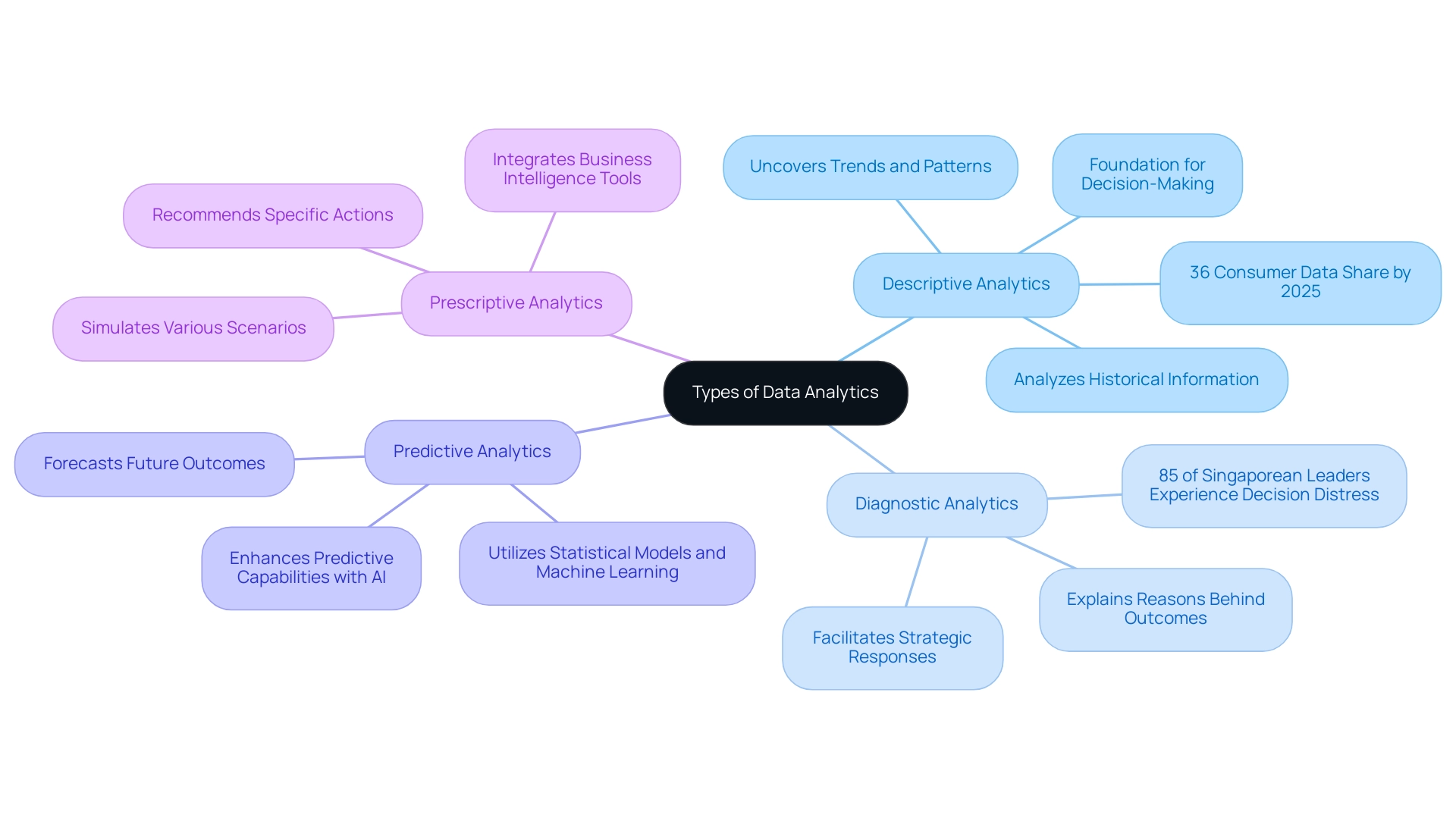
Descriptive Analytics: What Happened and Why It Matters
Descriptive analytics is one of the types of data analytics that plays a crucial role in organizational intelligence, concentrating on summarizing historical information to offer insights into past performance. In an era where the AI landscape can feel overwhelming, businesses often struggle to identify the right technologies that align with their specific needs. Utilizing customized AI solutions is essential for cutting through the noise and ensuring that entities can effectively employ information.
By utilizing advanced information visualization techniques—such as dashboards and comprehensive reports—companies can present insights in an easily digestible format. For instance, a retail organization might examine last year’s sales figures to uncover trends and seasonal patterns, enabling evidence-based decisions for future strategies. Recent studies indicate that retailers utilizing types data analytics are significantly more effective, with marked improvements in their marketing efforts.
Significantly, 54% of companies are considering using cloud-based BI tools in their analytics, underscoring the growing acknowledgment of its significance. A successful example is Narellan Pools, an Australian swimming pool manufacturer, which gathered and examined five years of marketing information, leading to a 23% rise in sales in one year while utilizing only 70% of its media budget. This illustrates the critical significance of historical information analysis in driving operational efficiency and enhancing decision-making processes.
Additionally, Netflix’s use of data analysis illustrates the potential for significant cost savings, achieving $1 billion in savings each year through effective data utilization. As the data analysis landscape evolves, adopting descriptive analysis types data analytics is not merely beneficial but essential for businesses aiming to thrive in a competitive market.
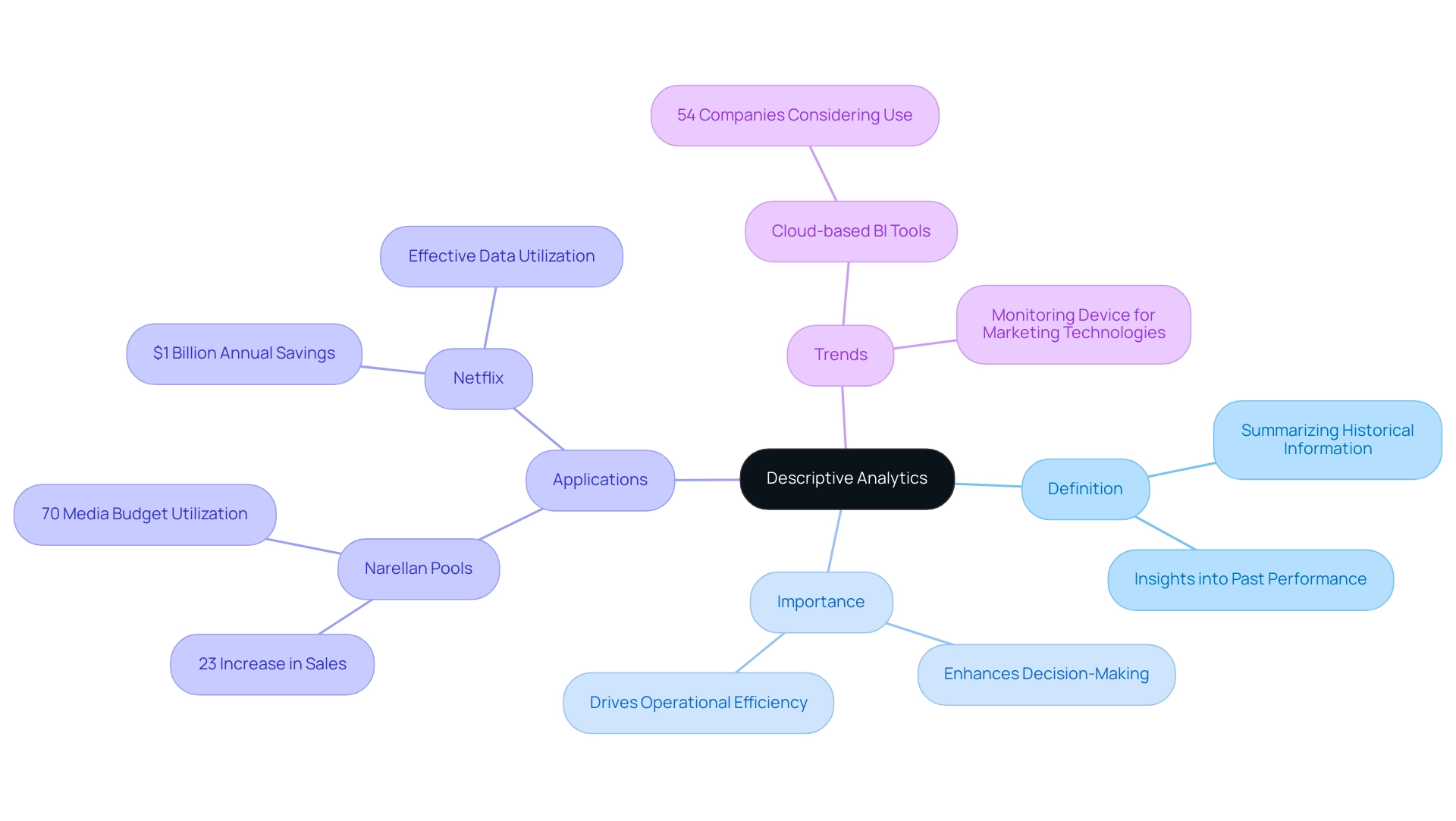
Diagnostic Analytics: Why Did It Happen?
Diagnostic analysis elevates the analytical process beyond mere description by delving into the factors that drive past outcomes. This approach utilizes sophisticated techniques, including data mining and correlation analysis, to reveal the intricate relationships between various variables in different types of data analytics. For example, when a company notices a sales decline, diagnostic analysis can identify contributing factors such as changes in customer preferences or issues in marketing strategies.
According to a survey conducted in December 2021:
- 90% of organizations utilize cloud-based applications, which emphasizes the technological environment that supports types of data analytics.
- A remarkable 81% of companies assert that information should be central to their decision-making processes, underscoring the necessity of these insights.
MedStar Health exemplifies this application through its collaboration with Zephyr AI, where they leveraged de-identified type 2 diabetes information to enhance predictive analytics capabilities.
As MedStar Health emphasizes, understanding the underlying ‘why’ behind these events is crucial for organizations to devise targeted strategies to rectify issues and improve performance. To further amplify these insights, leveraging Robotic Process Automation (RPA) can streamline the collection and analysis of information, significantly reducing errors and freeing up teams to focus on strategic initiatives rather than manual tasks.
Leading players in the industrial data analysis market, including:
- Robert Bosch GmbH
- Hitachi Ltd.
- Amazon Web Services
- Siemens AG
- Microsoft Corporation
are at the forefront of deploying such solutions, driving innovation and market growth.
As the environment of diagnostic examination continues to advance, keeping up with the latest information mining techniques and integrating RPA will be essential for operational success, especially for Directors of Operations Efficiency confronting the challenge of optimizing workflows and improving decision-making processes using types of data analytics.
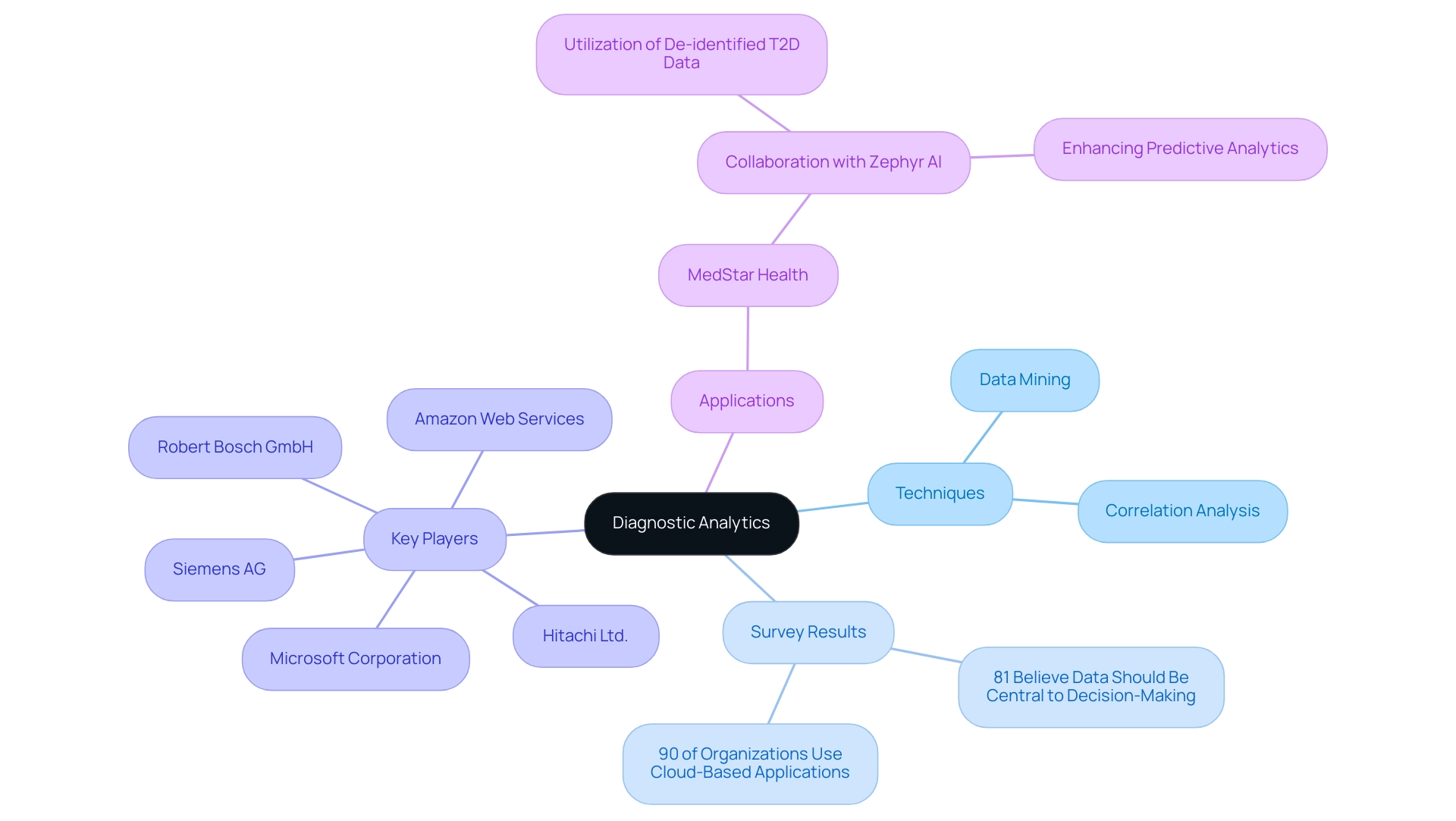
Predictive Analytics: What Will Happen Next?
Predictive analysis harnesses the power of statistical algorithms and advanced machine learning techniques to forecast future outcomes by examining historical data. For instance, financial institutions can leverage predictive data analysis to evaluate the risk of loan defaults by scrutinizing past borrower behaviors. This approach not only allows organizations to anticipate potential challenges but also to capitalize on emerging opportunities within types of data analytics, thereby significantly enhancing strategic planning and operational efficiency.
With the services revenue in this sector projected to reach $24.0 billion by 2032, the financial implications of predictive analytics are becoming increasingly evident. Furthermore, as businesses adapt to a rapidly evolving AI landscape, tailored AI solutions, including Small Language Models and GenAI Workshops, along with Robotic Process Automation (RPA), are essential for driving productivity. For example, organizations can streamline workflows through RPA, automating manual tasks to reduce errors and free up resources for more strategic initiatives.
This synergy between predictive insights and RPA is crucial for informed decision-making and operational excellence. Significantly, with the Natural Language Processing market projected to hit $36 billion in 2024, the use of predictive analysis is poised to grow more advanced. A MicroStrategy report indicates that 43% of businesses recognize the competitive advantage gained through the strategic use of various types of data analytics, underscoring its critical role in navigating today’s fast-paced business landscape.
Furthermore, Gartner forecasts that by the end of the year, 60% of information used by AI and analysis solutions will be synthetic content, highlighting the advancing methods in this domain. A relevant case study is UC Davis Health, which successfully implemented synthetic information generation with a $1.2 million grant for disease forecasting, illustrating how predictive analysis is being applied in practice and enhancing the credibility of its applications. To explore how these customized AI solutions can benefit your company, book a free consultation today.
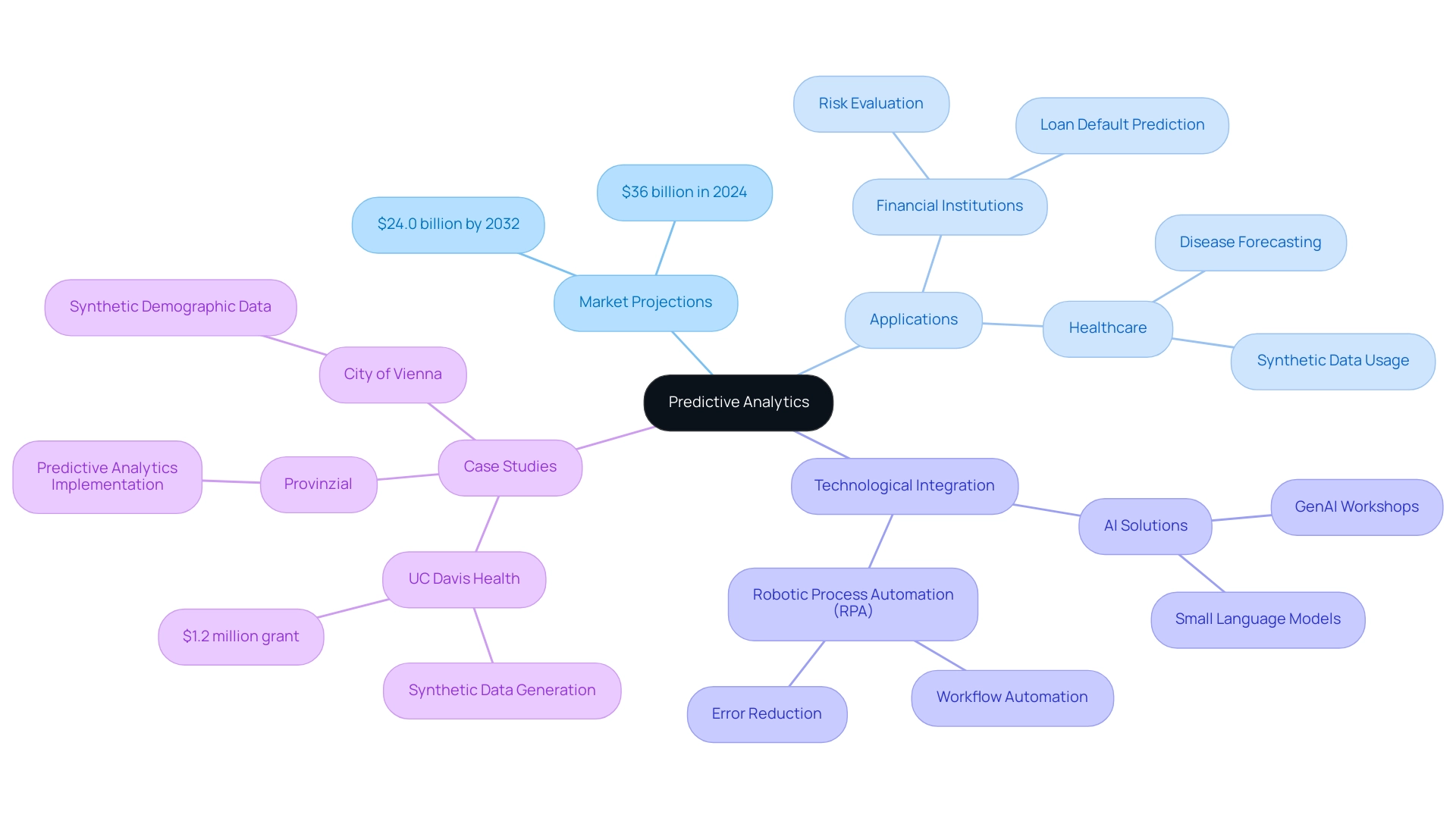
Prescriptive Analytics: What Should We Do Next?
Prescriptive analysis stands out as a transformative tool that provides actionable recommendations derived from comprehensive data examination. By synthesizing insights from various types of data analytics, including descriptive, diagnostic, and predictive data analysis, it empowers organizations to identify the best courses of action. For instance, supply chain managers can leverage prescriptive data analysis alongside Robotic Process Automation (RPA) to optimize inventory levels necessary to satisfy customer demand while simultaneously reducing costs.
This combination not only streamlines operations but also maximizes resource allocation and enhances overall productivity. Recent statistics suggest that the prescriptive data analysis market is projected to expand at a remarkable CAGR of 26% from 2024 to 2033, reflecting its growing importance in business strategies. The financial consequences of adopting prescriptive data analysis and RPA are considerable, as companies can achieve substantial cost reductions and efficiency improvements.
As organizations adopt a use case-driven approach to address quality issues, they can prioritize improvements effectively, further enhancing decision-making processes. Additionally, experts in supply chain management advocate for prescriptive analysis in conjunction with tailored AI solutions, highlighting its potential to optimize operations and drive efficiency. IBM Corporation’s recent acquisition aims to expand its software portfolio across data, artificial intelligence, and automation, showcasing the industry’s direction towards comprehensive observability.
Moreover, the case study named ‘Planning for the Electric Future‘ demonstrates how entities can employ prescriptive data analysis in supply chain transformations, especially regarding sustainability and electric vehicle adoption. The integration of the latest tools for implementing prescriptive data analysis and RPA types of data analytics is essential for organizations aiming to capitalize on emerging trends, ensuring they remain competitive in a rapidly evolving landscape. Lastly, SAP SE’s financial performance underscores the financial implications of adopting prescriptive analytics and RPA in business strategies.
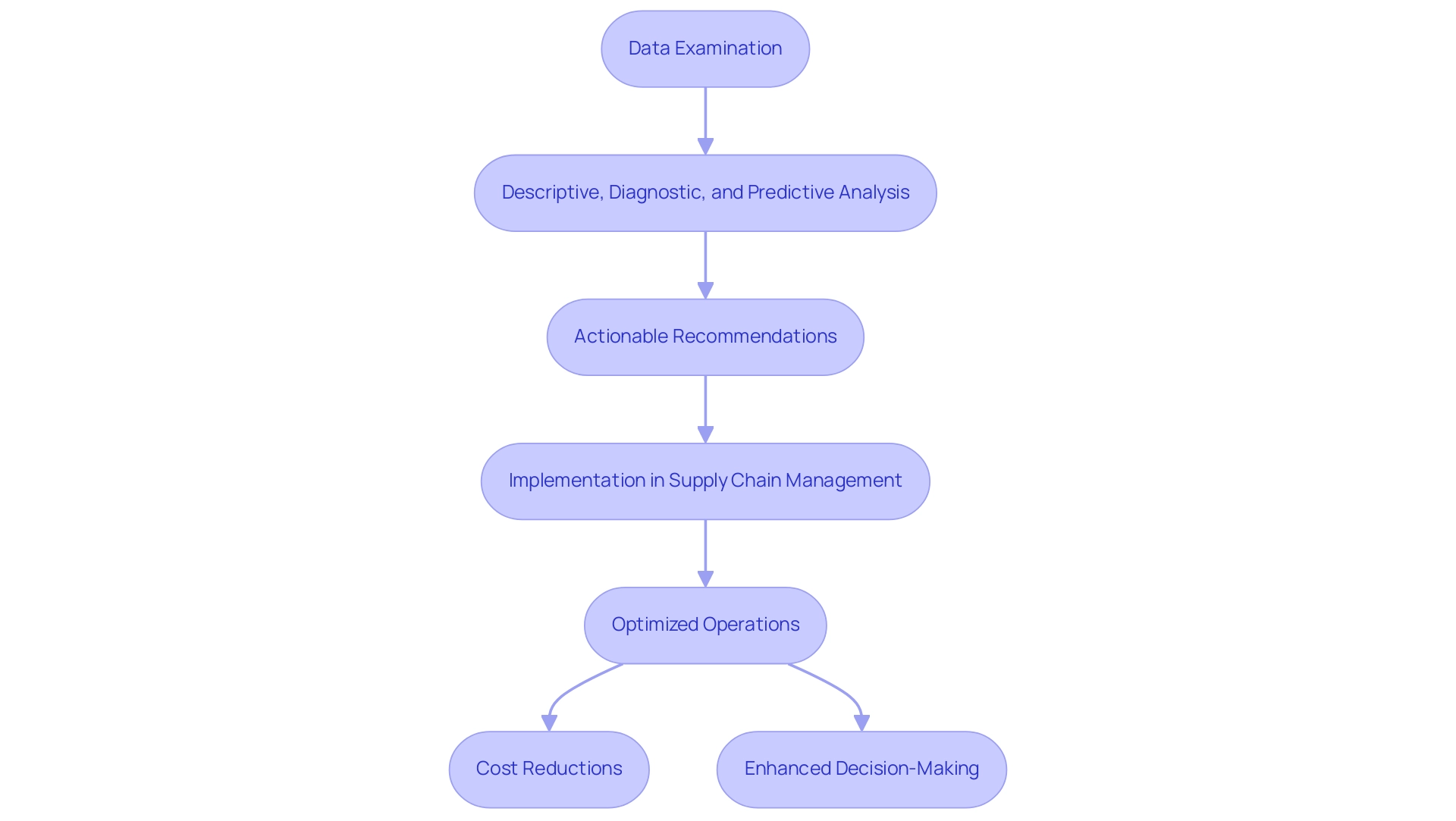
Conclusion
Embracing data analytics is no longer a luxury; it has become a necessity for organizations seeking to thrive in today’s competitive landscape. The exploration of descriptive, diagnostic, predictive, and prescriptive analytics reveals a structured approach to transforming raw data into actionable insights. Each type serves a unique purpose, enabling businesses to:
- Understand past performances
- Uncover underlying reasons for outcomes
- Forecast future trends
- Recommend strategic actions that align with organizational goals
Overcoming challenges such as data integrity and the complexities of advanced technologies like artificial intelligence is crucial for fully harnessing the power of data. Organizations that prioritize these aspects not only enhance their operational efficiency but also foster a culture of innovation and informed decision-making. Implementing robust analytics strategies can lead to significant improvements, as evidenced by successful case studies that demonstrate the tangible benefits of data-driven initiatives.
As the data landscape evolves, the integration of advanced technologies and tailored solutions will be pivotal in navigating the complexities of analytics. By leveraging these insights and embracing a comprehensive approach to data utilization, organizations can position themselves for sustained success in an increasingly data-driven world. The future belongs to those who are willing to harness the full potential of their data assets, turning challenges into opportunities for growth and excellence.
Introduction
In a world where efficiency is paramount, Robotic Process Automation (RPA) emerges as a transformative force, reshaping the landscape of business operations. As organizations grapple with the demands of repetitive tasks and the nuances of data management, RPA offers a powerful solution that not only streamlines processes but also enhances accuracy and employee satisfaction.
With the potential to drastically reduce errors and operational costs, RPA is not just a trend; it has become a cornerstone of strategic initiatives across industries from healthcare to finance. As businesses invest in this innovative technology, understanding its applications, benefits, and the challenges of implementation is crucial for navigating the future of work.
This article delves into the multifaceted world of RPA, exploring its impact on operational efficiency and uncovering the trends that will define its evolution in the years to come.
Understanding Robotic Process Automation (RPA)
Robotic Process Automation (RPA) is an innovative technology that demonstrates the uses of RPA by enabling software robots to replicate human actions in executing business processes, targeting repetitive, rule-based tasks such as data entry, transaction processing, and customer query responses. Before introducing RPA, a mid-sized healthcare firm encountered considerable difficulties such as manual data entry mistakes and sluggish software testing, which impeded overall performance. The uses of RPA in automating these processes significantly improve workflow productivity while reducing human error.
The company enhanced efficiency by mechanizing data entry and software testing through GUI processes, resulting in a 70% reduction in data entry errors and an 80% improvement in workflow efficiency. Such measurable outcomes highlight the uses of RPA to streamline workflows, reduce expenses, and elevate service delivery. As organizations progressively acknowledge the importance of RPA, significant statistics indicate that 49% of companies expect to boost their budget for automated processes in 2023, demonstrating a strong dedication to RPA as a fundamental element of digital transformation strategies.
Furthermore, Cem Dilmegani highlights that RPA experienced a remarkable growth rate of 22.1% in 2023, outpacing the broader AIM market growth rate of 13.2%. Furthermore, 83% of employees utilizing AI-driven automation think it can assist in lessening burnout and improving job satisfaction, suggesting the wider advantages of RPA beyond performance. Investment in RPA technologies is underscored by significant funding rounds, with UiPath raising $1.2 billion across six rounds and Automation Anywhere securing $840 million in four rounds.
However, challenges exist; the Deloitte Global RPA Survey found that 64% of respondents indicated that the implementation time for RPA was longer than expected. This emphasizes the essential role of RPA and the uses of RPA in improving workflow productivity and fostering organizational success, especially in sectors encountering task repetition fatigue and staffing shortages. Key features of RPA solutions, such as EMMA RPA and Microsoft Power Automate, specifically address these challenges by automating tedious tasks and improving overall employee morale.
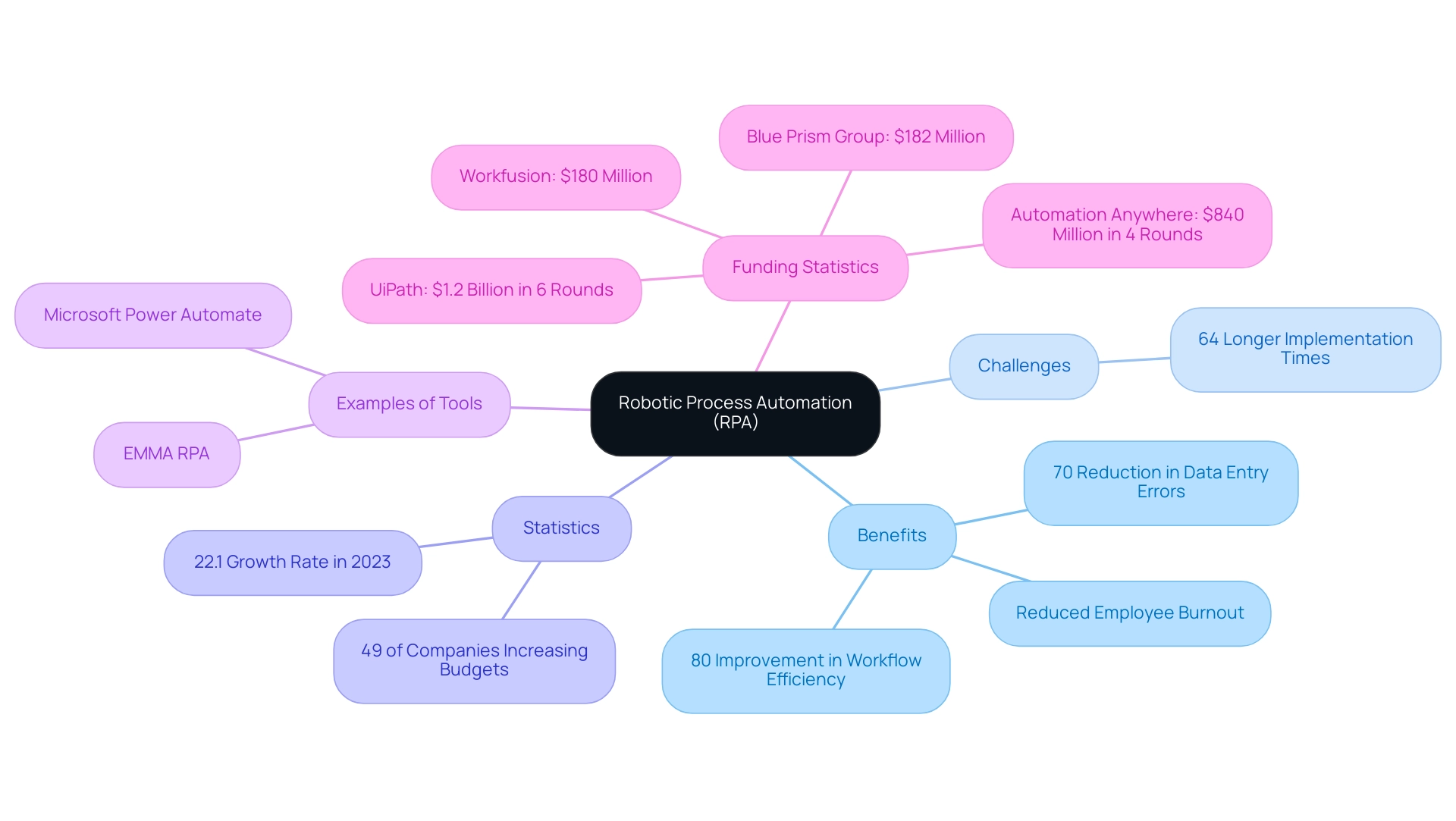
Applications of RPA Across Industries
The uses of RPA are revolutionizing operations across diverse industries, including healthcare, finance, and customer service. In the healthcare sector, the uses of RPA simplify essential processes such as:
- Patient data management
- Appointment scheduling
- Claims processing
These enhancements significantly improve both patient care and operational effectiveness. For instance, a recent report indicates that RPA can manage up to 90% of data entry tasks in clinical research, underscoring its transformative impact on workflow productivity.
Furthermore, statistics reveal that among RPA adopters, robots could contribute as much as 52% of work capacity, illustrating RPA’s substantial potential to enhance business productivity. In finance, the uses of RPA are increasingly leveraged by organizations for vital tasks like:
- Invoice processing
- Compliance reporting
- Fraud detection
These applications not only accelerate transaction times but also strengthen accuracy and compliance. Notably, 65% of respondents in Robocorp’s 2022 RPA survey expressed that they would benefit from usage-based pricing, highlighting financial considerations in RPA adoption.
Customer service departments also reap benefits from RPA’s ability to manage routine inquiries and ticketing processes, allowing human agents to focus their expertise on more complex issues. However, implementing RPA does come with challenges, including:
- Resistance to change
- The need for integration with existing systems
This strategic implementation of RPA demonstrates the uses of RPA, as it boosts productivity and elevates service quality across sectors.
A pertinent case study titled ‘Reducing Burnout with AI-Powered Solutions’ further demonstrates that 83% of employees utilizing AI-driven tools believe it significantly alleviates burnout and enhances job satisfaction. This highlights RPA’s crucial role in fostering a healthier work environment. As these trends continue to advance, it’s evident that RPA, when paired with tailored AI solutions and robust business intelligence, stands as a powerful ally for organizations striving to optimize their operations and enhance service delivery.
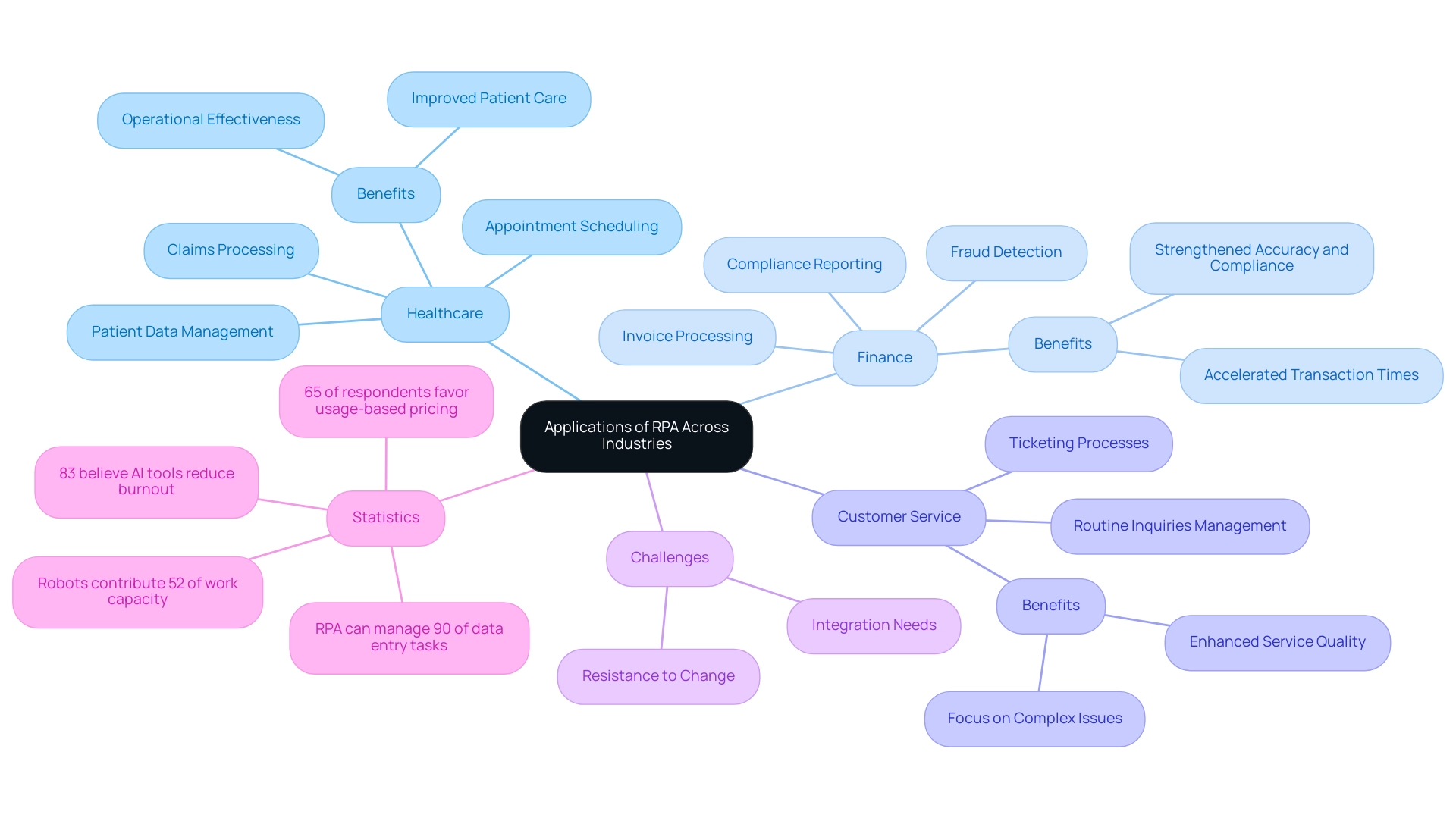
Benefits of Implementing RPA
The uses of RPA provide a transformative opportunity for organizations looking to improve their efficiency. One of the most compelling advantages is the potential for significant cost savings; recent analyses project that implementing automated systems could save £17 billion in public sector payments by 2030 compared to 2015 figures. These savings arise from decreased costs linked to manual labor, as tasks that once demanded extensive human intervention can now be managed by automated systems.
Furthermore, RPA significantly improves accuracy by minimizing errors commonly associated with data entry and processing, leading to higher quality outputs and enhanced data integrity. A case study on a mid-sized company showed that implementing graphical user interface techniques for data entry and software testing reduced errors by 70% and sped up processes by 50%, demonstrating measurable results that correspond with improving operational effectiveness. Notably, 91% of employees believe that the uses of RPA not only save time but also improve their work-life balance; 89% reported increased job satisfaction as a direct result of these uses of RPA.
The uses of RPA allow employees to shift their focus from repetitive tasks to strategic initiatives, thereby fostering a culture of productivity. Companies that have integrated RPA solutions consistently report enhanced productivity, faster turnaround times, and ultimately, improved customer satisfaction, showcasing the uses of RPA. The RPA industry is experiencing robust financial backing, with:
- UiPath raising $1.2 billion
- Automation Anywhere securing $840 million
- Blue Prism Group accumulating $182 million
- Workfusion raising $180 million
This financial backing highlights the sector’s growth potential and innovation, indicating that as RPA develops, customized AI solutions and business intelligence will become increasingly essential to maximizing performance and improving strategic decision-making. As we look toward 2024, the uses of RPA in driving accuracy and productivity will continue to be pivotal for organizations aiming to maintain a competitive edge.
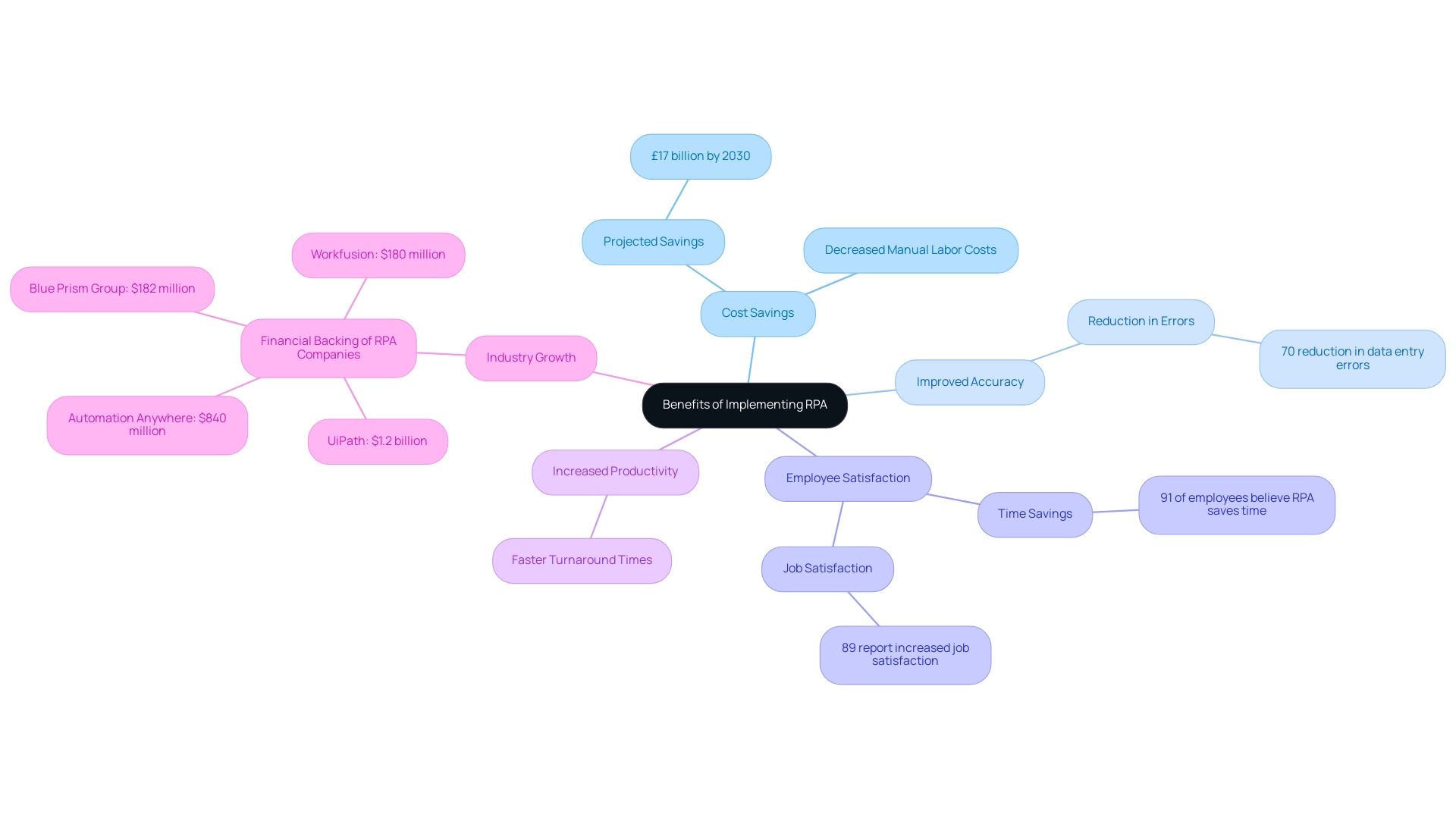
Challenges in RPA Implementation
While the advantages of Robotic Process Automation (RPA) are evident, many organizations face significant challenges during implementation. Technical issues, particularly around integrating RPA with existing systems and ensuring data quality, can complicate the rollout. Additionally, employee resistance often arises from fears of job displacement and reluctance to embrace new technologies, creating substantial barriers to successful adoption.
Furthermore, attracting and retaining personnel in operational roles has become increasingly challenging, adding another layer of complexity to RPA implementation. To effectively navigate these obstacles, organizations must implement a robust change management strategy. This encompasses:
- Clear communication that expresses the uses of RPA, including enhancing efficiency and minimizing errors
- Thorough training programs to prepare employees with the essential skills to collaborate with automated tools
Moreover, the emergence of low-code RPA platforms democratizes processes, enabling non-technical business users to design workflows with minimal coding skills, thus making RPA more accessible. As industry bodies establish standards for RPA implementations, these initiatives foster best practices, enhance security, and help mitigate implementation challenges. Addressing these challenges is not just necessary but a crucial step toward unlocking the uses of RPA’s full potential, allowing organizations to thrive in an increasingly automated landscape.
The substantial investments in RPA technologies—such as Workfusion’s $180 million secured through six funding rounds, and Blue Prism Group’s $182 million from five rounds—underscore the momentum behind RPA, highlighting the importance for businesses to overcome initial resistance and fully leverage these innovative solutions.
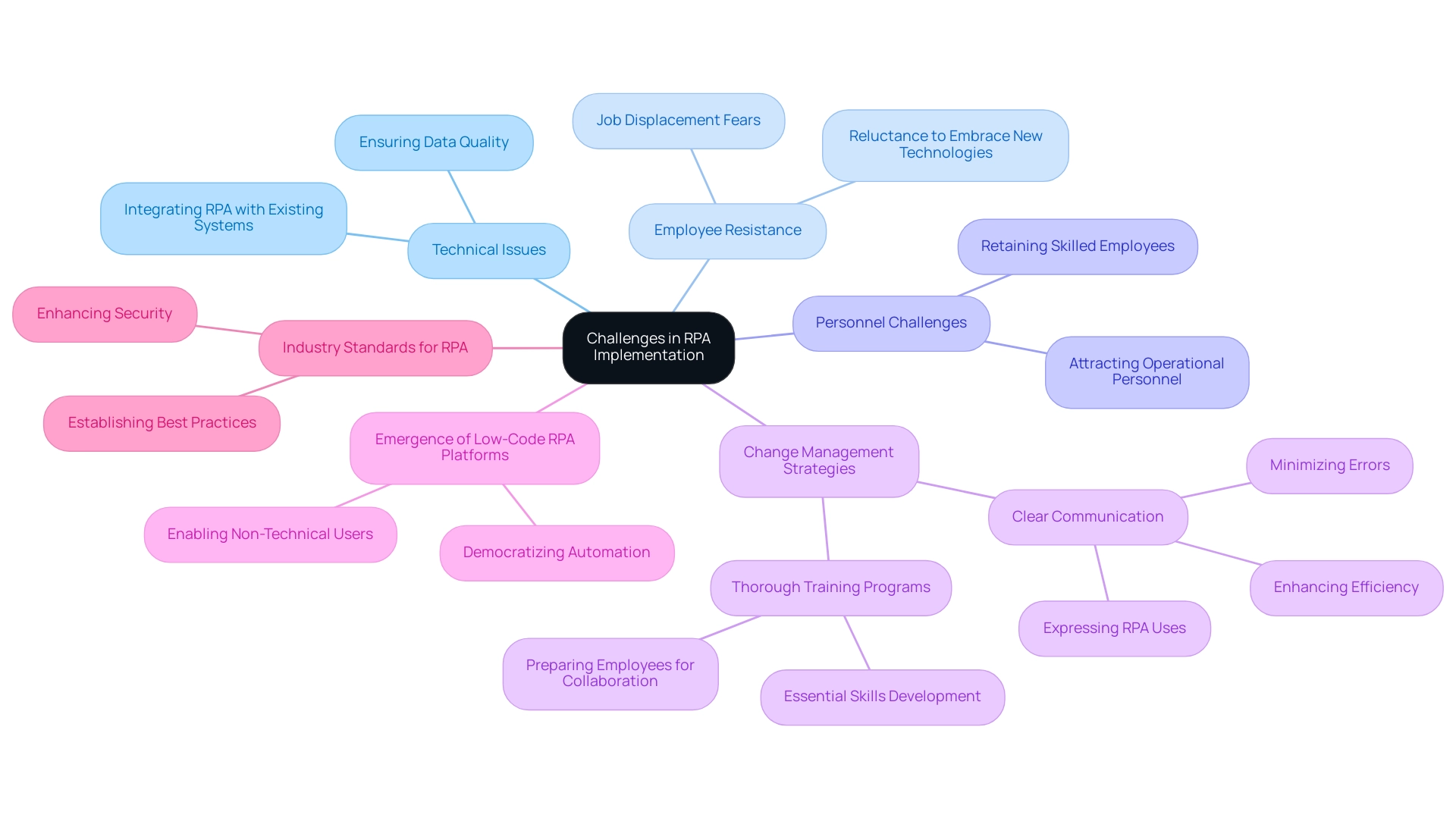
The Future of RPA: Trends and Innovations
The trajectory of Robotic Process Management (RPA) is poised for remarkable evolution, propelled by cutting-edge trends such as intelligent processes, machine learning, and the integration of advanced technologies like artificial intelligence (AI) and the Internet of Things (IoT). This convergence not only tackles shared challenges like inadequate master data quality and the uncertainties regarding AI adoption, including the belief that AI projects are time-consuming and expensive, but also enables organizations to improve their performance. The uses of RPA represent a fundamental transformation in how businesses operate by enabling software robots to tackle increasingly complex tasks that demand decision-making and the ability to learn from data patterns.
Organizations can start by identifying repetitive tasks that consume significant time and resources and gradually implement RPA solutions, exploring various uses of RPA to automate these processes. Notably, the uses of RPA could enable robots to take over an average of 20% of human work capacity, illustrating the significant impact on workforce dynamics. Furthermore, a substantial 89% of employees report heightened job satisfaction linked to technological advancements, underscoring its positive influence on workplace morale.
As organizations strive for enhanced efficiency and innovation, the future of RPA will showcase various uses of RPA through increasingly sophisticated automated solutions that redefine operational processes. Industry bodies are actively working to establish standards for RPA implementations, ensuring best practices, interoperability, and security. These efforts aim to create a reliable and scalable RPA ecosystem, empowering businesses to harness these advancements effectively.
Additionally, a quote from Slack emphasizes that, on average, workers save 3.6 hours per week by utilizing automation, which showcases the uses of RPA and the benefits it can deliver. Staying informed about these emerging trends is crucial for organizations looking to thrive in an increasingly automated landscape.
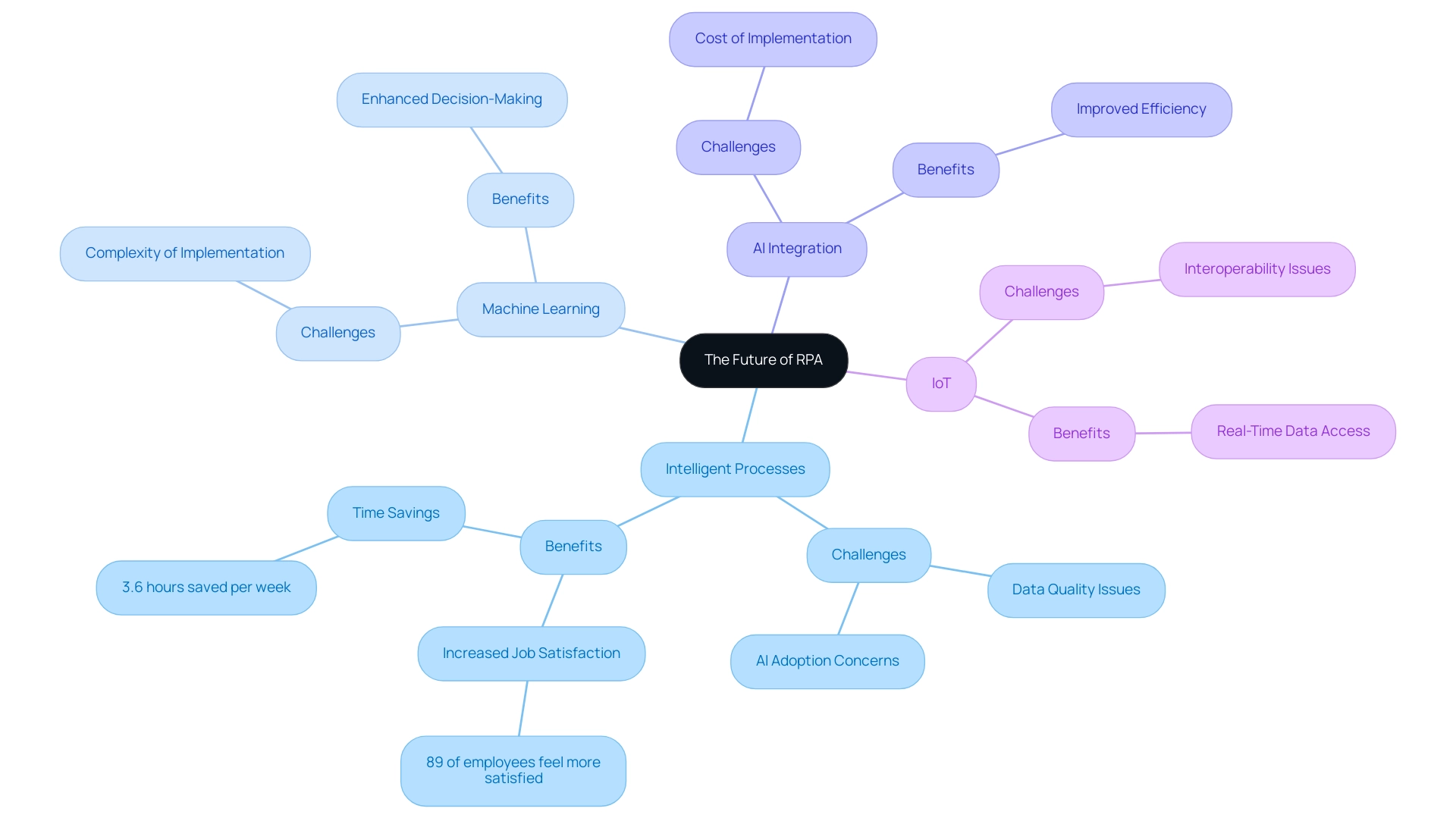
Conclusion
Robotic Process Automation (RPA) is undeniably a game changer for businesses striving to improve operational efficiency. By automating repetitive and rule-based tasks, organizations can significantly reduce errors, enhance accuracy, and ultimately lower operational costs. The statistics speak volumes:
- A mid-sized healthcare company achieved a remarkable 70% reduction in data entry errors.
- An 80% improvement in workflow efficiency through RPA.
As industries continue to embrace this transformative technology, the anticipated increase in automation budgets highlights a growing recognition of RPA’s critical role in digital transformation strategies.
The applications of RPA span across various sectors, including healthcare and finance, where it optimizes processes from patient data management to invoice processing. The benefits extend beyond mere efficiency; employees report enhanced job satisfaction and reduced burnout as RPA allows them to focus on more strategic tasks. However, the journey towards effective RPA implementation is not without its challenges. Organizations must address:
- Integration issues
- Employee resistance
- The need for robust change management strategies
to fully realize the potential of automation.
Looking ahead, the future of RPA is bright, driven by innovations in intelligent automation and machine learning. As organizations navigate these advancements, it is crucial to remain proactive in identifying processes ripe for automation and to foster a culture that embraces change. By doing so, businesses can harness RPA’s capabilities to not only enhance operational efficiency but also to create a more engaged and satisfied workforce. In an era where efficiency is paramount, RPA stands as a powerful ally for organizations seeking to thrive in an increasingly automated landscape.
Introduction
In the rapidly evolving landscape of artificial intelligence, Large Language Models (LLMs) stand out as a transformative force, poised to revolutionize operations across various sectors. These sophisticated models, built on advanced neural networks, excel in understanding and generating human-like text, making them invaluable for businesses seeking to enhance efficiency and creativity.
From automating content creation to powering intelligent chatbots, LLMs offer practical solutions that address common challenges such as poor data quality and implementation hurdles. As organizations increasingly embrace these technologies, understanding their capabilities and limitations becomes essential.
This article delves into the multifaceted applications of LLMs, their training methodologies, and the future potential they hold for driving operational excellence in an ever-changing digital environment.
Understanding Large Language Models (LLMs)
Large Language Models represent a monumental leap in artificial intelligence, meticulously designed to understand and generate human-like text. Grounded in advanced neural network architectures, particularly transformer models, these technologies enable effective analysis and interpretation of extensive textual information. By learning from a varied array of sources, large language models not only recognize complex patterns and contextual hints but also tackle common issues related to AI adoption in businesses, such as inadequate master information quality and implementation difficulties.
Poor master data quality can hinder the effectiveness of AI initiatives, leading to inaccurate insights and decision-making. Their versatility highlights what large language models are good at, making them indispensable across various applications—ranging from enhancing customer engagement via chatbots to producing compelling website content. In fact, 30% of business owners anticipate that AI will produce website text, showcasing what large language models are good at in business environments.
Additionally, a case study titled ‘Importance of Large Language Models in AI Technologies’ demonstrates how large language models serve as foundational models for numerous AI solutions, enabling machines to comprehend and generate human language more naturally. This evolution not only enhances operational efficiency but also nurtures creativity in communication, crucial for businesses navigating a dynamic digital landscape. Furthermore, in conjunction with Robotic Process Automation (RPA), organizations can automate manual workflows and significantly boost productivity.
For instance, a company that implemented RPA to manage invoice processing reduced processing time by 75%, allowing teams to focus on strategic, value-driven tasks while making informed decisions powered by Business Intelligence. As we look ahead, projections indicate that the AI sector could consume between 85 to 134 Terawatt hours annually by 2027, underscoring the significant implications of large language models and the broader AI industry for future business growth.
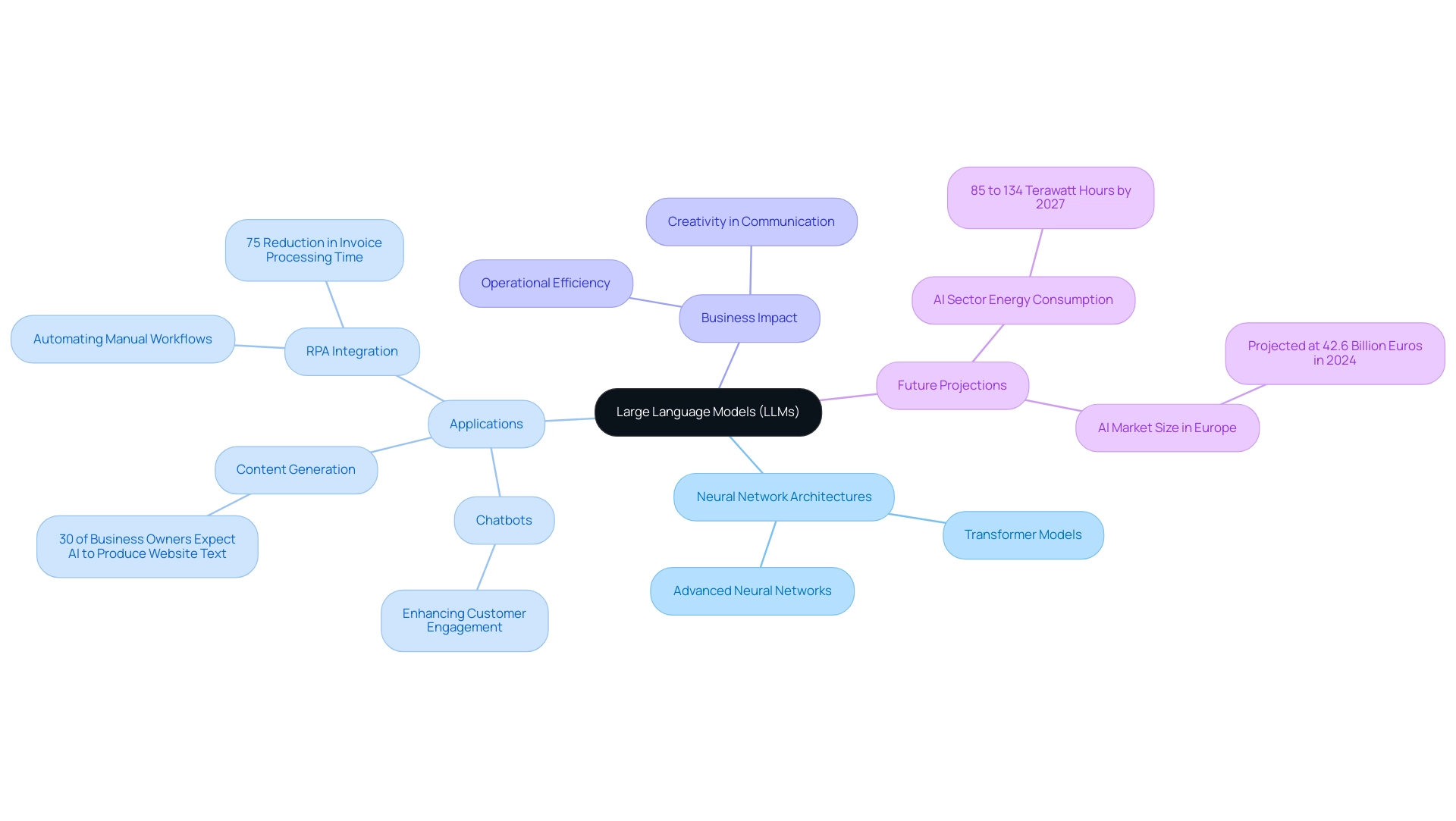
Practical Applications of LLMs in Various Domains
Large language models are proving to be transformative across several key domains, enhancing operational efficiency and productivity, which raises the question of what are LLMs good at, especially when integrated with innovative solutions such as Robotic Process Automation (RPA). Their applications include:
-
Content Creation: Large language models automate the generation of blog posts, articles, and marketing copy. This automation enables writers to redirect their efforts towards strategic thinking and creative processes, thereby enriching the overall content strategy.
-
Data Analysis: By quickly summarizing extensive datasets and extracting meaningful insights, large language models showcase what are LLMs good at in facilitating informed decision-making. This capability, when combined with customized AI solutions, is essential for entities aiming to stay agile in fast-paced environments.
-
Customer Support: What are LLMs good at? They enable advanced chatbots that provide instant replies to customer inquiries, significantly enhancing customer satisfaction while reducing the workload on human agents. This efficiency is vital in an era where responsiveness can define competitive advantage. A recent study indicates that 65% of surveyed individuals trust businesses that effectively utilize AI technology, reflecting a growing acceptance of such innovations. However, trust in AI varies significantly across countries; for instance, only 35% of Americans believe AI products offer more benefits than drawbacks, compared to 78% in China. This emphasizes a considerable gap in trust regarding AI, which entities must take into account in their operational strategies.
-
Education: In the educational field, what are LLMs good at includes aiding in personalized tutoring and the development of customized learning materials, thereby meeting individual educational needs. This application highlights the potential of large language models to improve educational accessibility and effectiveness.
These applications not only showcase what large language models are good at, but also highlight their ability to streamline workflows and boost productivity across various fields. When integrated with RPA solutions like EMMA RPA and Microsoft Power Automate, which specifically address task repetition fatigue and staffing shortages, the potential for operational efficiency is further amplified. A Stanford University study estimates that AI could augment sector productivity by 2% of annual revenue, translating to an impressive $400 billion to $660 billion, primarily through the automation of repetitive tasks.
Additionally, it’s important to note that 31% of U.S. adults have a low level of AI awareness, which could impact how organizations approach the integration of AI technologies. Furthermore, AI usage statistics show minimal gender differences, with males slightly more likely to use email spam filters and virtual assistants. As such, the integration of large language models in operations, alongside RPA tools, represents a significant step toward achieving efficiency and innovation, particularly in light of varying levels of trust in AI across different demographics.
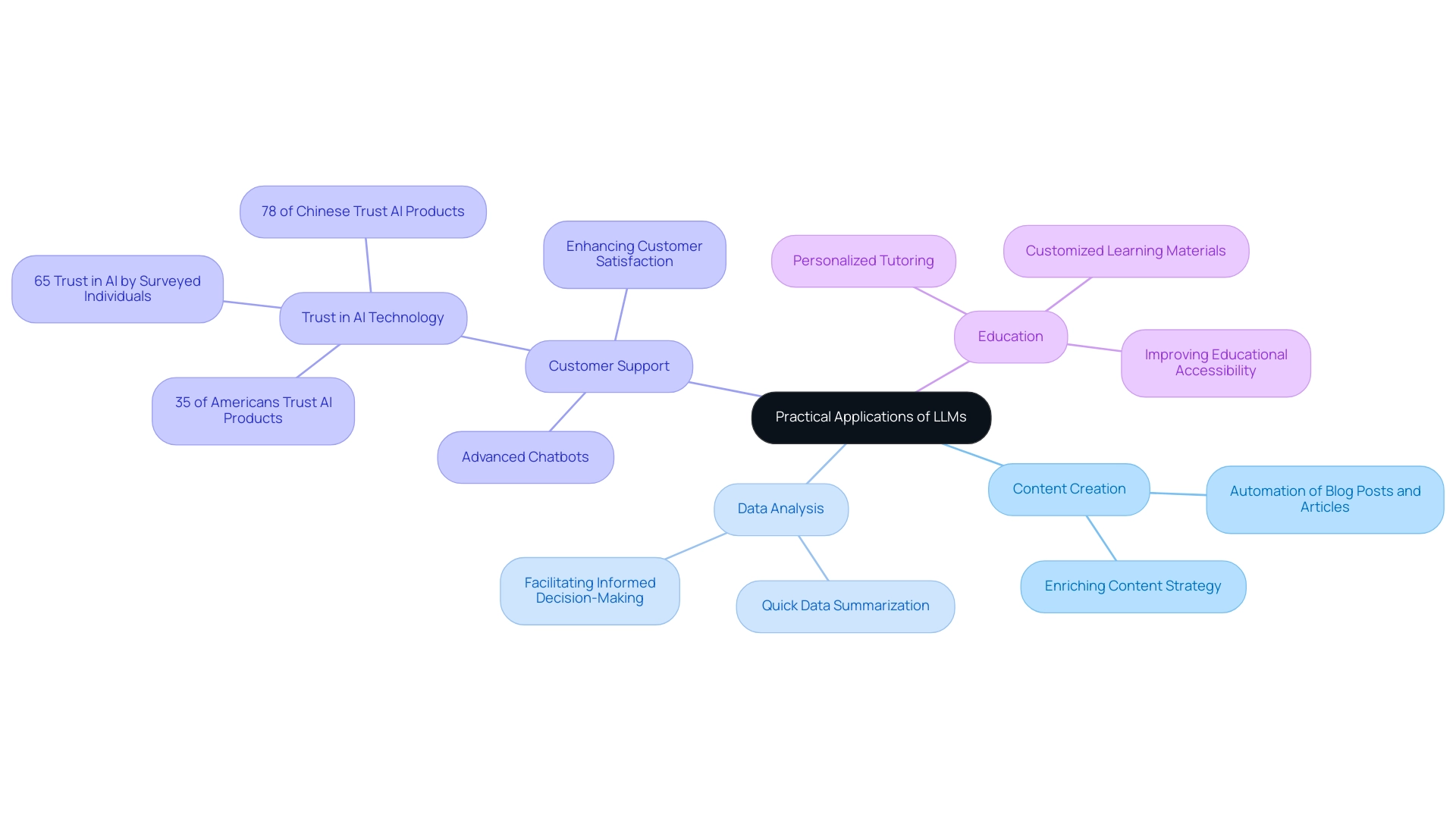
How LLMs Are Trained and Fine-Tuned
Large Language Models undergo a rigorous training process utilizing extensive datasets that encompass a diverse range of text sources, including books, websites, and other written materials. This training is divided into two critical phases: pre-training and fine-tuning. In the pre-training phase, models learn to predict subsequent words in sentences, which equips them with a foundational understanding of language.
This general knowledge is further refined during the fine-tuning phase, where models are adjusted on specialized datasets tailored for specific tasks, such as sentiment analysis or translation. This strategic dual-phase approach not only ensures that large language models are broadly knowledgeable but also clarifies what are LLMs good at by allowing them to adapt effectively to meet the unique demands of various applications. For instance, the recent advancements in Llama 3, which boasts four times the code information of its predecessor and includes over 5% high-quality non-English content across more than 30 languages, exemplify the progress in training methodologies.
Such enhancements are vital for organizations looking to leverage large language models in ways that align with their operational goals, particularly in sectors like banking and financial services where AI plays a crucial role in tasks such as fraud detection and customer service. As businesses face challenges from manual, repetitive tasks that can slow down operations and waste resources, leveraging Robotic Process Automation (RPA) in conjunction with Business Intelligence can streamline workflows and enhance operational efficiency. Business Intelligence can transform raw data into actionable insights, enabling informed decision-making that drives growth.
A case study titled ‘Exploring and Improving Consistency in Large Language Models for Multiple-Choice Question Assessment’ highlights efforts to enhance the reliability of large language models in educational settings, demonstrating what are LLMs good at in showcasing their versatility. As these models continue to grow in power, the responsibility of researchers and organizations to address ethical considerations and ensure effective deployment becomes increasingly significant. As Tajammul Pangarkar, CMO at Prudour Pvt Ltd, notes, ‘When he’s not ruminating about various happenings in the tech world, he can usually be found indulging in his next favorite interest – table tennis.’
This viewpoint highlights the significance of balancing innovation with ethical responsibility in the development and use of large language models.
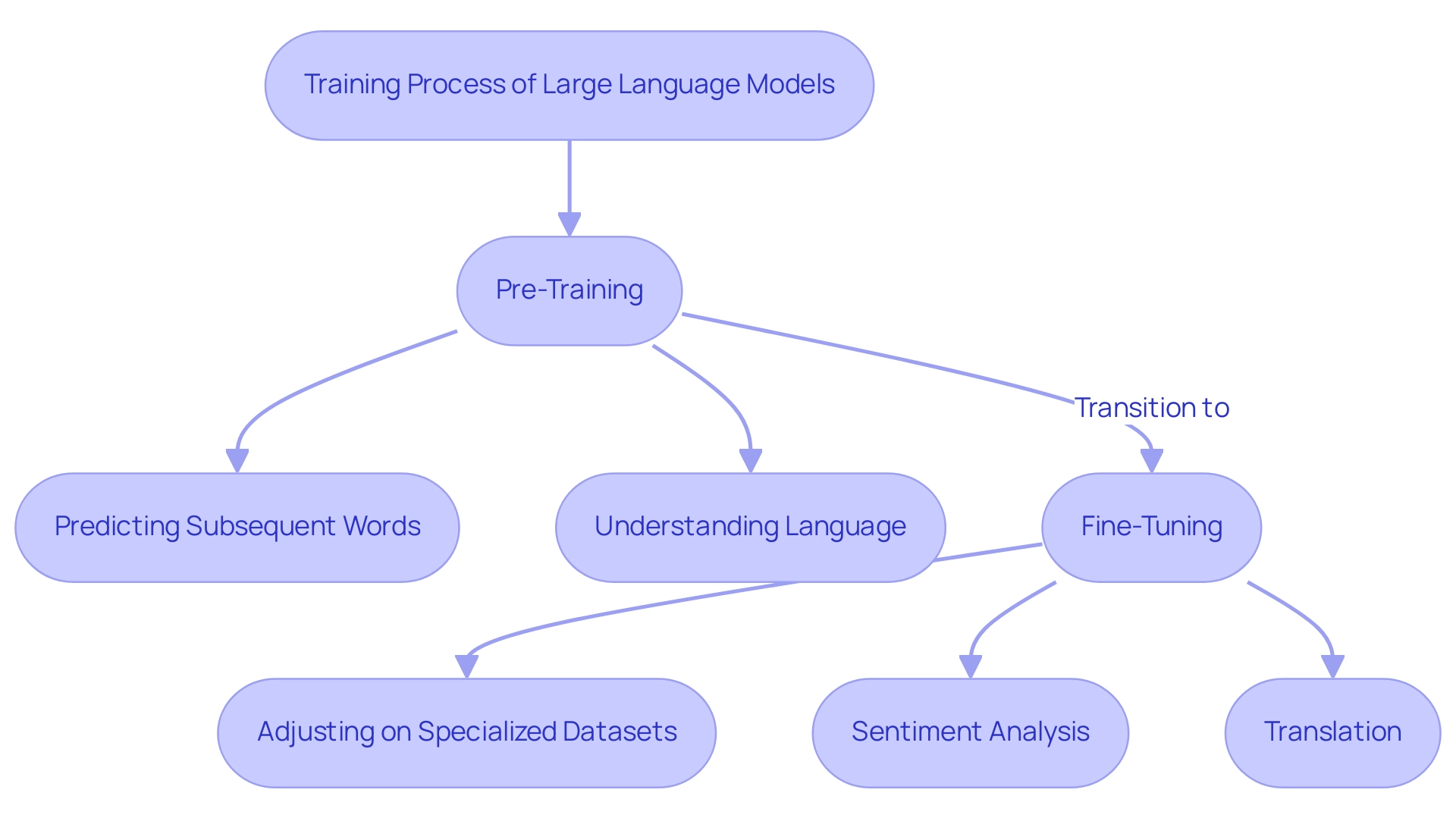
Advantages and Limitations of LLMs
The benefits of large language models are significant and multifaceted:
- Efficiency: By automating repetitive tasks through Robotic Process Automation (RPA), these models can dramatically save time and resources, allowing teams to focus on more strategic initiatives and enhancing overall operational efficiency.
- Scalability: These systems possess the capability to process vast amounts of information and manage numerous requests simultaneously, making them ideal for high-demand environments, especially when evaluating what are LLMS good at in conjunction with tailored AI solutions that align with specific business goals.
- Versatility: What are LLMS good at? They can be customized for a wide range of applications across various domains, enhancing their utility in diverse operational contexts, especially when integrated with Business Intelligence tools to transform raw information into actionable insights.
However, it is crucial to recognize the limitations that accompany large language models:
- Bias: One persistent issue is that these systems can inadvertently perpetuate biases inherent in their training information. For instance, a political text classifier may exhibit bias towards the prevailing ideology of its training region, misclassifying texts that support less dominant political views. This concern is underscored by the findings of a study which revealed that texts promoting socialist policies were classified as ‘radical’ in regions where such views are less accepted. This illustrates the broader challenge of regional bias, as a model trained predominantly on American English might incorrectly assess the similarity between ‘I live in an apartment’ and ‘I live in a flat’ as low due to not recognizing the regional synonymy.
- Context Limitations: Large language models often struggle with nuances in context and may lack the specific domain knowledge necessary for accurate comprehension. As noted by Blodgett et al., a reading comprehension model may find it challenging to interpret regional dialects or non-standard language varieties, leading to misunderstandings. This underscores the significance of acknowledging the linguistic variety present in the data utilized for training, which can be tackled through customized AI solutions.
- Resource Intensive: The training and implementation of large language models require considerable computational resources, which can be an obstacle for certain entities, especially those aiming to improve efficiency through RPA and other automation strategies. This resource intensity emphasizes the necessity for organizations to thoroughly assess their capabilities and infrastructure prior to execution. Understanding what large language models are good at is essential for organizations contemplating their adoption, as they navigate both the significant benefits and the inherent challenges that accompany these advanced technologies. Furthermore, RPA can help mitigate some of these limitations by automating processes that require human judgment, thus reducing the impact of biases and enhancing contextual understanding.
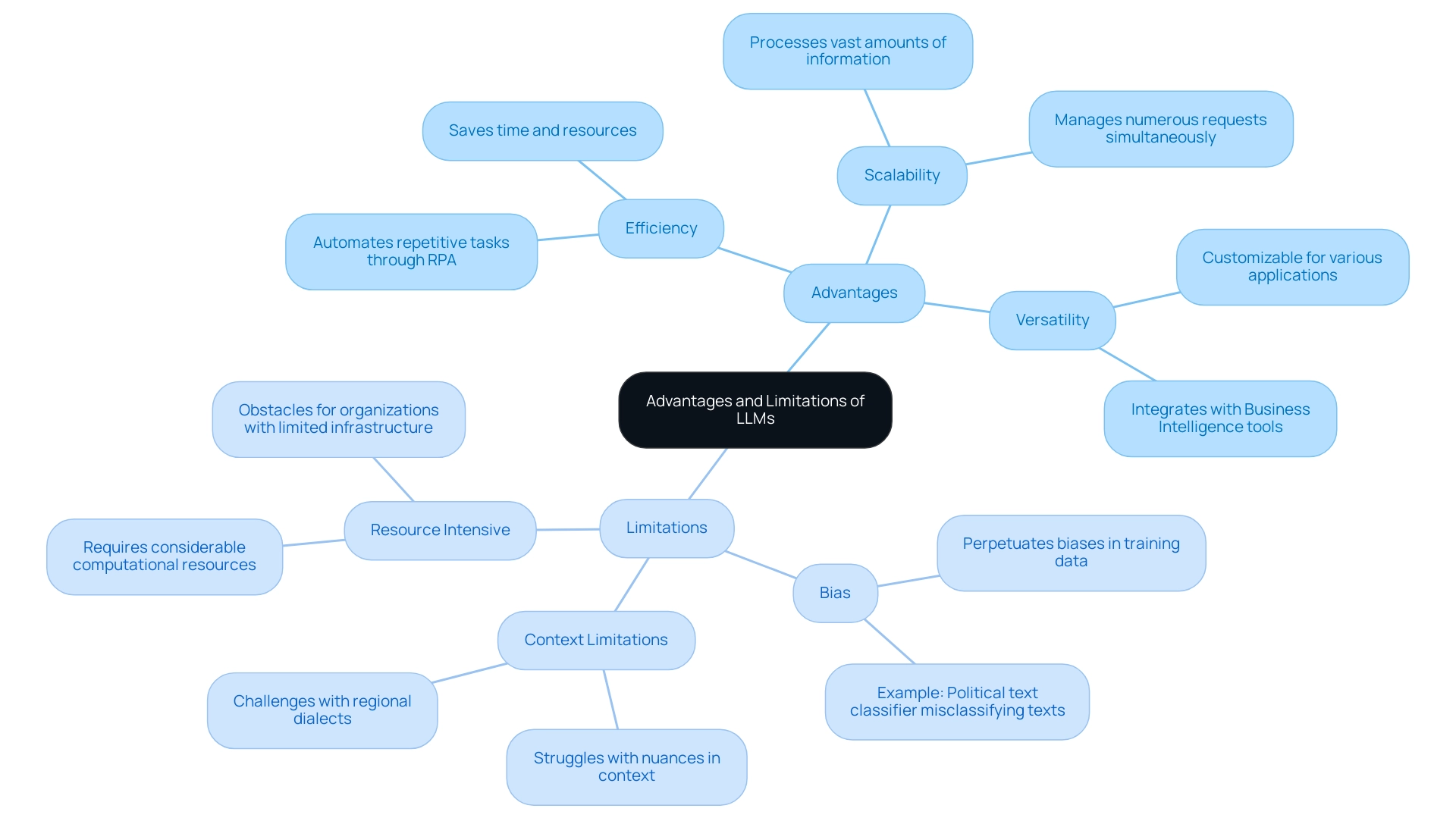
The Future of Large Language Models
The trajectory of Large Language Models is set to witness remarkable advancements, particularly in the realm of few-shot learning. This innovative approach enables LLMs to learn effectively from limited examples, significantly enhancing their adaptability across various applications. For instance, Meta’s Llama 3 boasts an impressive 405 billion parameters, showcasing the scale of advancements in LLM technology.
However, many entities face challenges like inadequate master information quality, resulting in AI implementation stagnation, as inconsistent or erroneous information can obstruct efficient operations and decision-making. To combat these issues, leveraging tailored AI solutions alongside Robotic Process Automation (RPA) can streamline manual workflows, enhance operational efficiency, and allow teams to focus on strategic tasks. Business Intelligence also plays a crucial role in transforming raw information into actionable insights, enabling informed decision-making that drives growth.
Ongoing research is prioritizing the refinement of bias mitigation techniques, a critical aspect given the ethical concerns surrounding AI. According to Google’s DeepMind, ‘our AI Ethics and Society team focuses on mitigating biases in AI systems and improving fairness.’ As organizations increasingly incorporate large language models into their operations, the demand for user-friendly interfaces tailored to specific industries will likely rise.
Nevertheless, it is essential to acknowledge the challenges faced by large language model technology; for instance, these models currently show only 22% accuracy when processing real business data, which drops to zero for mid and expert-level requests. This underscores the necessity for further improvements in LLM technology. The evolution of LLMs not only promises to enhance operational efficiency but also helps businesses understand what are LLMs good at, thereby navigating the complexities of generative AI effectively while addressing the challenges posed by current technologies.
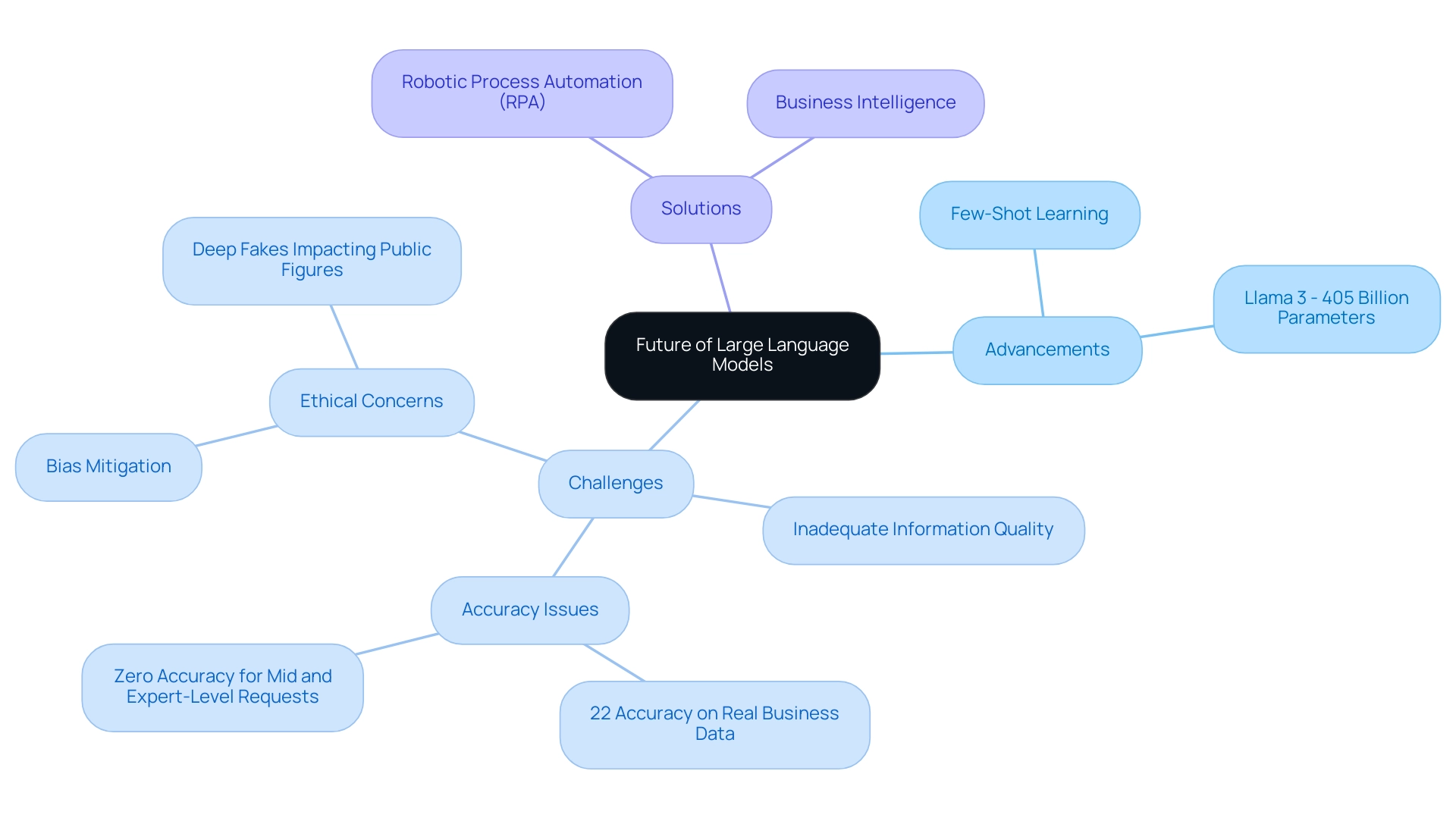
Conclusion
The transformative potential of Large Language Models (LLMs) is clear, as they streamline operations and enhance productivity across various sectors. By automating content creation, facilitating data analysis, and powering advanced customer support systems, LLMs empower organizations to focus on strategic initiatives rather than repetitive tasks. Their integration with Robotic Process Automation (RPA) further amplifies efficiency, enabling businesses to respond swiftly to challenges and maintain a competitive edge.
While the advantages of LLMs are substantial, it is important to remain cognizant of their limitations, including biases and contextual challenges. Organizations must invest in high-quality data and tailored AI solutions to mitigate these issues. As LLM technology continues to evolve, the focus on ethical deployment and bias reduction will be paramount, ensuring that these powerful tools are utilized responsibly and effectively.
Looking ahead, the future of LLMs promises exciting developments, particularly in adaptability and user-friendliness. By embracing these advancements and addressing the inherent challenges, businesses can unlock the full potential of LLMs, driving operational excellence in an increasingly digital landscape. The journey toward leveraging LLMs is not merely about adopting new technologies; it is about transforming the way organizations operate, innovate, and connect with their audiences.
